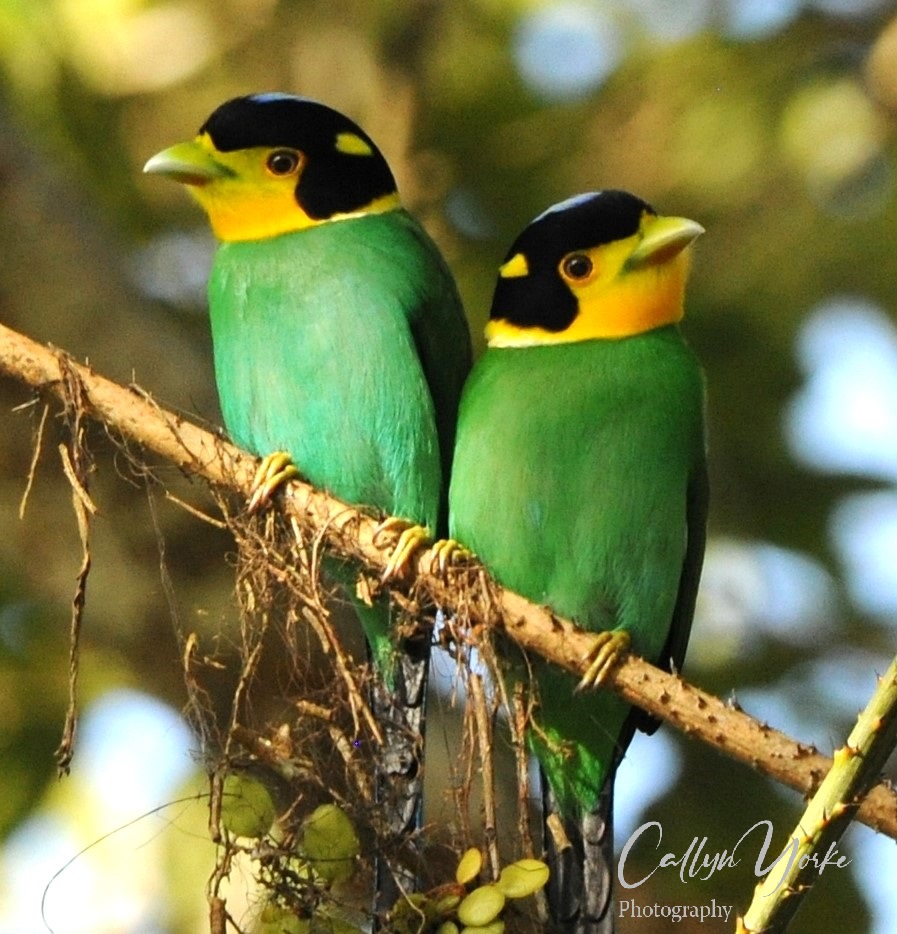
Bangkok (Krung Thep Maha Nakhon) and Khao Yai, Nakhon Nayok-Ratchasima Provinces, Thailand, Bird Report: 30 December 2022 – 11 January 2023 Callyn Yorke
Scroll down for Annotated Bird LIsts
Introduction
There are few birding locations in the world that would be better than Thailand for starting the new year. The most recent count for the national bird list comes in at 1,093 species. I’m fairly certain no one has seen all of those birds, though there may be thousands of birders who are trying their best to do so.
Nearly everywhere I went birding in Thailand, I met others doing the same. They are easy to spot – the only folks in the vicinity wearing binoculars, optical instruments that seem to include a magnetic field of sociability. Sharing findings with other birders, was a way to find familiar ground in this enchantingly exotic and unique country. Whether you are a beginner or expert, alone or with a tour group, birding in Thailand is awesome.
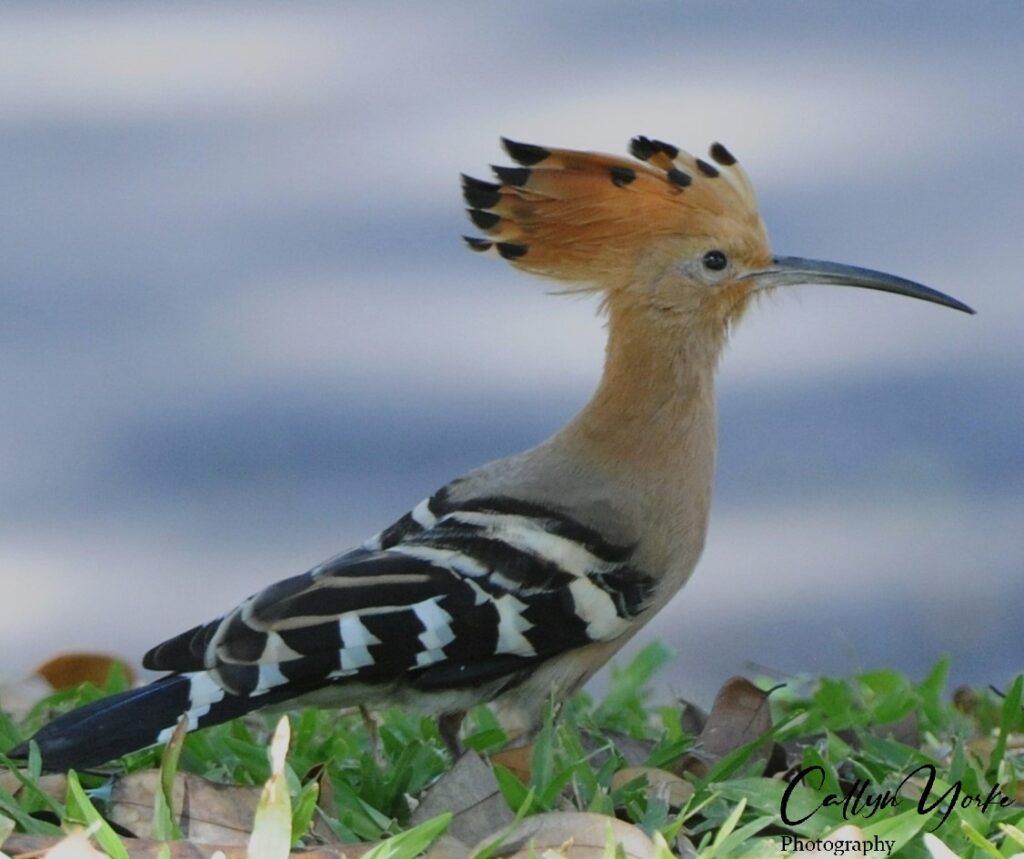
Naturally, Thailand has attracted the likes of some of the keenest birders in Southeast Asia, including quite a few ex-pats from Europe, Australia and America. One of them, Dave Sargeant, of Chiang Mai, was very helpful and enthusiastic when reviewing photos of some birds who’s identities were in question, e.g. swifts and leaf-warblers. In some cases, we simply couldn’t be certain of the bird’s specific identity. Most of the time, Dave knew exactly what bird I had photographed and quickly responded to my inquiry. My birding experience in Thailand was significantly enhanced by our email exchanges, allowing me to immediately improve the accuracy of my bird identifications and reliability of my published findings.
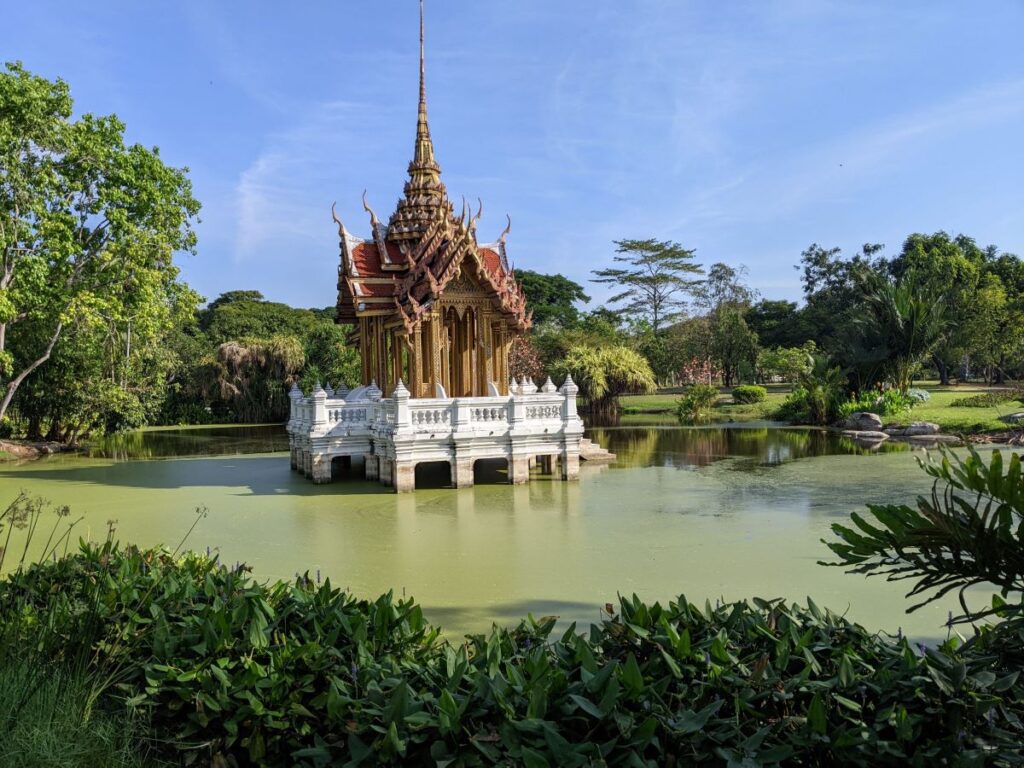
My Thailand journey began as most do, in Bangkok. I selected the same hotel where I had stayed during previous visits (King’s Park Avenue: a clean, well managed, 3-star hotel, $US 36/night), located about 2 km west of Suan Luang Rama IX (‘King’s Park‘- see map below).
King’s Park is the largest city park in Bangkok (80 ha – established by the former King of Thailand on his 60th birthday in 1987). There are abundant water features (lakes, ponds, canals and marsh), lawns, botanical gardens with flowering-fruiting shrubs and trees (mostly exotic), many of which are attractive to a great variety of birds (About 170 species have been documented for the park by multiple birders, reporting on the Cornell University eBird website). In addition to being a magnet for birds and birders, King’s Park is wildly popular with early-morning joggers and mid-day picnickers, especially on weekends and holidays. Birds appear mostly unruffled by all the noise and recreational activities; they continue their foraging and reproductive routines in close proximity with people. Consequently, photo opportunities in King’s Park are among the best I have experienced in the region.
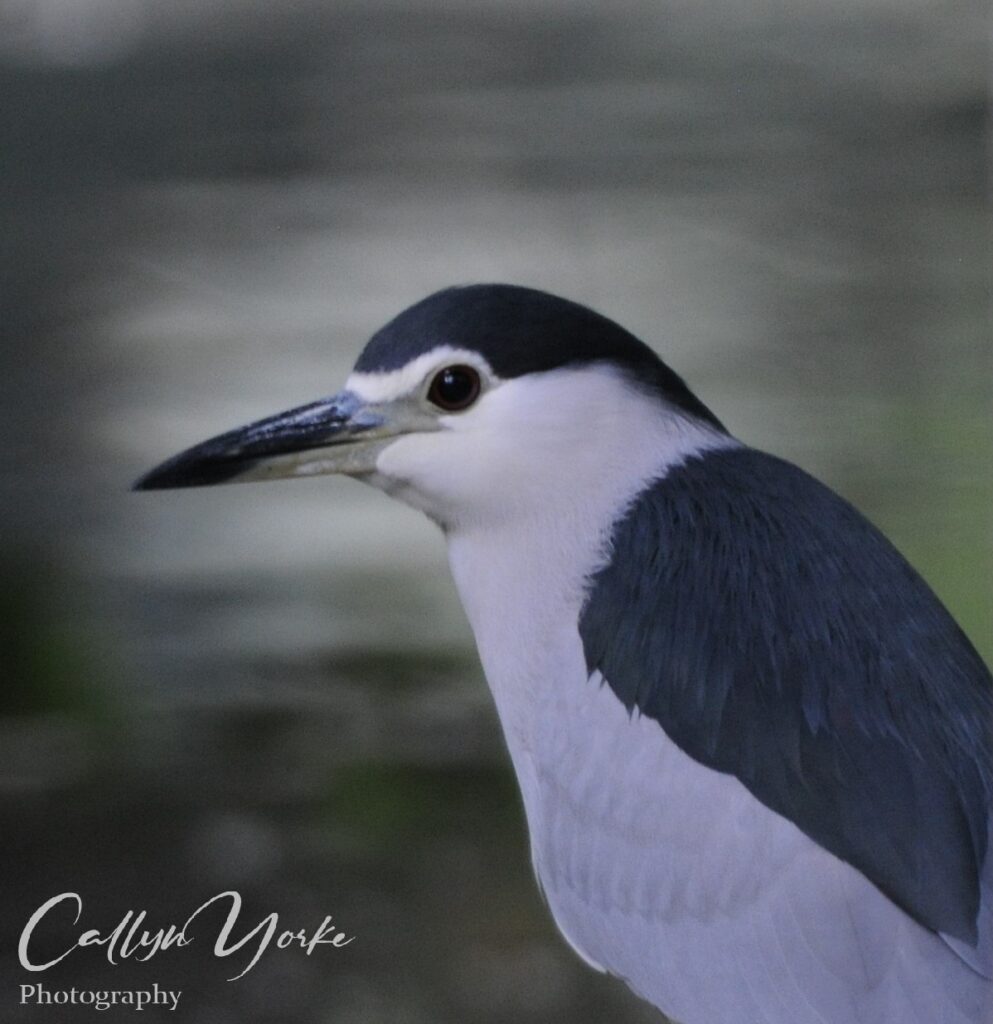
There is an interesting menagerie of animals in King’s Park, including Water Monitor Lizard (some nearly as large as a half-grown Komodo Dragon), Northern Treeshrew and Finlayson’s Squirrel.
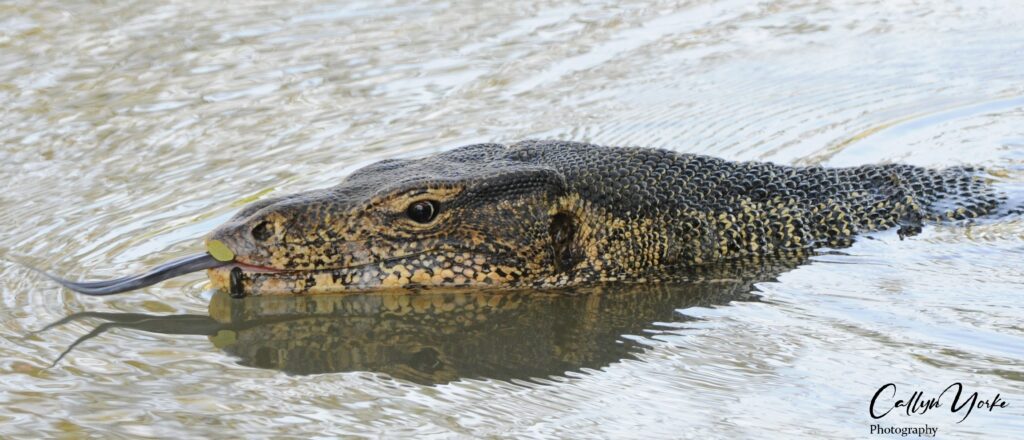
Contrary to the common name, treeshrews in the park appear to spend more time on the ground than in trees. Almost comically, the one treeshrew that I got close enough to photograph, was resting on the pavement, after having lost to a neighbor a fast and furious merry-go-round- territorial dispute.

Finlayson’s Squirrel, also known as the Variable Squirrel, is common in the park as well. It is easily the most abundant and widespread squirrel in Southeast Asia. Their fur color varies geographically: some populations are charcoal-black; most common are the rufous-gray-and-white variants; a precious few, uniform creamy–white , e.g. a rare population of white (leucistic) squirrels occurred at the Atta Lakeside-Kirimaya Resort, the next destination for me, following Kings Park, Bangkok. I’ll return to sum up the King’s Park introduction and birding results (see below). But first, let’s continue with the Finlayson’s squirrel story, as it unfolded a few days later in the journey.
When the taxi from Bangkok approached the tree-lined entrance of the Atta Lakeside-Krimaya resort in Khao Yai, a flash of white caught my eye. What in the world was that? A white squirrel? No way. That tantalizing, drive-by glance, was my first encounter with the stunningly, all-white Finlayson’s Squirrel.
I soon discovered that there was at least a dozen or so of these apparitional rodents in the trees around the resort. In fact, Jethro, I’m here to tell y’all every last one of them critters was pure, creamy-white. Unreal. What about Darwinian natural selection? Where were the predators? On vacation at another resort? These squirrels were so invariably mismatched to the green-brown arboreal background, they appeared to be victims of a genetics experiment gone crazily wrong; now running around everywhere, like lab rats liberated on a college campus.
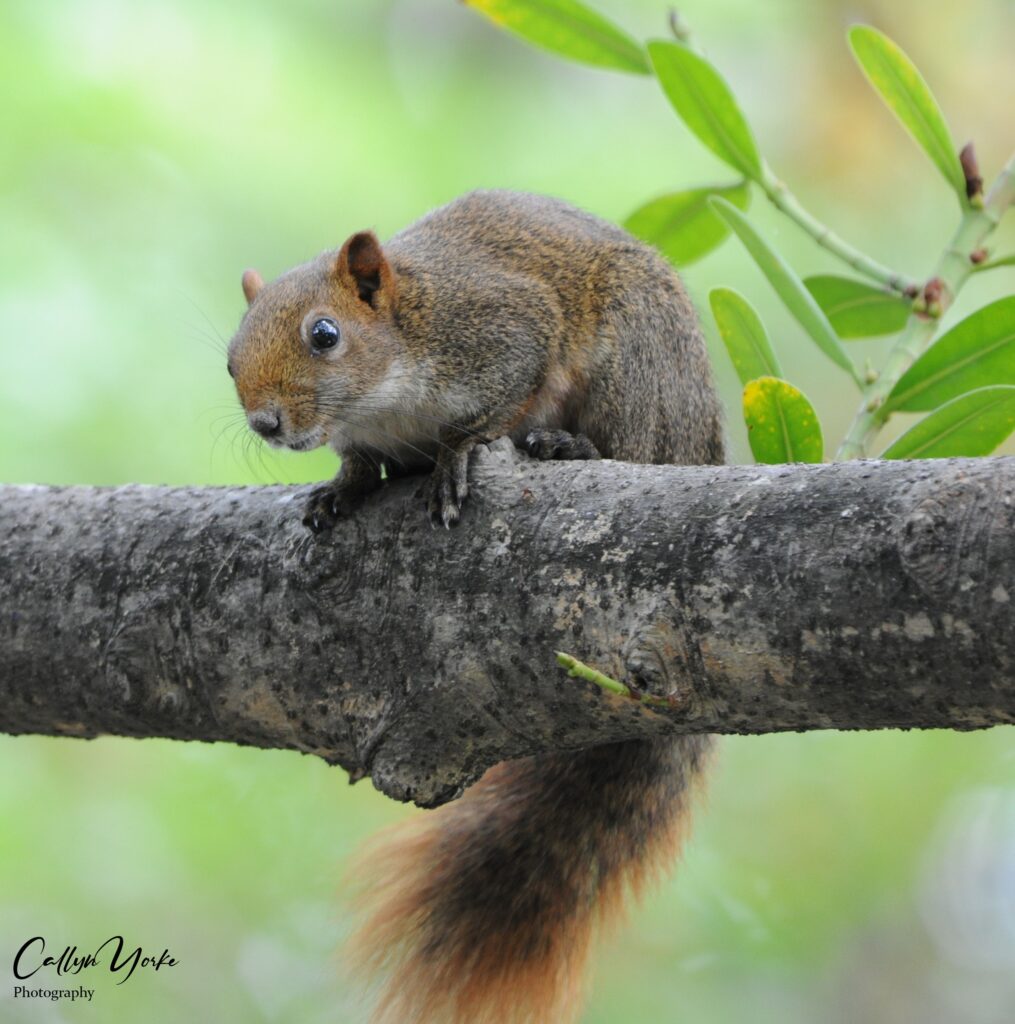
The eye-catching Finlayson’s white squirrel, like a high-fashion model on her wedding day, was a worthwhile subject for photography. More than a few resort guests were chasing them around with cell phones. The coquettish little animal seemed to know its special value and required considerable effort to capture it with anything other than a fragmentary, distant, blurry photograph — several of which I had already accumulated and deleted. Undaunted, I continued my daily, unsuccessful attempts to follow them along power lines (an unacceptable photo background) and into adjacent trees around the resort. Soon, the squirrel was out of camera range and/or I was distracted by the appearance of a new bird for my list — one that I absolutely should photograph. Squirrel game over; bird game on.
I was beginning to understand how this population of white squirrels had survived. These squirrels were quick, sharp-eyed and hyper-vigilant. Mother nature is a tough coach. Sleepy-headed, inattentive individuals had likely been picked off by a watchful raptor. I’ll bet that those few, unlucky squirrels, were the only ones who’s mugshots had become screensavers. For their more circumspective relatives, a wildlife photographer was just another slow, clumsy predator trying to grab some fast food. The majority of squirrels in the all-white population were the surviving champs; their winning genes would be passed on to the next generation. I was up against an all-star team of predator-dodgers and way out of my league.
The photo-follies went on intermittently for several days during my stay at the resort. By then, I suppose the local squirrels recognized me. Flagging their tails, they were ready to play again. About the only way I would get an image of Finlayson’s ghost-squirrel, would be if I found one flattened on the road. No luck there. I wasn’t clever or patient enough to obtain any usable photos of those running, jumping, climbing, snowy little furballs, so conspicuous as to appear misplaced; hopelessly lost and far from their imaginary home – somewhere. I don’t know. Maybe a sub-arctic boreal forest? I probably should have spent the squirrel-chasing time focused on what I had mostly come to Thailand for: birds.
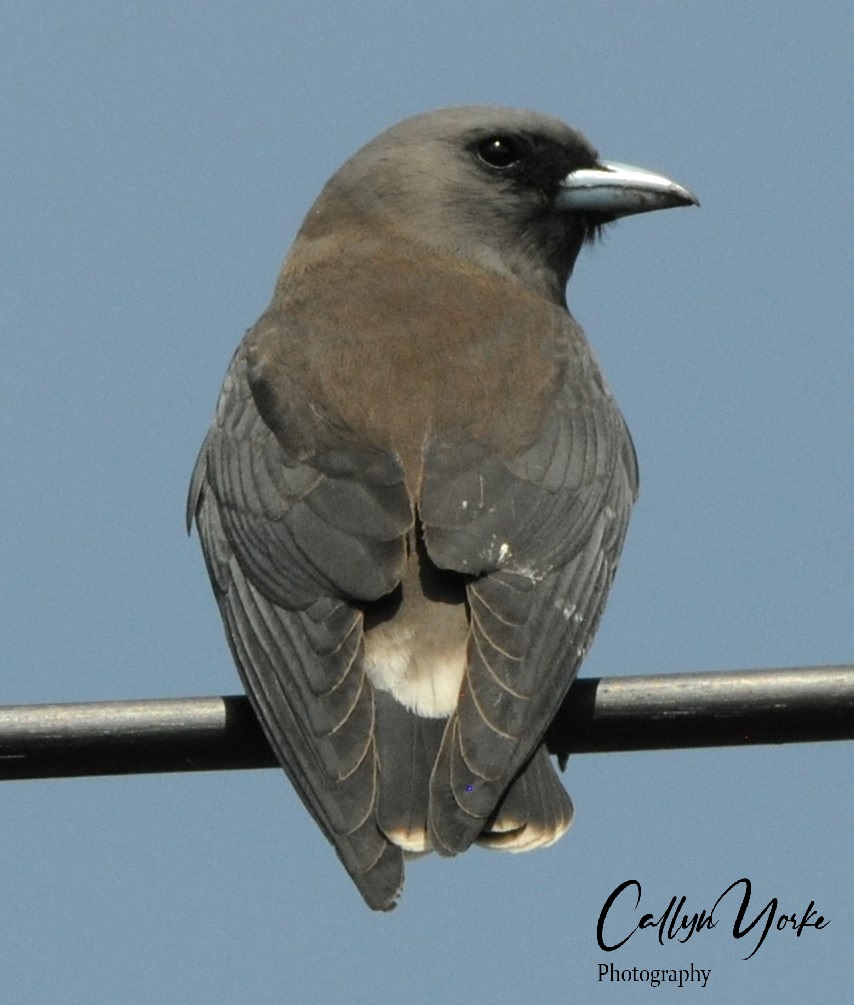
My daily bird surveys in King’s Park, Bangkok, averaged around 45 species, including a few species outside the park boundary, seen from the fence line, e.g. Ashy Woodswallow. Species turnover on my day-list was the norm, as it has been in most areas I have visited in the tropics. Quite a few birds appeared to wander in and out of the park or into a secluded section of the park, e.g. a swamp forest, where they were less easily detected. Those areas, including a grassland-marsh adjacent to the eastern park boundary (the only place where I found Bronze-winged Jacana and Asian Golden Weaver), required a little more time and effort to survey.
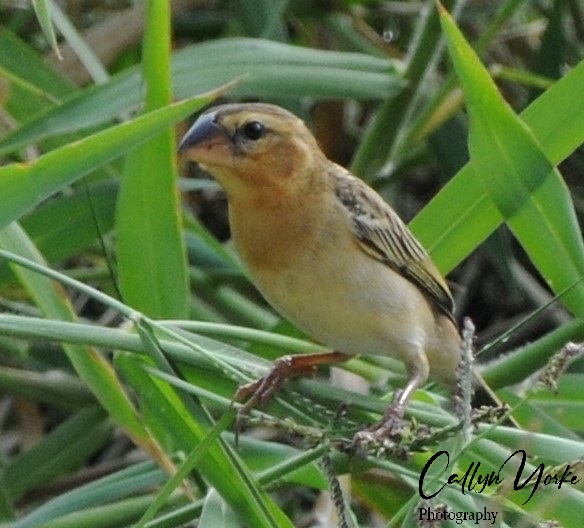
I added several new species each day to the cumulative list. After four consecutive morning surveys, I had observed 67 species in and immediately adjacent to King’s Park Bangkok. Extrapolating from those results, it was likely that, had I spent several more days surveying the park, my bird list would have approached one-hundred species. Remarkable indeed, for a city park surrounded by 10.5 million human inhabitants!
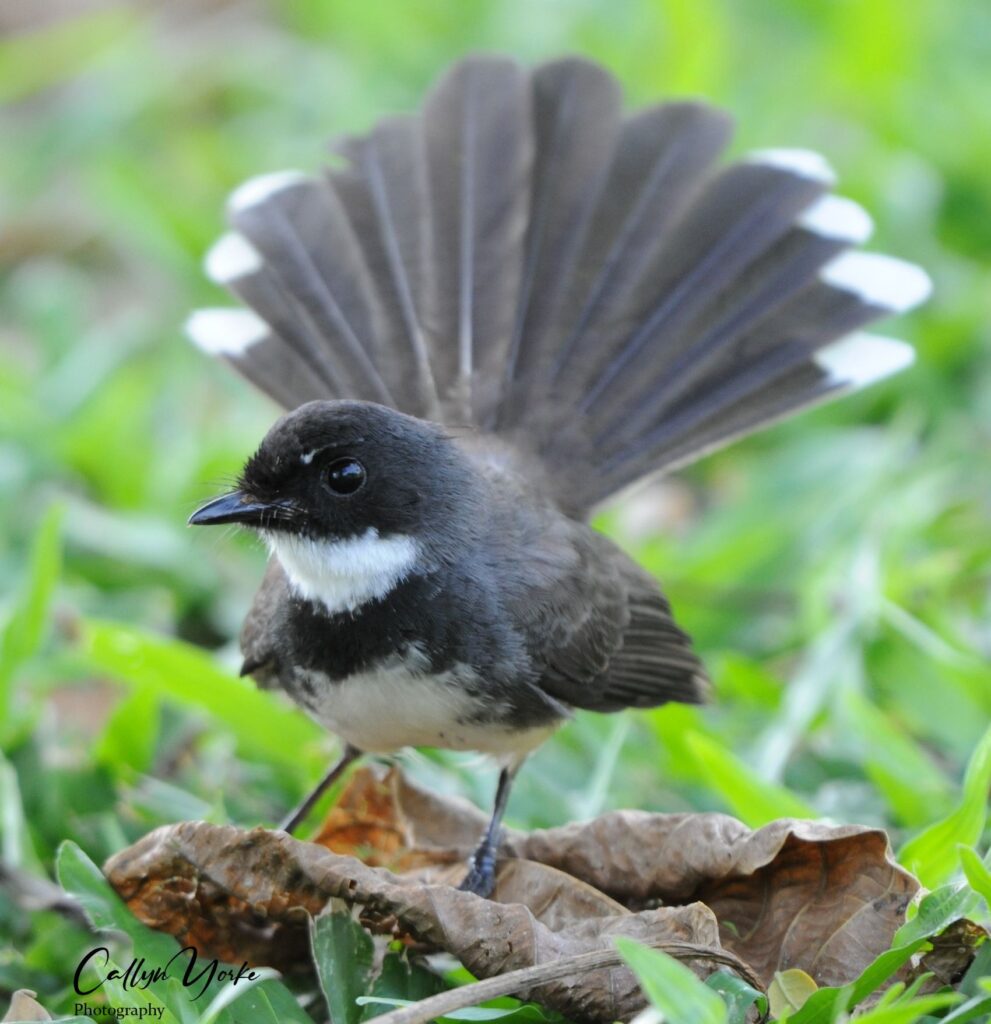
My next two birding locations were in the adjacent provinces of Nakhon Nayok and Nakhon Ratchasima, about 130 km northeast of Bangkok (3 hrs. by taxi, $US 75): Khao Yai National Park (hill forest around the park headquarters and visitor center) and the Atta Lakeside Resort (5- Star: $US 150/night, including breakfast) – Kirimaya Resort and golf course (see below, On The Road: Survey Areas, Materials and Methods).
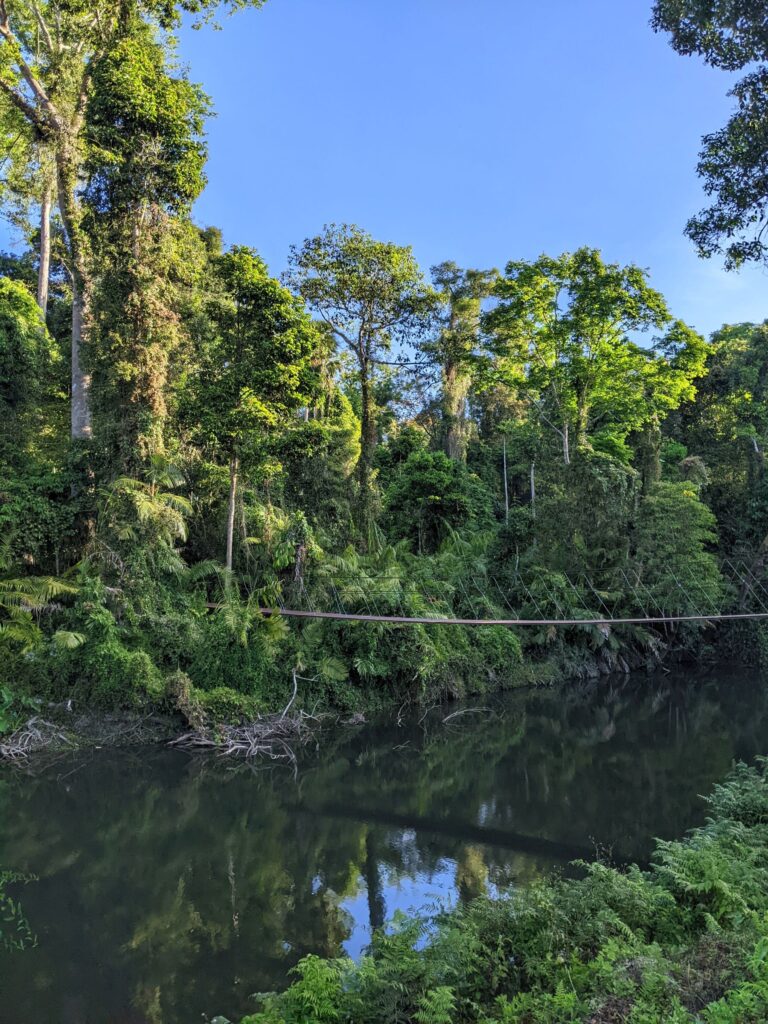
I rented a 2022 Toyota sedan, kindly arranged by the concierge at Atta Lakeside Resort ($55 per day, including full insurance) and commuted to and from Khao Yai National Park (daily entrance fee, $US 12). When not visiting the park, I made bird surveys around the resort and through the adjacent Kirimaya golf course (as a non-golfer, I was always greeted by friendly groundskeepers and never any objections from the resort management), yielding a fairly substantial number of bird species, including some that were not observed inside the national park. Taken together, the two Khao Yai locations, 25 km apart, with significantly different elevation, topography and vegetation, produced just over one-hundred bird species for a final tally.
Anyone who has birded in a tropical forest would probably agree, that what you honestly can see clearly enough to identify, let alone photograph, is a infinitesimal fraction of what the local bird list indicates should be there. Birds are adept at keeping foliage, tree limbs and other obstructions between them and you. They may even be singing their little heads off, yet remain invisible somewhere in the forest canopy.
One of the best examples of a common garden bird that is often difficult to observe, is the Western Koel. Many times in Thailand, I would hear the loud, persistent whistles of one of these large, readily identifiable members of the cuckoo family. But when they were perched in a tree canopy, they morphed into an avian phantom. The bird was often quite close, perhaps only 5 m away, holding its well concealed position, where it could continue singing with impunity, apparently confident that it would not be found, except perhaps by another bird of the same kind. When, on rare occasion, I had a clear line of sight to a Western Koel, I fired off as many frames as the Nikon D3X would deliver and prayed for just one decent image. Usually, I had to trash a lengthy series of blurry, fragmented images of the bird. But sometimes, notably in King’s Park, Bangkok, where a large population of habituated Western Koel thrives, I obtained satisfactory results (photo).
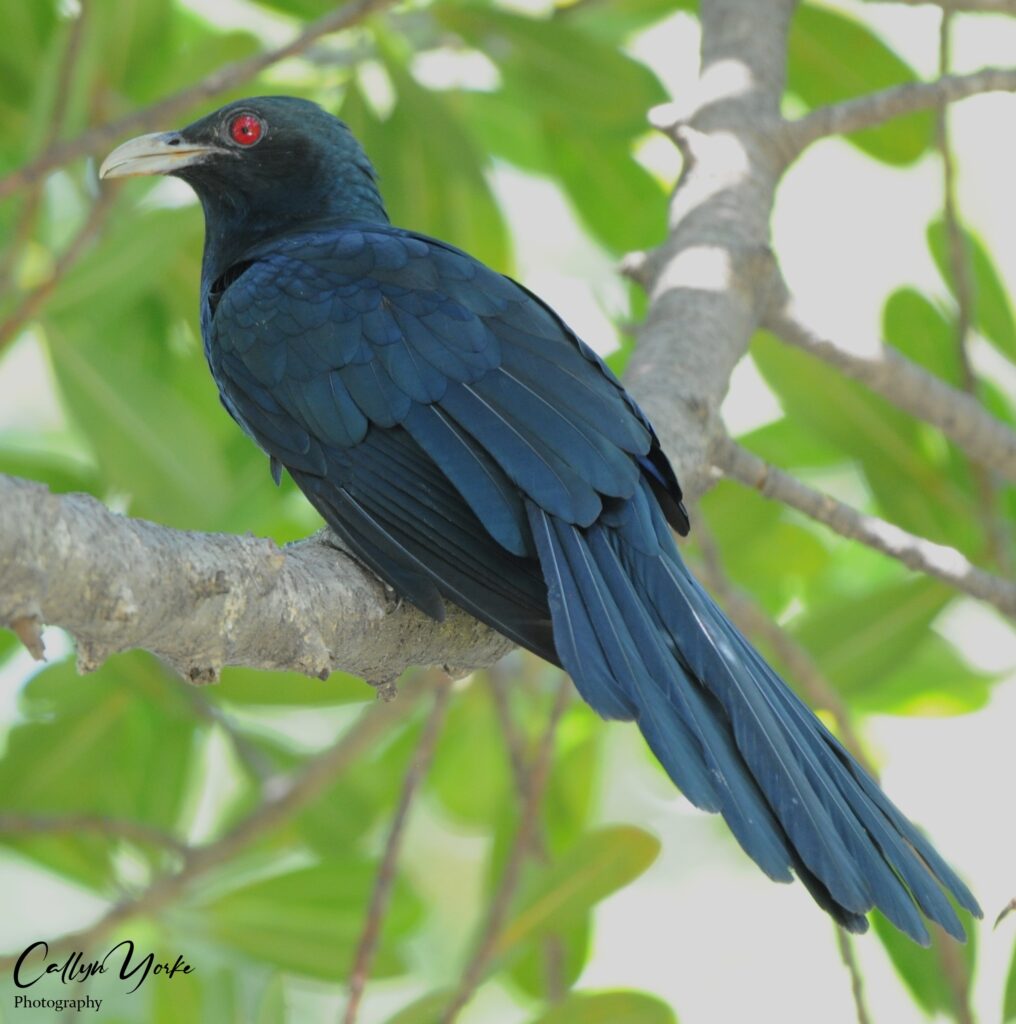
Frustrating, is perhaps too mild a term to describe one’s first few ventures into a rainforest. A blind birder with keen hearing might have greater satisfaction in a rainforest, listening to the many different bird sounds, than would those with expensive binoculars and cameras. Necessarily, expert bird-tour guides have learned to identify secretive forest birds by the unique sounds they make. That’s really cool, except most of their clients are visually oriented and, unless they actually see the bird in question, probably wouldn’t count it as a “life-bird.”
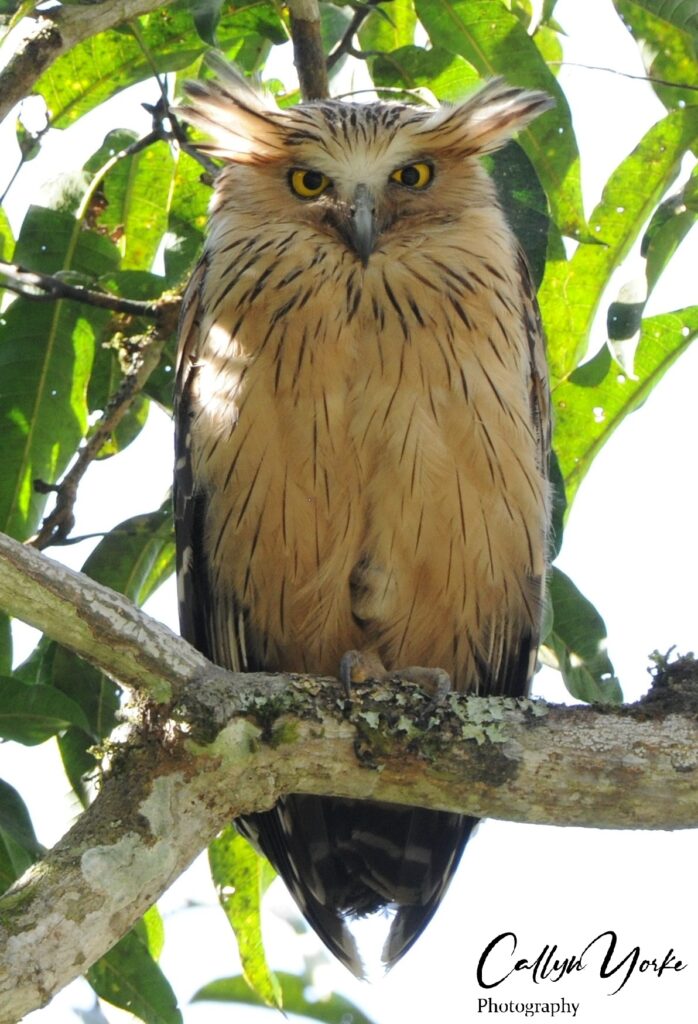
With more than a few such experiences in mind, I chose to remain around the Khao Yai National Park visitor center and headquarters, figuring I would have just as good a chance of seeing birds there, as I would walking for several hours on the forest trails, plucking leeches off my boots and trousers. It was definitely the easiest option and one that would keep my attention sharply focused on birds and wildlife. During four morning visits, I managed to see and photograph a surprising variety of birds, while simply sitting around with some chatty folks on the observation deck behind the gift shop (see the Annotated Bird List for Khao Yai National Park Headquarters).
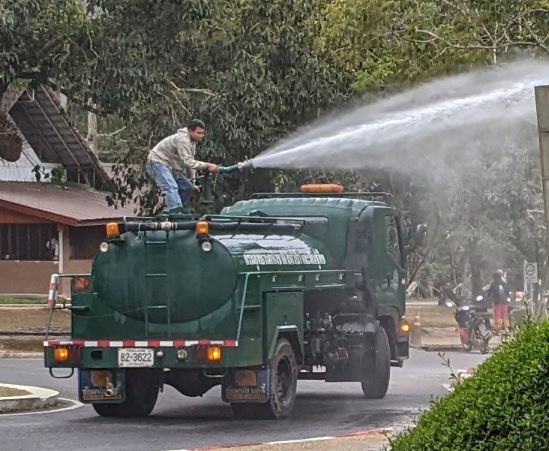
Two minor annoyances when birding around the park headquarters were, 1) An increasing number of noisy visitors as the day progressed and 2) unannounced assaults with a formidable water pressure-nozzle, having an astonishing range and chilling accuracy (photo). I guess the park service was determined to bring a little more rain to the rainforest, as well as to unwary birders toting expensive optics. I would suggest yet another park warning sign be posted, indicating, “Birders & Photographers, Beware of Sudden Cold Showers.“
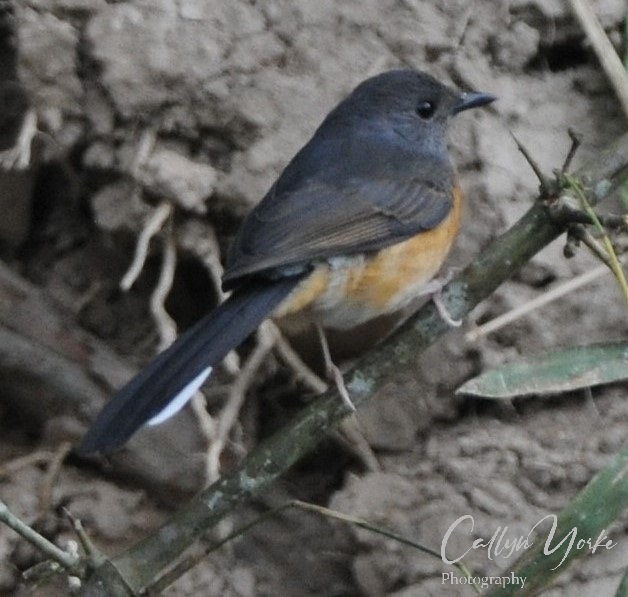
Definitely worth mentioning, is the fact that I found a few forest understory birds on trails a short distance from the park headquarters, e.g. White-rumped Shama and Orange-headed Thrush, both of which remained stationary for a few seconds allowing photos.
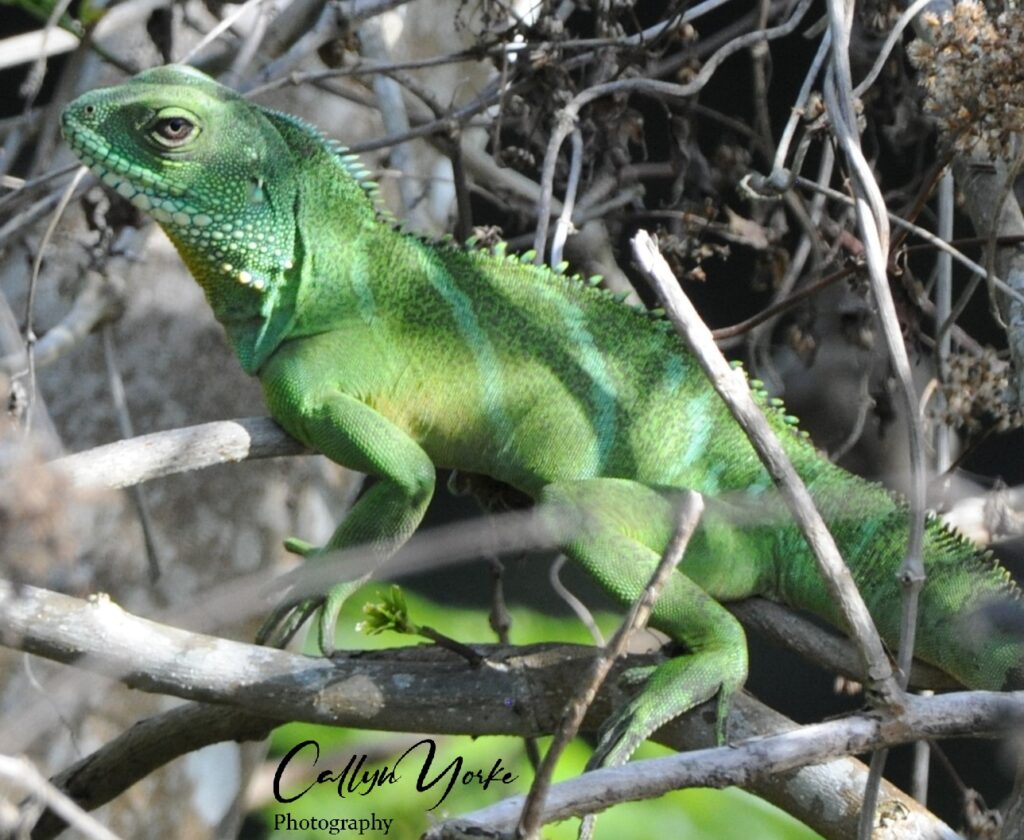
In addition to a good variety of birds, The park headquarters and surrounding areas had some interesting reptiles and mammals. Early one morning, about a half kilometer north, in a grassy clearing near the main road, a magnificent adult male Asian Elephant, showing the dark ‘tears’ of musth, was making his way directly toward a line of haphazardly parked cars. Several people on foot were attempting to get close to the beast for photos. Bad idea. A lone bull elephant in musth can be grumpy, unpredictable and dangerous. Forsaking what might have been a great head-on photo of the elephant, I drove on slowly with that thrilling visual, tempered by a familiar pinch of the-one-that-got-away-regret, well known to photographers. That would be my only elephant sighting for the entire two-weeks in Thailand.
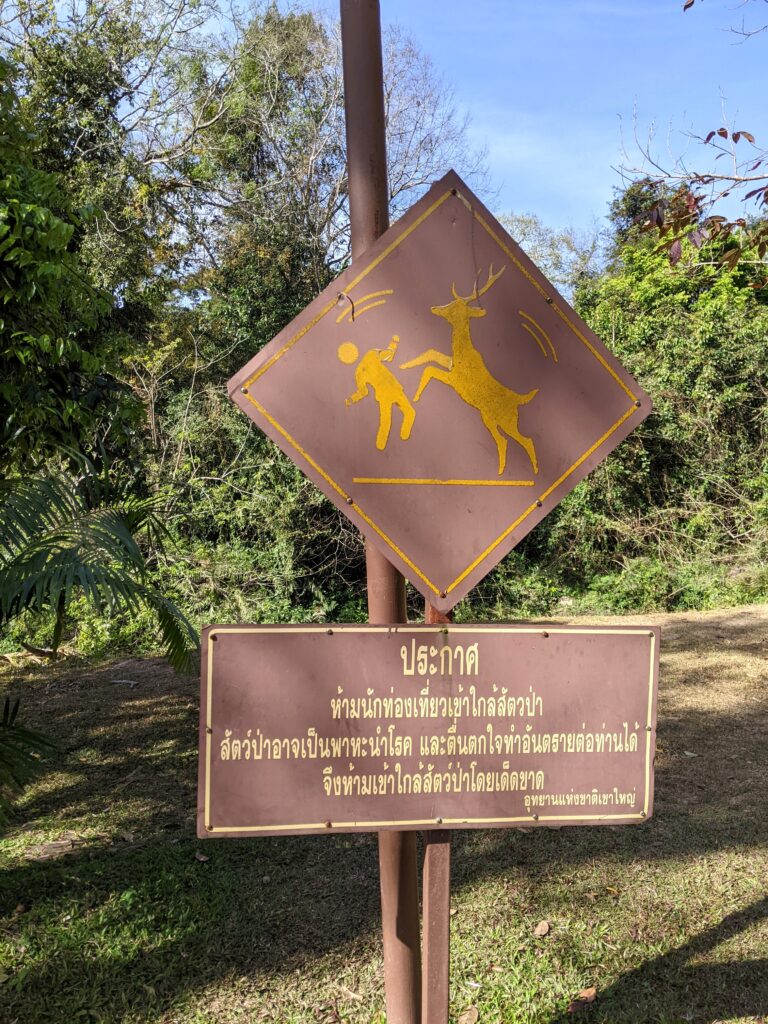
Most animals could be fairly easily observed at close range around the park headquarters, presumably because of habituation to human presence. Some of those creatures might be difficult to find and photograph in the quiet, remote parts of the park, where they would flee for cover at first sight of humans. Such was seldom a problem at the park visitor center.
For instance, a tree overhanging the stream next to the parking lot, supported a bright green Indochinese Water Dragon. This large, diurnal, heliothermic lizard, had color-matched itself so well to sparse green foliage, that it was quite difficult to see, even when only about 7 m away (photo). Behind the food stalls, two adult female Sambar Deer, a fawn and a more distant buck, were browsing on streamside vegetation. I fired off a few quick frames from about 5 m away, then moved well out the animal’s personal space (photo).
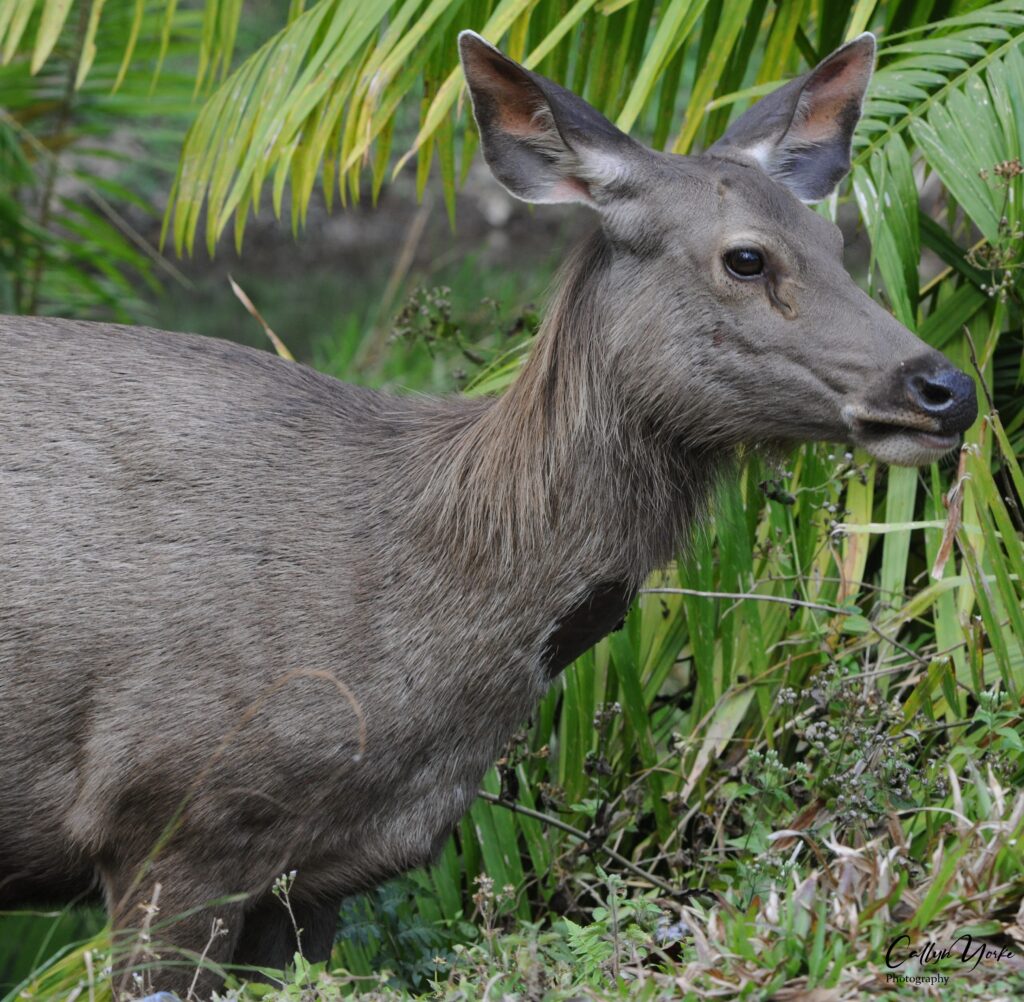
As in most of the popular wilderness parks throughout the world, serious injury and death may occasionally occur in Khao Yai National Park. I’m sure the park service is well aware of the most common dangers. For example, feeding wild animals, which generally have poor table manners, can result in unpleasant encounters, ranging from embarrassing to fatal. Warning signs showing simple, stick-figures, are posted along roadways and around the park visitor center. I imagine that each one of those signs is a testimonial to a tragic accident in the park. I’m reminded of the book, Off The Wall: Death in Yosemite, by Michael P. Ghiglieri and Charles R. Farabee Jr.. The authors of that book methodically researched all available casualty records for Yosemite National Park in California, and assembled a litany of gripping accounts, describing situations with park visitors who, in most cases, died as a result of their own poor judgement. After reading that book, I have more than a trivial respect for warning signs in a national park. They are there for a reason and should be taken seriously by all visitors.
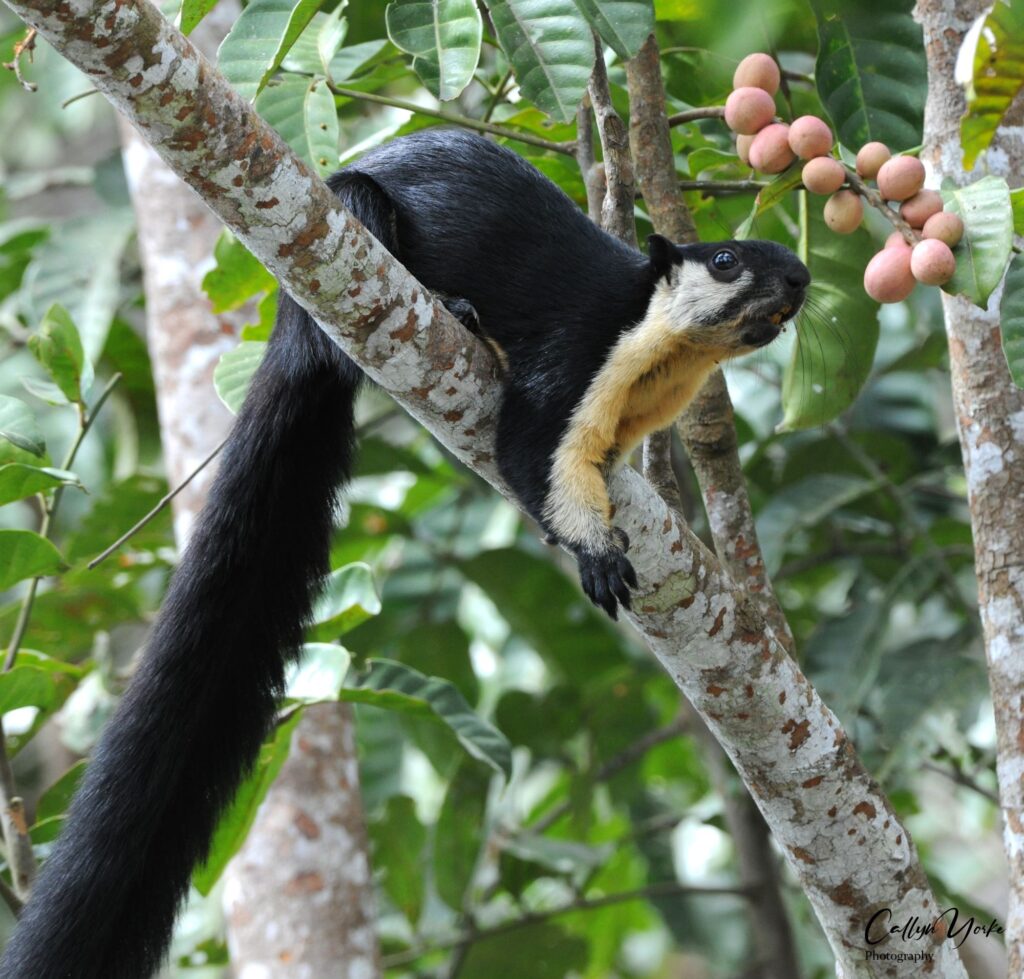
On the other side of the bridge, next to the parking lot for the visitor’s center, a handsome Giant Black Squirrel, ordinarily wary and fleeting, was entirely preoccupied with harvesting and consuming grape-sized fruits from a broad-leaved deciduous tree. That was an exceptional Kodak moment for park visitors, including those cruising by in cars, holding their cell phones out the window. Other mammals of interest near the park headquarters, included highly vocal White-handed Gibbon and Northern Pig-tailed Macacque (photo); both of those primate species have become scarce in Southeast Asia, largely due to habitat loss.
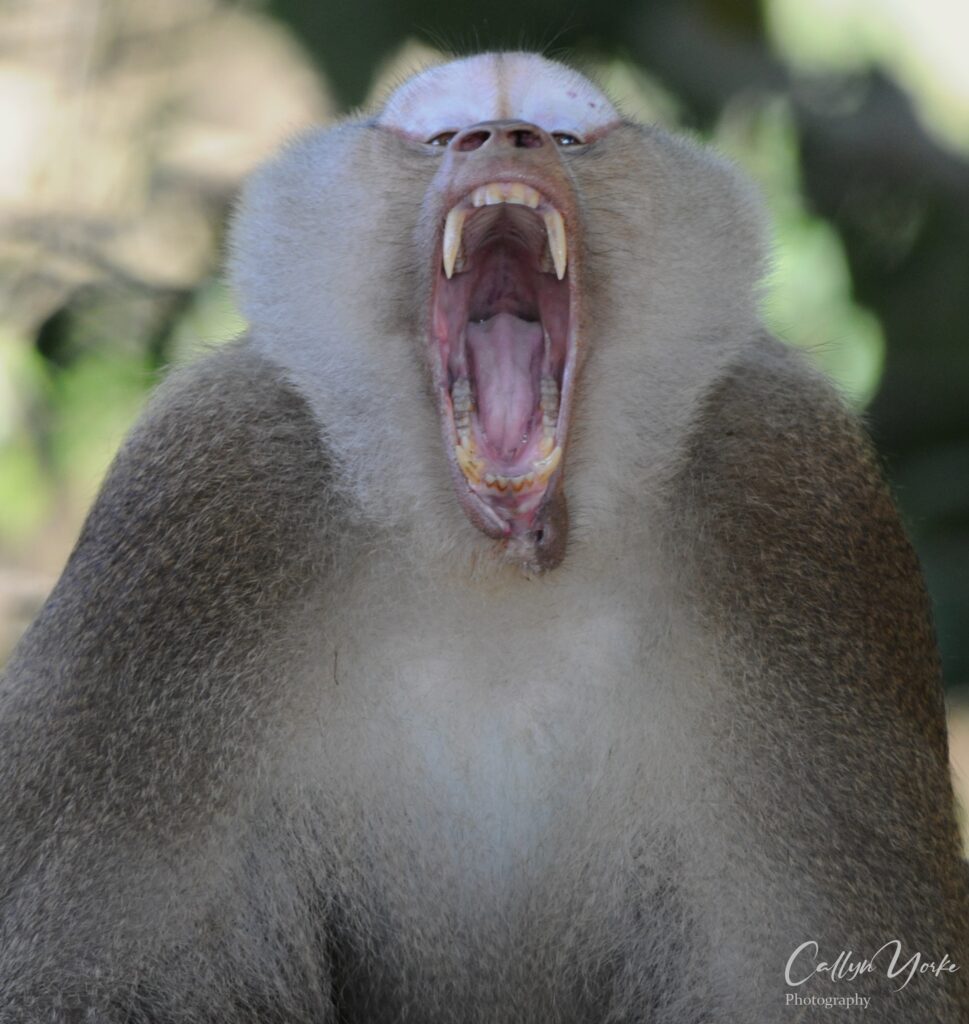
The birds and other wildlife I observed and photographed in King’s Park and the Khao Yai area, made this a productive and memorable visit to Thailand. Nearly two weeks of daily fieldwork was exciting and novel throughout, and I was looking forward to returning home to Vietnam and writing up my report. With two days remaining in Thailand, I was packed and ready for the three-hour taxi ride back to Bangkok. I had booked a hotel near Suvarnabhumi International Airport, doing so rather hastily and without much more consideration than it being convenient and cheap. The place had an attractive name, Na Siri Lakeview Hotel, suggesting that there were birding possibilities. This was another 3-star, Thai family-owned hotel ($US 37 per night), that probably would be perfect for one night.
Lodging facilities in Thailand (3-star and above), in my experience, are thoughtfully and creatively designed, meticulously cleaned, maintained in good repair and reasonably priced; guest services, likewise, are often excellent. Thais generally take great care and pride in whatever they do; foreign guests are uniformly treated with dignity, respect and kindness. Traveling in Asia as a solo birder can be logistically challenging at times but it has always been a special treat for me in Thailand.
Na Siri Hotel was quite efficiently run by a limping, partially deaf, legally blind, balding grandmother, no more than 1.2 meters in height. She greeted me warmly, first in Thai, “Sawaadee,” then with a lovely, soft, ” Wal-Cam.” My passport was photocopied (routine in most Asian countries) and she handed me a room key. I had an immediate liking for this fascinating old woman. Clearly, she had had a long, difficult and painful life, yet showed only kindness and gratitude toward her hotel guests. In her quiet, humble manner, she personified the indelible spirit of Thailand.
The grandson cheerfully assisted me with my bags up to the fourth floor, via a slow but steady, wood-framed elevator. My assigned room (#401) was large, immaculately clean, and comfortably furnished. Plumbing and electrical facilities were in good working condition. There was a balcony with a small utility sink and large windows facing south and east, overlooking a sea of tiled rooftops. The lake was on the west side of the building and out of view from my room, which was shielded from the broiling afternoon sun.
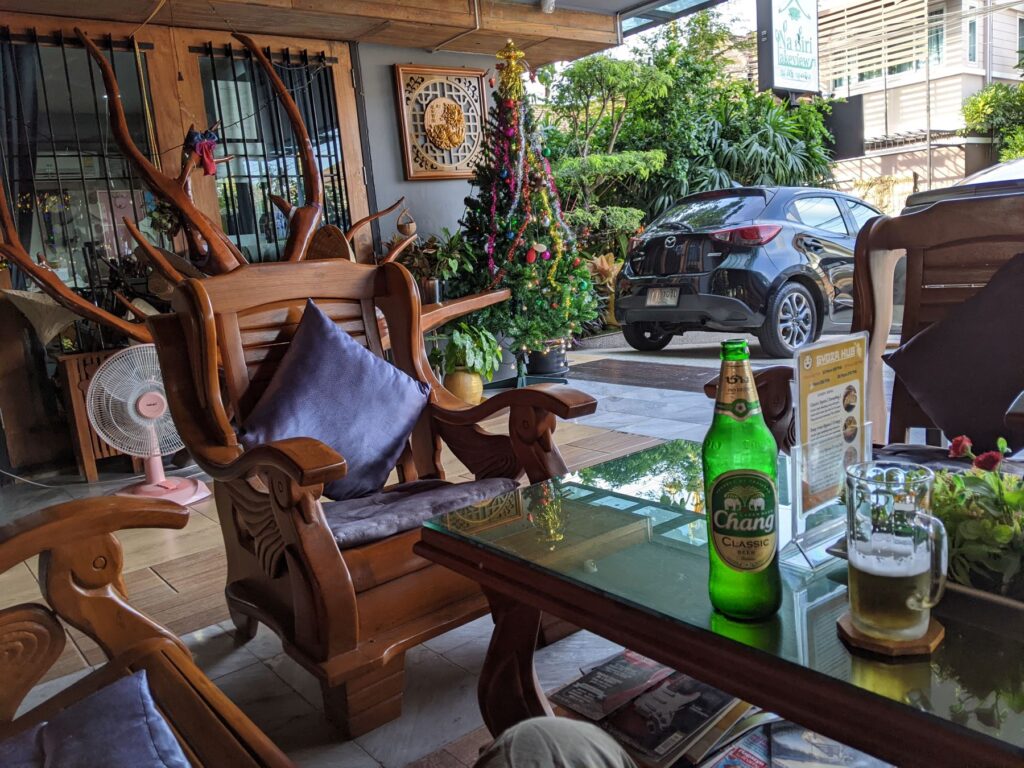
After finishing a delicious meal of Thai garlic chicken and a bottle of Chang beer, I made a brief, late afternoon reconnaissance of the neighborhood and lake. There were a few birds, e.g. Feral Rock Pigeons on the roof-tops and a small flock of Whiskered Tern hovering above the lake. A low angle of the sun and fading light rendered bird identifications somewhat difficult. A few of the local dogs loudly objected to my being in their territory without a birding permit. It was time I retreated to the safety of the hotel, where the remainder of the evening would be spent summarizing my trip notes. The neighborhood and lake were readily accessible; I would do a brief walking survey in the morning before going to the airport.
At sunrise the following day, I set off from the hotel on a counter-clockwise stroll around the rectangular-shaped reservoir (‘lake’), beginning at the southeast corner. A few neighborhood birds were awake; recognizable vocalizations included, Red-collared Dove, Zebra Dove, Western Koel, Magpie Robin and Olive-backed Sunbird. It was an encouraging start. But the same dogs I had met the previous day, disagreed and soon had me cornered, showing some impressive canine teeth and raised spinal hairs.
The mix-breed, medium-sized dogs (17-25 kg), had their meet-and-greet shit together like seasoned gang-bangers. The alpha dog came at me first, the other two flanked me, creeping closer, each staying in my peripheral blind spot. They were testing me, like wolves test an elk separated from the herd. Any sign of fear or weakness would be quickly exploited. If I turned and ran – as they probably anticipated – I would surely be feeling some of their frontal dentition sinking into my legs.
There was only one option left for me to escape unharmed. I had learned it while growing up around Labrador Retrievers that my dad bred and trained for hunting. Dad, whom evidently had never met a dog he didn’t like, repeatedly demonstrated one of the cardinal rules of animal training: Dogs, particularly the frisky ones, need to be shown who is in charge. Many years later, while doing bird surveys in Malaysia, I had an opportunity for a first-hand field experience, successfully defending myself against a pack of five or six feral dogs that had me surrounded in an old rubber-tree plantation.
The Malaysian dog-pack incident was a terrifying yet valuable lesson. A few comparatively minor dog issues occurred in the years that followed. Occasionally, while birding in rural areas, I would again be applying canine counterinsurgency tactics. Sometimes the dog’s owner would intervene and resolve the problem. Other times, I was on my own to deal with the gnarly dogs. Fortunately, I have never had an encounter with aggressive dogs where I failed to escape uninjured. Most dogs quickly learn who not to fuck with.
In this particular case, although entirely unarmed, without dog biscuits, and potentially vulnerable as a senior non-citizen, I had useful advantages over my three canine adversaries. The most important of those was body size. I was much taller and heavier than any of the three dogs; in the animal world, as in Bangkok traffic, size matters. But size mismatch alone wouldn’t frighten these dogs away. This wasn’t their first rodeo. I had to use my size advantage in such a way that, when the dogs were confronted with it, their instinctive math calculations informed them there was a high probability they could be seriously injured. In other words, I must bluff my way out of danger. Now, this is the part of the story that some dog-loving folks may frown upon, particularly dog owners who defend themselves by using the worn out excuse, “Oh, but he (their dog) would never hurt anyone.”
First, lifting my binocular, I stared down the alpha male. Dogs, like birds, don’t enjoy being stared at. It makes them nervous and they begin considering an exit option. Adrenaline circulates through the body quickly and with massive systemic effects. Conflicting ‘fight or flight’ impulses may result in confusion, fear and temporary paralysis. This is the critical moment for a strong and determined counter-attack.
Besides, we were wasting valuable time. The dogs may have had all day but there were more birds out there I wanted to find and I had a plane to catch. I was losing my patience with these three impolite dogs. Suddenly, I charged directly at the alpha male dog, loudly shouting some nonsense in English. It was unclear if the dog understood my commands to, “GO HOME!” but he definitely got the correct context. When he turned and ran, the two subordinates followed, barking and growling, intensely now, but more because of the unexpected aggression from me, than a willingness to continue the battle.
The dogs regrouped at a safe distance and barked out an announcement for a brief emergency meeting. I imagine that the following discussion points were raised:
Subordinate Dog #1:”That old asshole is crazy! Subordinate Dog #2, slightly winded while scratching his flea bites: “He looks dangerous. There will be easier targets later” Alpha Male Dog: “Yeah, maybe so, but, dammit, this is our home turf. I say we have another go at him.”
Predictably, the dogs came at me again with the same flanking tactics, though this time, slowly and with a measure of caution. I braced for the next running, full frontal, bluff- assault on whichever was the closest opponent. We replayed this cycle of advance and retreat twice more, I recall, when the dogs seemed to tire of the game and wandered off. I continued walking around the lake, tallying birds. Some bystanders, who had been observing the noisy dog incident from a distance, looked concerned, but said nothing. They watched me closely, as I proceeded with the bird survey. The dog show was over.
By the time I returned to the hotel, my local bird list had grown to twenty-nine species, including an unidentified small heron (Yellow Bittern?) that flew into a clump of marsh vegetation at sunset the previous day. I was delighted to see that there were quite a few waterbirds flying over the lake at dawn, presumably commuting between other, adjacent wetlands. Considering the high-density housing, nearby airport and local light industry, the area apparently retained a significant amount of ecologically functioning wetlands.
Among the fly-overs were, Asian Openbill, Gray Heron, Great Egret, Intermediate Egret, Little Egret, Chinese Pond Heron, and Little Cormorant. Land birds included, Eastern Spotted Dove, Coppersmith Barbet; Greater Coucal and Plaintive Cuckoo; Yellow-browed Leaf Warbler and Yellow-bellied Prinia. Except for an initial interruption of the survey due to the dog drama, I thought the morning bird walk around the lake went reasonably well, augmenting what had already been a very productive and satisfying, two-week visit in Thailand.
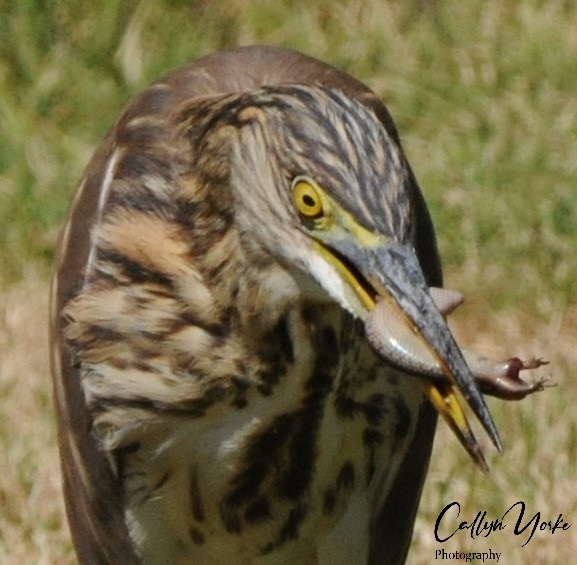
On The Road: Survey Areas, Materials and Methods
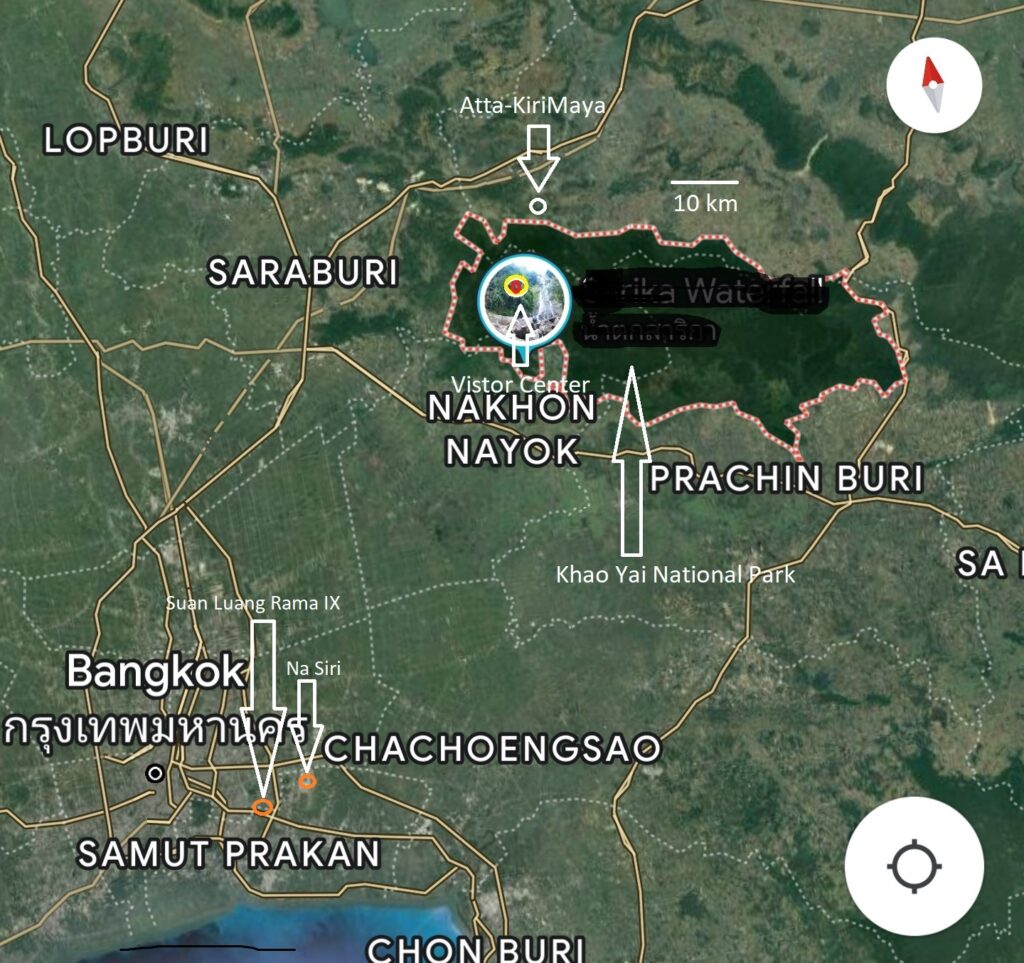
I visited four principal areas In Thailand, in the following chronological order: 1) Suan Luang Rama IX (King’s Park) Bangkok; 2) Atta-Kirimaya Resort, Nakhon Ratchasima 3) Khao Yai National Park, Nakhon Nayok; 4) Na Siri Lakeside Hotel, Bangkok (see above map and the Introduction for further details on these survey locations). Surveys were done mainly during the morning hours (0600-1200 hrs.), except for Atta-Kirimaya Resort, where additional late afternoon surveys were made. For all surveys, I used a Zeiss 10 x 42 binocular and Nikon D3X camera, fitted with a Nikon 200-500 mm IF AF VR lens. A Google Pixel 3X cell phone camera was used for general scenery and site documentation. Field surveys were made mostly on foot, walking slowly and stopping frequently to observe and photograph birds. A pocket notebook was used to record sightings; notes were recopied to a loose-leaf binder format later the same day. For species of uncertain identity, I contacted local experts (i.e. Dave Sargeant), referenced reliable online resources, i.e. Cornell University, Birds of the World, and my own digital photos. If a bird’s identity could not be positively determined, it was given a ? in the Annotated Bird Lists (see below).
1) Suan Luang Rama IX (KIng’s Park) Bangkok (Elevation 1.5 m asl): I made four walking surveys of the 80-hectare park, 30, 31 December, 2022; 1, 2 January, 2023; survey duration was 4-5 hours, 0700-1220 hrs.. The weather during all surveys was fair to partly cloudy, 19C to 29C, with variable winds (5-15 kph) from the northeast. I walked zig-zag and perimeter routes on paved pathways through the park, occasionally venturing into open fields and earthen paths through shady woodland. Most of the park was covered visually during the surveys, however some sections, i.e. a swamp forest in the south-central area, were only partially visible due to heavy vegetation and inaccessibility, i.e. a boardwalk in disrepair. Fence lines along the eastern perimeter of the park allowed visual inspection of adjacent grassland-marsh and weedy vacant lots. Some species were found only in those areas, e.g. Bronze-winged Jacana, Red-wattled Lapwing, Ashy Woodswallow and Asian Golden Weaver. Habitats within the park included, lakes, lotus-lily ponds, marginal marsh, canals, swamp forest, open and closed canopy – broad-leaved deciduous woodland, hedgerows, scattered conifer trees, a Casuarina windrow (NE); watered, mowed lawns and gardens.
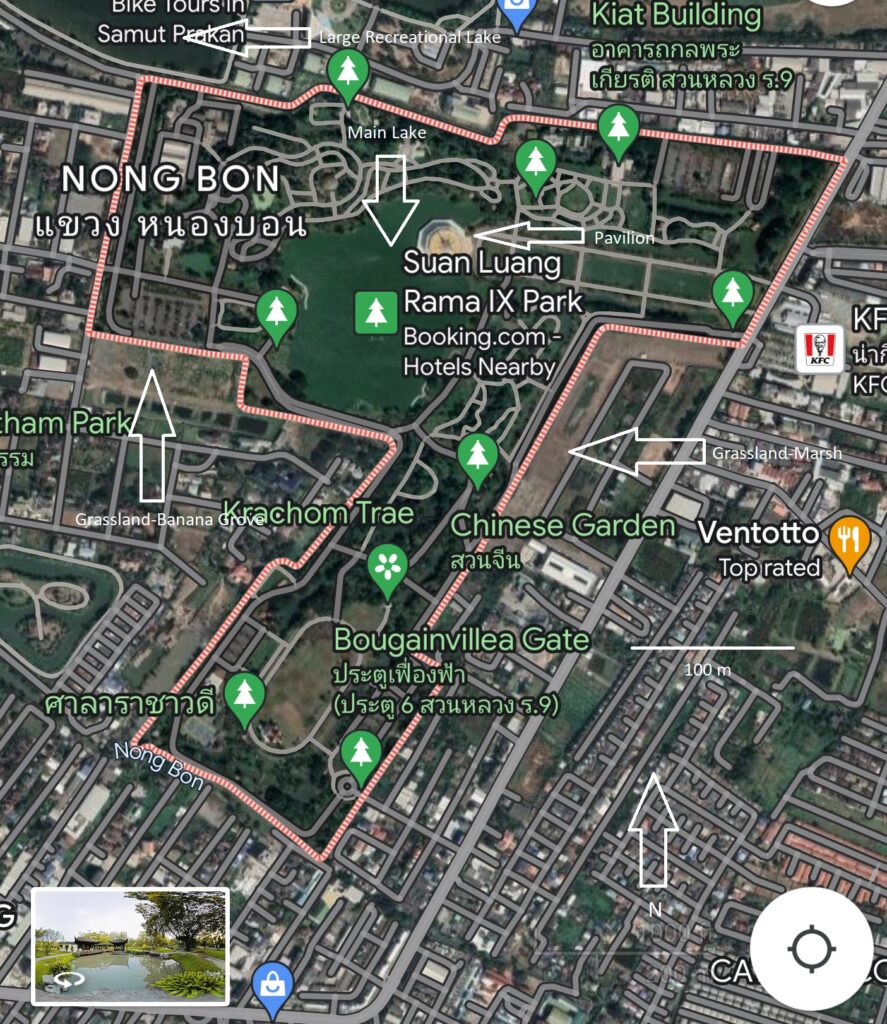
Annotated Bird List: Suan Luang Rama IX (King’s Park) Bangkok, December 30 & 31, 2022; January 1 & 2, 2023 Callyn Yorke
Abundance: Numbers following each species entry are the highest count for a single survey; Age, sex and molt (when known): ad = adult; imm = immature; m = male; f = female; bsc plmg = basic (non-breeding plumage; alt plmg = alternate (breeding) plumage.
Frequency and Distribution: C = Common, i.e. found during half or more of the surveys (2/4 – 4/4) ; UC = found only once during the surveys (1/4). ubiq. = ubiquitous in appropriate habitat.
Ecology and Behavior: aerial insect hawking (ah); taking fruit, berries or parts of flowers (fr); gleaning insects from foliage (ig); probing into surface (pr); estimated height (m) above ground (agl); gregarious (greg); mixed-species flock (msf).
Systematics and Nomenclature used herein, is an amalgam of Avibase, International Ornithological Congress (IOC) and current (2023) online resources, i.e. Birds of the World, Cornell University, USA.
- Feral Rock Pigeon Columba livia 60 greg. C, ubiq.
- Red Turtle-dove Streptopelia tranquebarica 20 greg. foraging on ground in weedy-gravelly field outside the park, sw corner, C
- Eastern Spotted Dove Spilopelia chinensis 6 vocal, pairs engaged in ritualized courtship while perched on utility wires and in trees, C
- Zebra Dove Geopelia striata 16 vocal, greg. courtship and carrying nest material, C, ubiq. (photo).
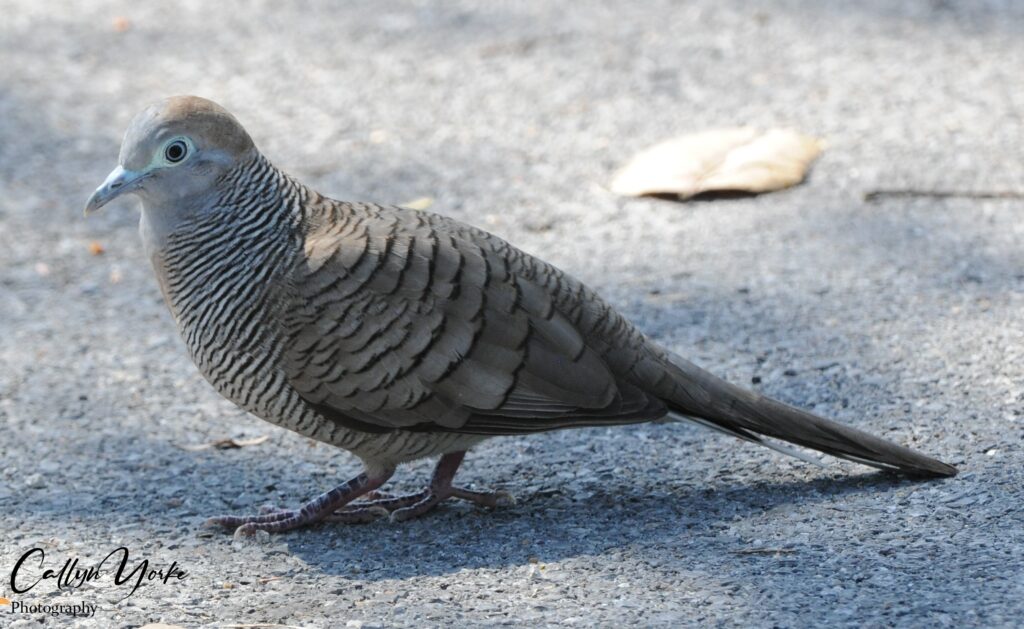
- Pink-necked Green Pigeon Treron vernans 8 (m,f) greg. foraging in trees with small fruits, C (photo).
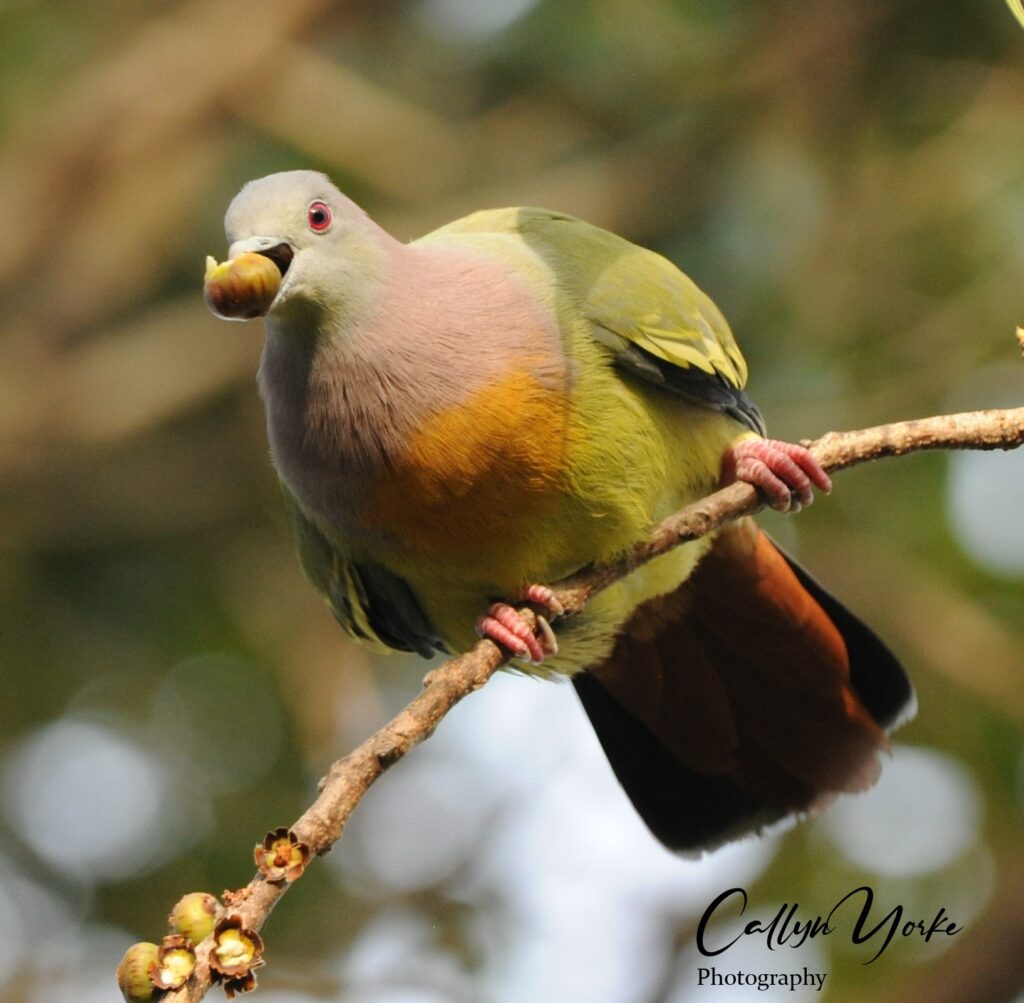
- Germain’s Swiftlet Aerodramus germani 60 (conserv. est.) greg. flying 10-80 m agl, C
- Aerodramus sp. c.f. brevirostris ? 4 loosely greg. flying amongst the closely related GESW and appearing to have a slightly more notched tail than that species, UC
- Asian Palm Swift Cypsiurus balasiensis 16 greg. flying rapidly, 4-15 m agl around a cluster of palm trees in the sw corner (nest site?); also seen in smaller numbers in open areas at 20 -30 m agl near GESW, C
- Greater Coucal Centropus sinensis 1 vocal (unseen) in a ruderal vacant lot outside the park on the se boundary, UC
- Western Koel Eudynamys scolopaceus 16 (m,f) frequently vocal but difficult to see in large trees, often near water, C, ubiq. (photo -see Introduction).
- Plaintive Cuckoo Cacomantis merulinus 1 (vocal) 1 vocal (unseen), east side, C
- White-breasted Waterhen Amaurornis phoenicurus 3 in and at the edge of lotus ponds, sometimes seen crossing pathways; usually shy and retiring to dense cover, C (photo).
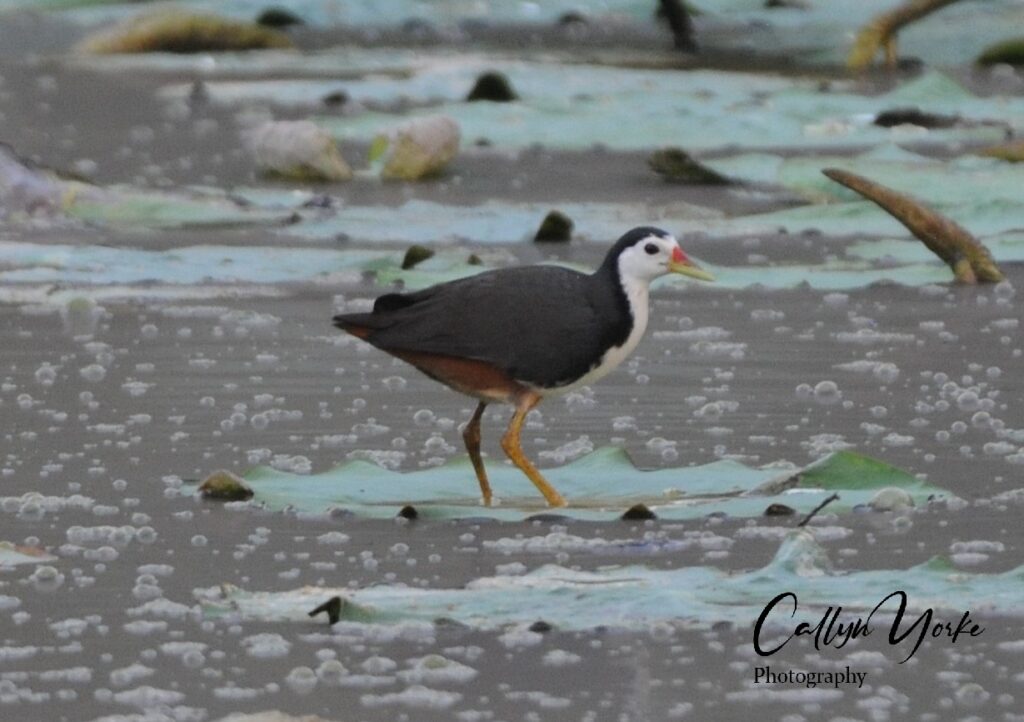
- Asian Openbill Anastomus oscitans 1 evidently the same individual seen daily, standing on a small hill or foraging at the edge of a pond in the Japanese garden; once seen circling the park at 30 m agl, C (photo).
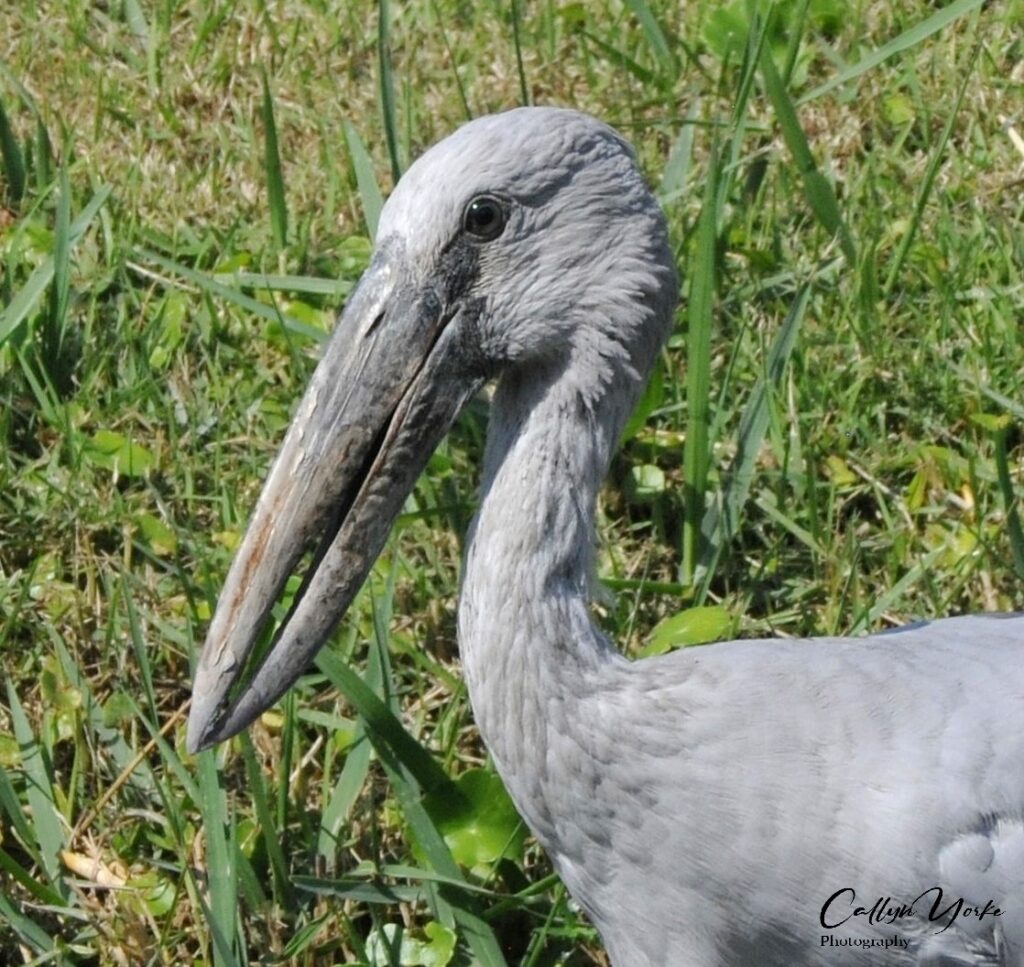
- Yellow Bittern Ixobrychus sinensis 3 (m,f) individuals usually concealed in marsh vegetation at the water’s edge of canals and ponds; sometimes seen flying low short distances in those areas, C (photo).
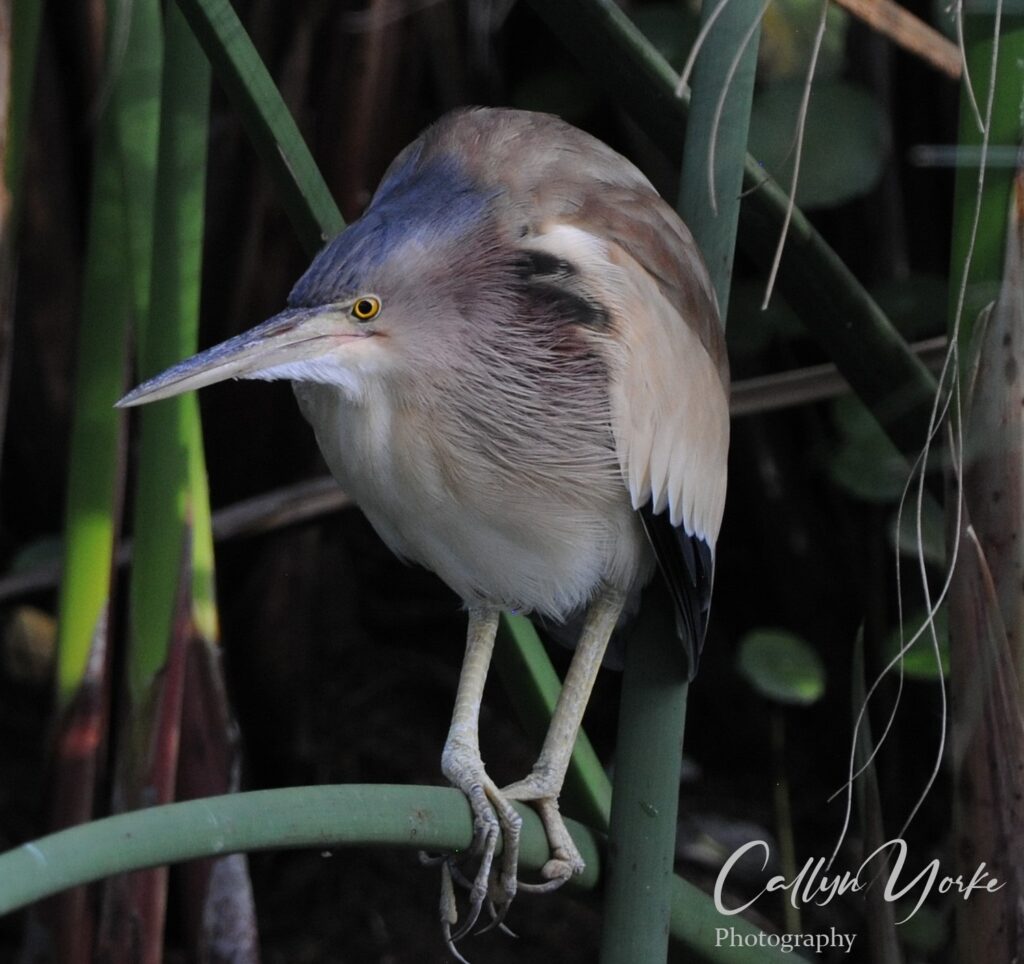
- Black-crowned Night-heron Nycticorax nycticorax 3 (ad, imm), loosely greg. seen only in the swamp forest (southeast) on shore and on low tree limbs overhanging the water, C (photo – see Introduction).
- Striated Heron Butorides striata 2 individuals foraging at edge of lotus lily ponds, C
- Pond-heron Ardeola sp. ? (inseparable in bsc. plmg. from congenerics; most individuals probably, A. bacchus) 25 (bsc. plmg. ad., imm.) vocal when alarmed and in flight, loosely greg. or solitary while foraging in and around lily ponds, edge of canals and marsh and wet ruderal fields; sometimes on mowed lawns foraging for small animals, e.g. lizards, C, ubiq. (photos).
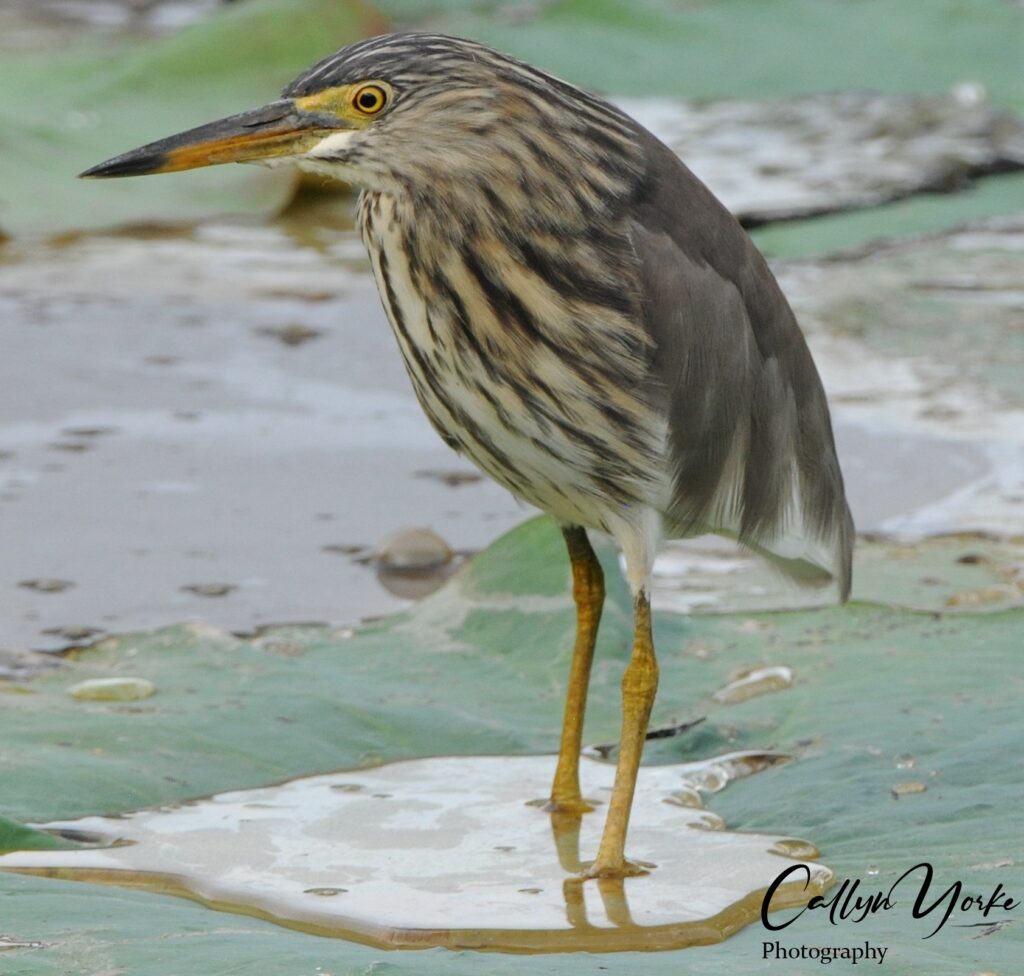
- Gray Heron Ardea cinerea 1 in flight, 15 m agl over marshy area outside of the park, ne UC
- Eastern Great Egret Ardea modesta 3 individuals standing on lakeshore and flying 2-10 m over lake and wetlands, C
- Intermediate Egret Ardea intermedia 2 individuals on lake shore, often loosely associated with LIEG and EGEG, C
- Little Egret Egretta garzetta 10 individuals and small flocks, often with other egrets and herons on lakeshore, canals and wading/foraging in shallow backwaters, C, ubiq.
- Little Cormorant Microcarbo niger 1 on or flying around lakeshore, loosely associated with egrets, C
- Black-necked (Red-wattled) Lapwing Vanellus atronuchalis 4 greg. in marsh clearings outside of park on ne border, C
- Bronze-winged Jacana Metopodius indicus 1 (ad) skulking, partly concealed in tall, marshy vegetation; flying a short distance in full view, outside the park, ne, UC
- Whiskered Tern Chlidonius hybrida 30 (90% ad.) greg., diving into surface of the main lake, especially near the pavilion, taking small fish; one individual flying while entangled in monofilament fishing line, C (photo).
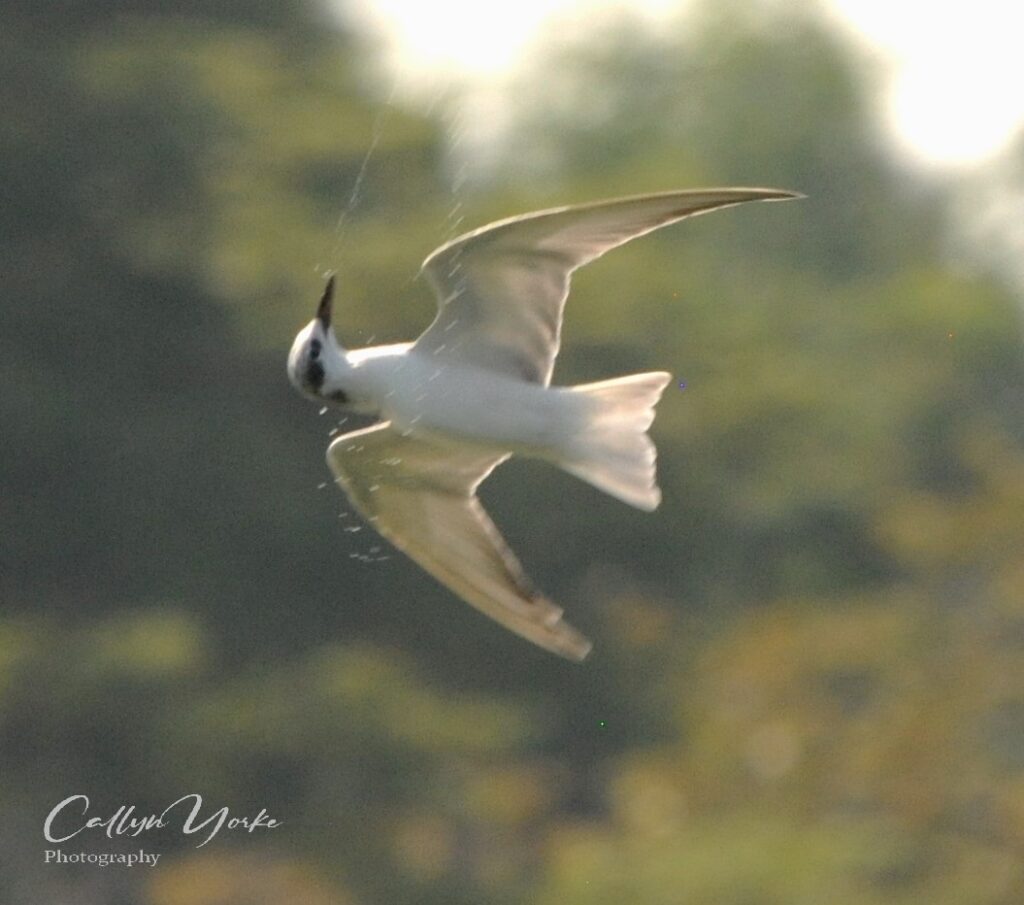
- Blue-tailed Bee-eater Merops philippinus 5 greg. sallying for insects from outer limbs of trees at the edge of open areas, C, ubiq. (photo).
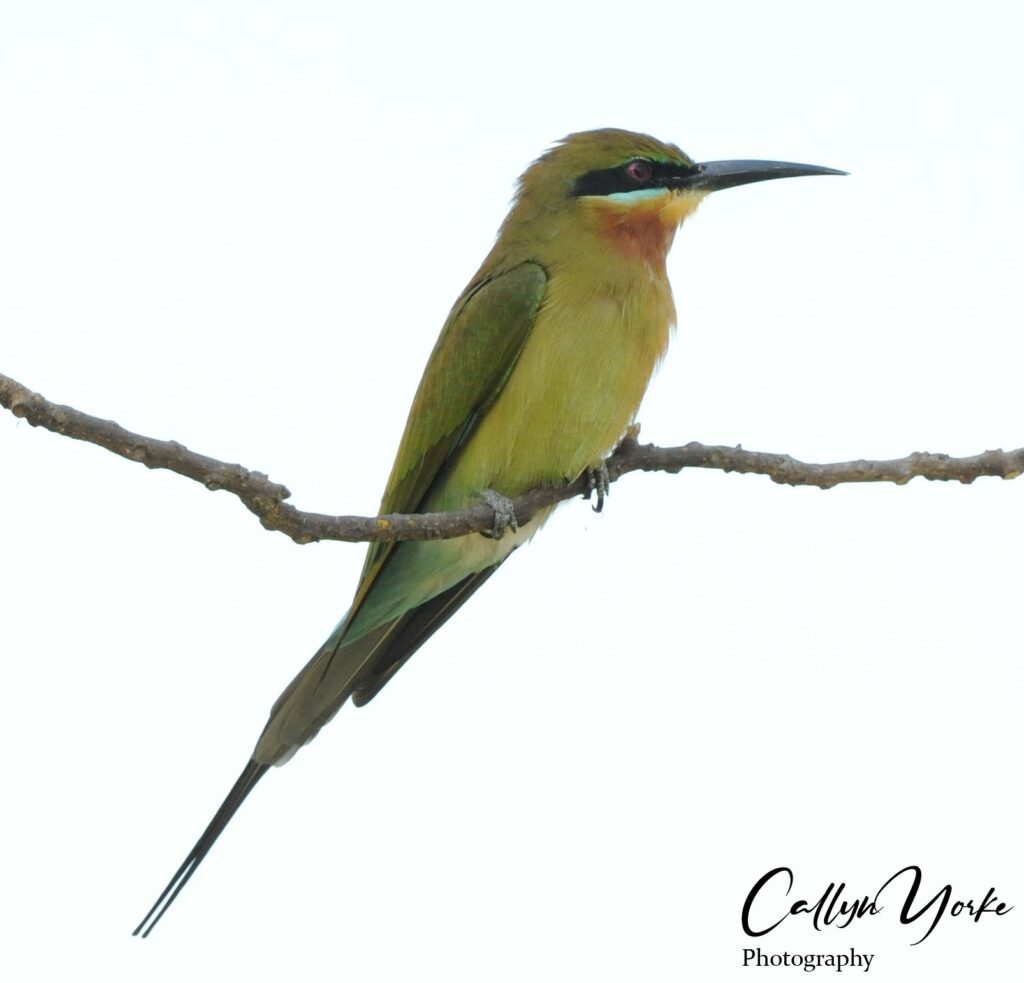
- Indochinese Roller Coracias affinis 3 individuals flying around the park; perched in isolated trees and on utility wires, sometimes on the ground, C, ubiq.
- Common Kingfisher Alcedo atthis 1 perched on an emergent limb in a quiet, backwater canal, UC
- White-breasted Kingfisher Halcyon smyrnensis 1 vocal, flying in swamp forest area, C
- Black-capped Kingfisher Halcyon pileata 1 seen only in early morning, perched in large trees overhanging a lotus lily pond, w, C, (photo).

- Coppersmith Barbet Psilopogon haemacephalus 12 vocal, pairs and individuals, sometimes vocalizing conspicuously at the tops of leafless trees, C, ubiq.
- Eastern Black-naped Oriole Oriolus diffusus 3 (ad, imm) greg. in fruiting trees, C, ubiq.
- Small Minivet Pericrocotus cinnamomeus 3 (m,f) greg., ig and fr in flowering/fruiting trees, C (photo).
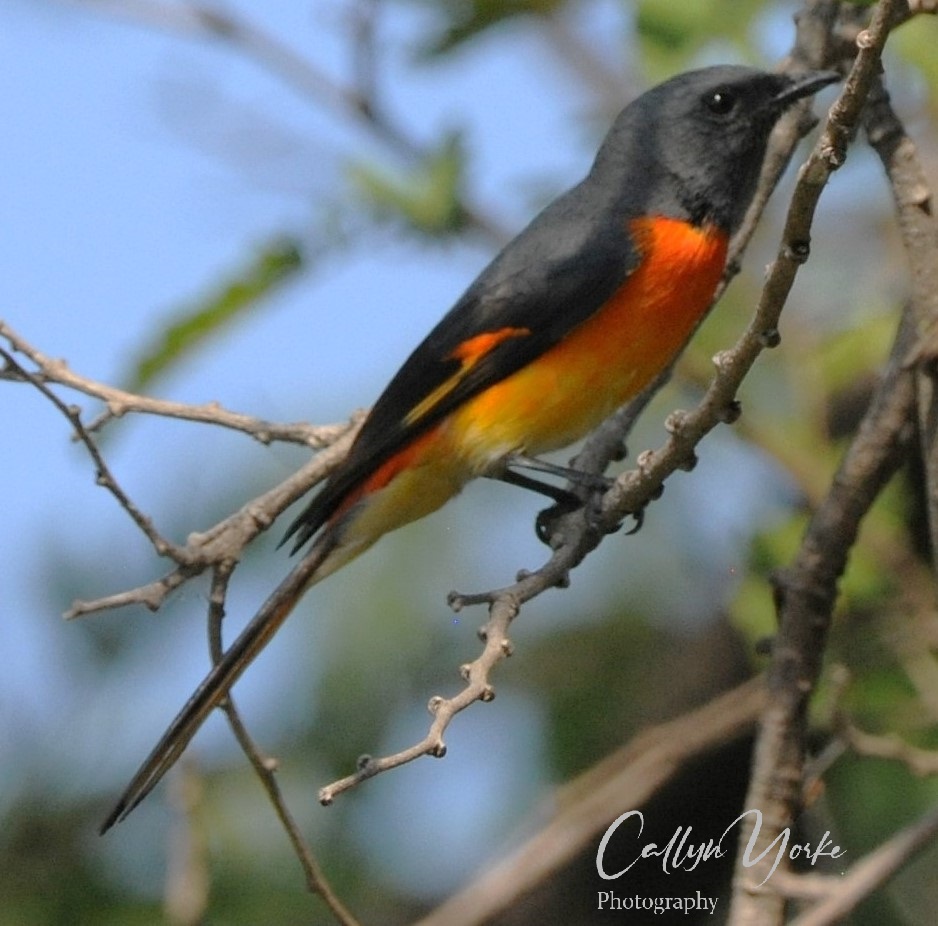
- Ashy Woodswallow Artamus fuscus 3 greg. sallying from utility wire next to marsh, outside of park, ne, C
- Common Iora Aegithina tiphia 2 (m,f) greg. pairs in a casuarina windrow (ne) and fruitng deciduous trees, C
- Sunda Pied Fantail Rhipidura javanica 20 vocal (calls and song), greg. individuals and pairs foraging in leaf litter, sallying to ground and lawns from low limbs of trees and shrubs, C, ubiq. (photo – see Introduction).
- Black Drongo Dicrurus macrocercus 2 greg. individuals and pairs sallying from 3-4m agl on outer limbs of leafless deciduous trees at the edge of clearings, C (photo).
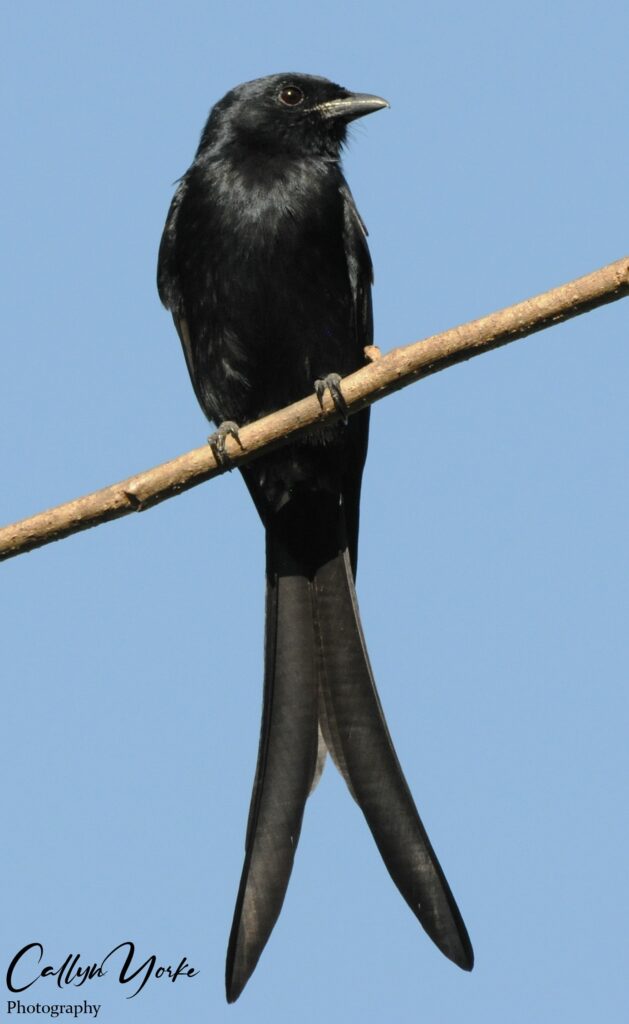
- Sooty (Ashy) Drongo Dicrurus leucophaeus 2 individuals sallying from 3-4 m agl on outer limbs of deciduous trees, C
- Black-naped Monarch Hypothymis azurea 2 (m,f), ah, in lower, middle and subcanopy of shady garden-woodland, UC
- Oriental Paradise Flycatcher Terpsiphone affinis 1 (f) at 3m agl in a casuarina windrow, ne, UC
- Northern Brown Shrike Lanius cristatus 1 perched 1.5 -3m agl in shrubs and trees at edge of clearings, C
- Eastern Large-billed Crow Corvus macrorhynchos levaillantii 6 vocal, loosely gregarious, wary and shy; individuals and pairs flying 5-20m agl around park, sometimes alighting on utility wires and high metal towers, C (photo).
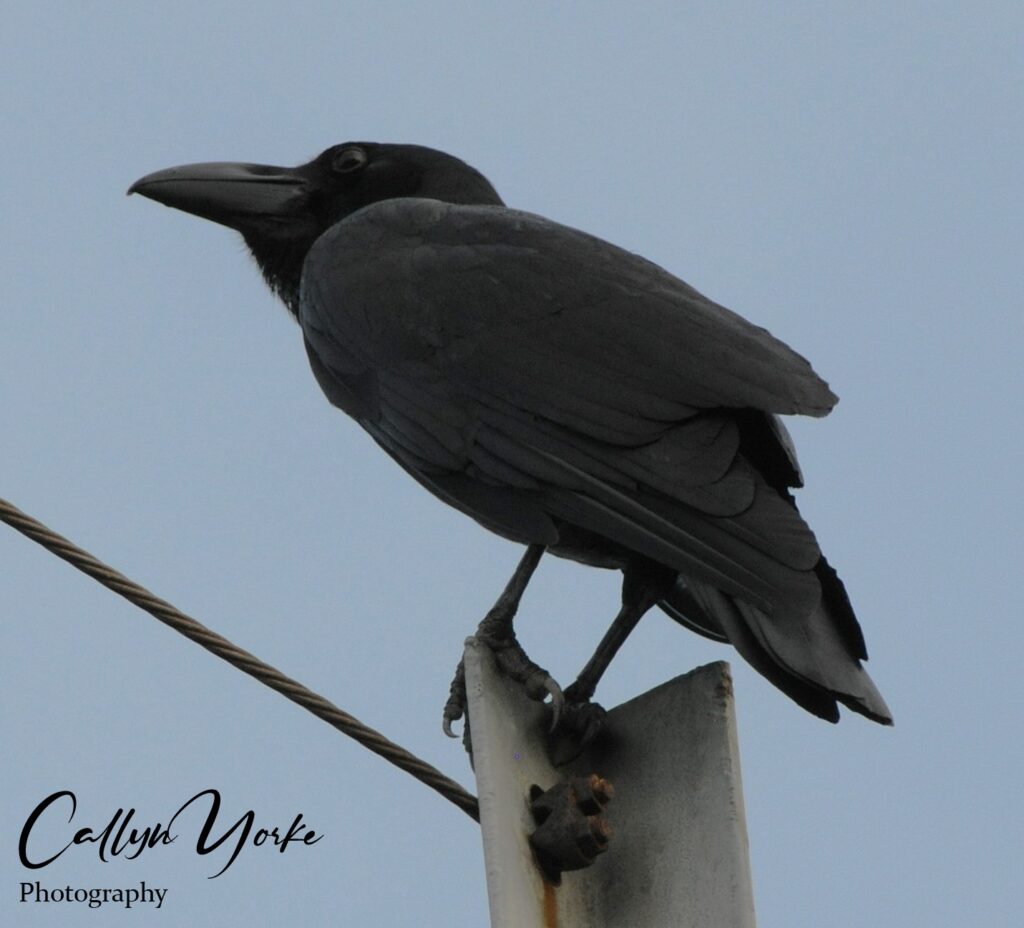
- Cisticola sp.? 1 calls heard; seen briefly in tall grassland-marsh outside the park, ne, UC
- Yellow-bellied Prinia Prinia flaviventris 5 vocal, greg. pairs in gardens with flowering shrubs; also in grassland-marsh outside the park, ne, C
- Plain Prinia Prinia inornata 3 greg. a pair active in garden flowerbed next to the arboretum, C (photo).
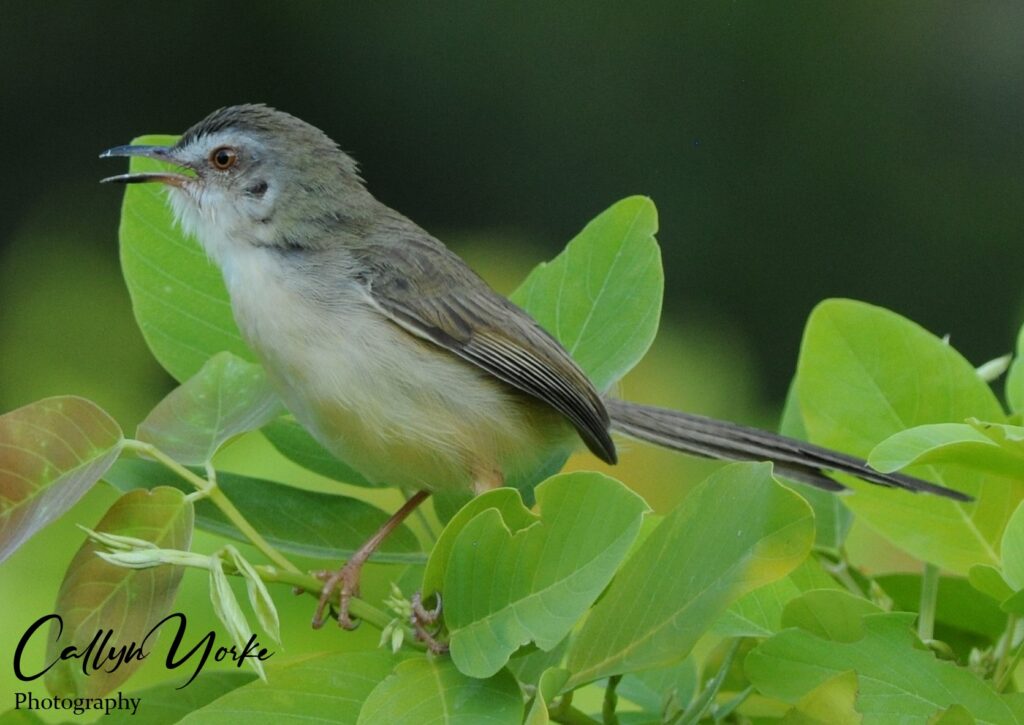
- Barn Swallow Hirundo rustica 5 greg. flying low, just above the lake surface; also 20-30 m agl over open areas, C
- Yellow-vented Bulbul Pycnonotus goiavier 6 vocal, greg. in trees and tall shrubs at the edge of clearings, e, C
- Streak-eared Bulbul Pycnonotus conradi 12 vocal, greg. in shrubs and trees, C, ubiq.
- Yellow-browed Warbler Phylloscopus inornatus 5 vocal (calls) greg. pairs and individuals ig in a wide variety of trees at all height levels, C, ubiq.
- Phylloscopus sp. ? cf. borealis 1 moving quickly in canopies of the tallest deciduous trees, UC
- Black-collared Starling Gracupica nigricollis 2 on lawn under large tree next to the main lake, UC (photo).
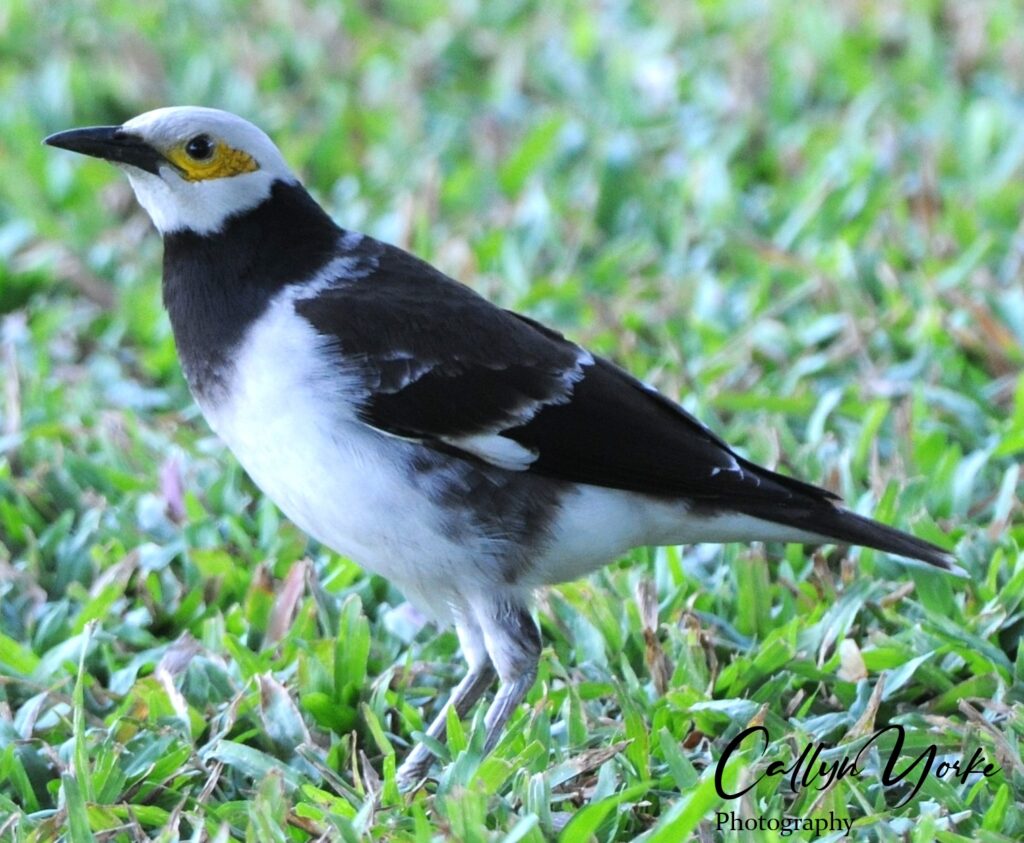
- Common Myna Acridotheres tristis 50 vocal, greg. mostly seen on ground and lawns, C, ubiq.
- Great Myna Acridotheres grandis 16 vocal, greg. in tree canopies and foraging on lawns, bare ground, often loosely associated with COMY, C, ubiq.
- Oriental Magpie Robin Copsychus saularis 40 (m,f) vocal, greg. pairs foraging near water on ground and lawns; vocal in trees, C, ubiq. (photo).
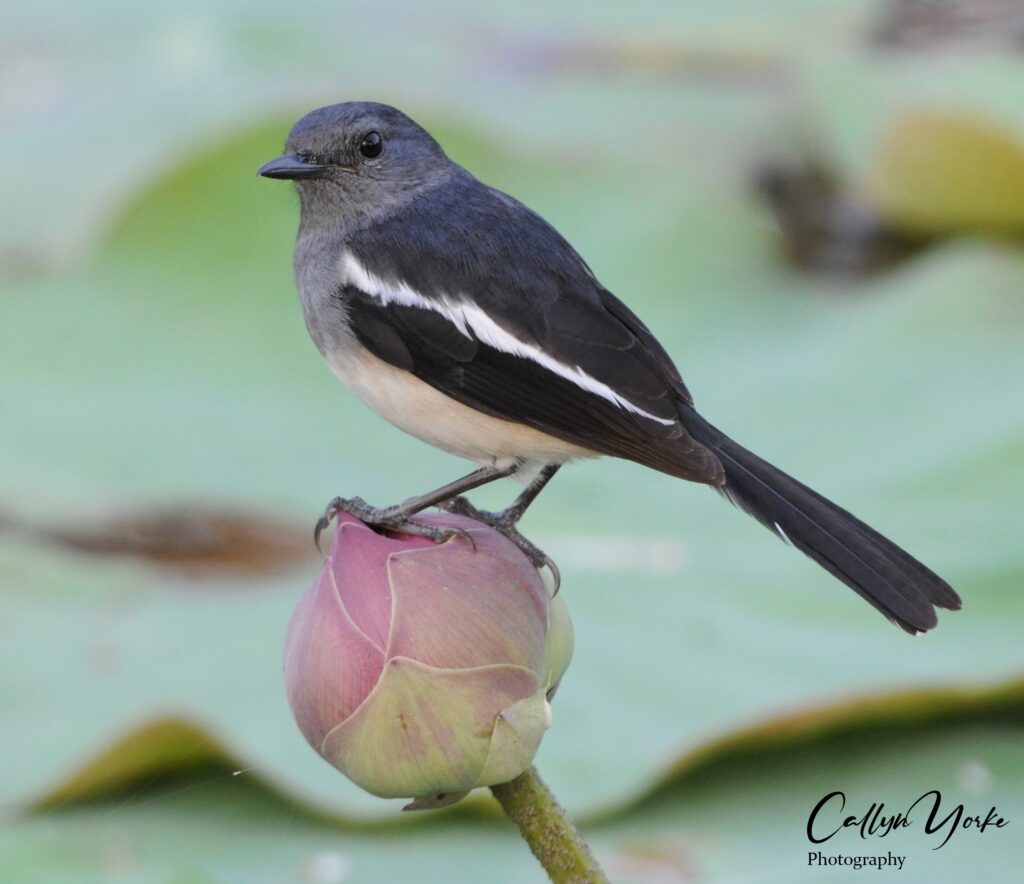
- Dark-sided Flycatcher Muscicapa cacabata 1 perched at 5m agl in outer tree canopy, UC
- Asian Brown Flycatcher Muscicapa dauurica 3 ah, sallying from outer limbs, 2-7 m agl of trees at edge of clearings, C
- Ficedula sp. ? cf. albicilla 1 fem. sallying to lawn from shrub perch next to a canal, n, UC (photo).
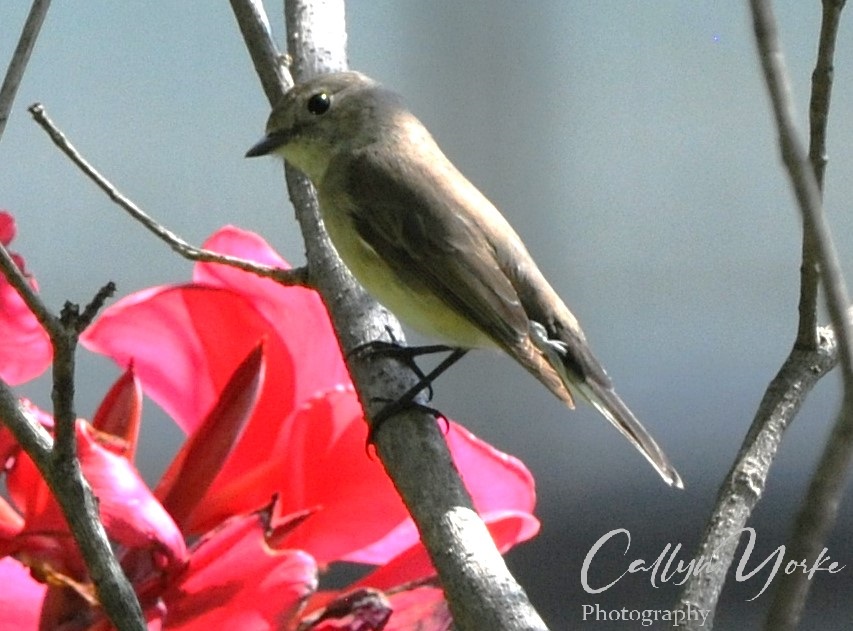
- Scarlet-backed Flowerpecker Dicaeum cruentatum 3 (m,f) vocal, tree canopies, C, ubiq.
- Olive-backed (Ornate) Sunbird Cinnyris ornatus 5 (m,f) vocal, active in a wide range of vegetation 1- 10 m agl, but mainly floweing/fruiting trees, C, ubiq.
- Brown-throated Sunbird Anthreptes malacensis 1 (m) mid-level of outer deciduous tree foliage, UC
- Asian Golden Weaver Ploceus hypoxanthus 5 (m,f) greg. foraging on seeds in tall grass at edge of clearings in grassland-marsh outside of park, ne, C (photo – see Introduction)
- Scaly-breasted Munia Lonchura nisoria 8 (m,f) greg. in tall grass and marsh, C, ubiq.
- Indian (House) Sparrow Passer indicus 10 (m,f) vocal, greg., often seen on buildings, ground and pavement, usually apart from the closely related, numerically dominant EUTS, C (photo).
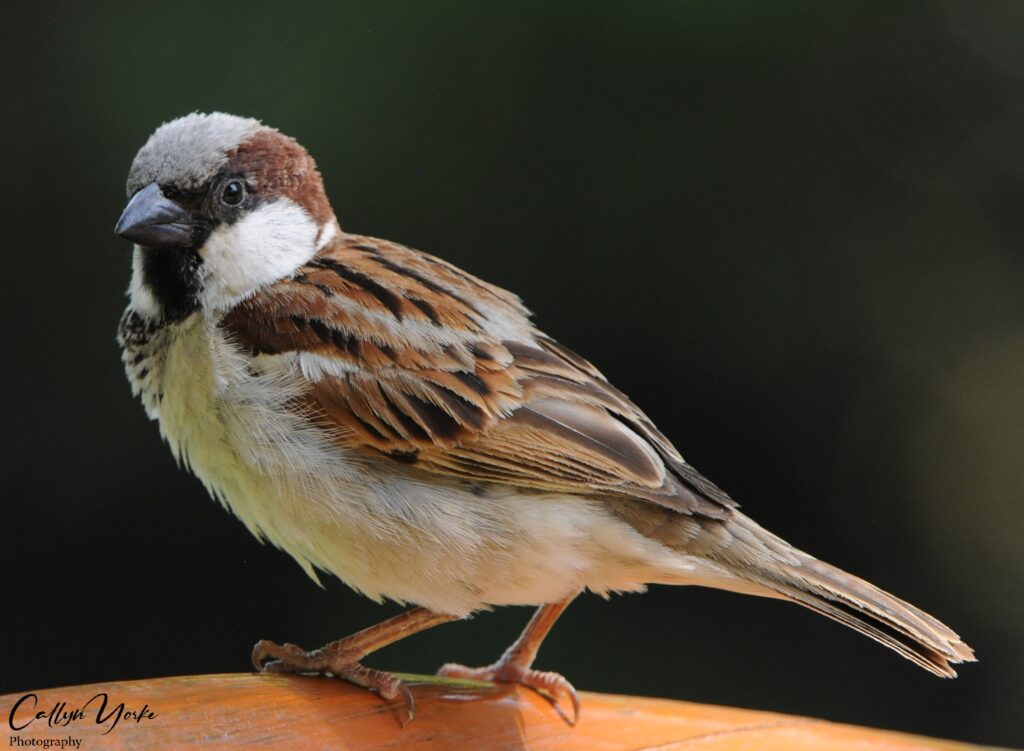
- Plain-backed Sparrow Passer flaveolus 3 greg. pairs and individuals seen on utility wires and in trees; not found to associate with the closely related INSP or EUTS C
- Eurasian Tree Sparrow Passer montanus 25 (m,f) vocal, greg. on buildings, ground, lawns and in frequently flushed to trees; one pair constructing a nest under the metal light cover of a path pole light, C, ubiq.
- Forest Wagtail Dendronanthus indicus 1 flew to a horizontal limb, 5 m agl, of a large garden tree in a residential yard adjacent to the swamp forest, s-central, UC
- Paddyfield Pipit Anthus rufulus 6 loosely greg. individuals and pairs walking/foraging on large, short-grass fields, flying 10-20 m away when flushed, C
- Eastern Yellow Wagtail Motacilla tschutschensis 1 foraging quickly, with much tail-bobbing, on the muddy and rocky shores of large and small ponds, C ____________________________________________________________________________
2. Atta Lakeside Resort-Kirimaya Golf Course, Nakhon Ratchasima, Thailand (Elevation 355 m asl).
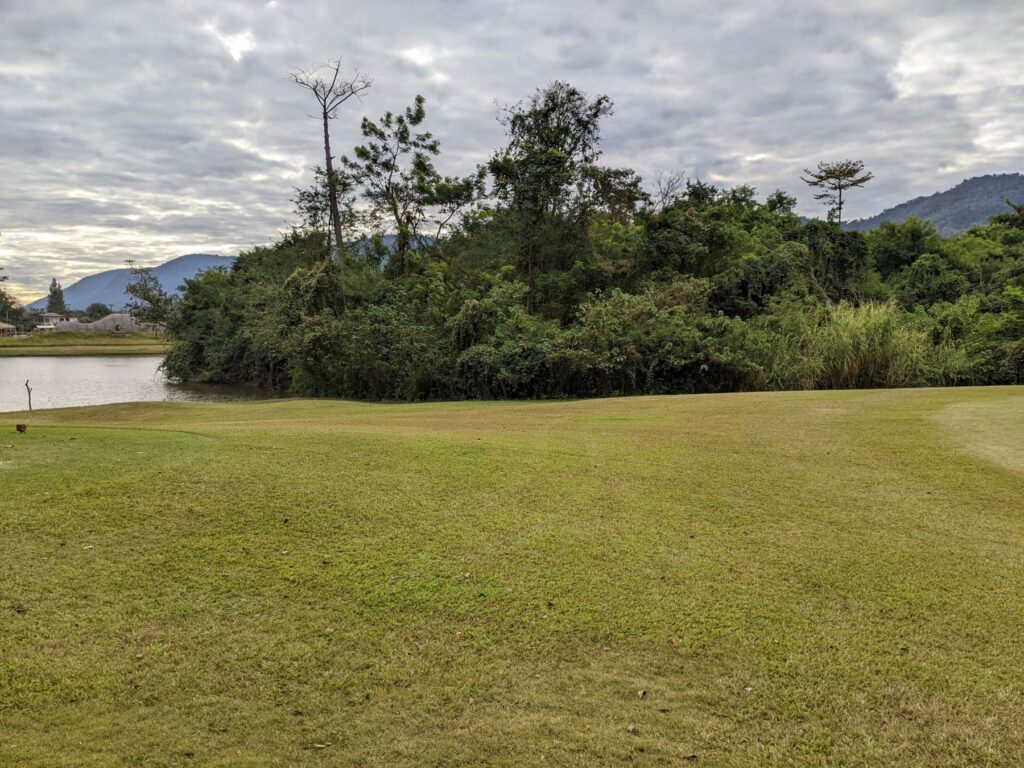
While in residence the Atta Lakeside Resort (January 3-10, 2023), I made four morning bird surveys, varying from 2-5 hours (Jan. 4,7,8,10: 0600-1200 hrs.) and four afternoon bird surveys varying from 2-5 hours (Jan. 3,5, 8,9: 1200-1730 hrs.). Surveys were made on foot, walking slowly on paved and unpaved roads, golf-cart paths, driveways and woodland trails around and through the Atta Lakeside Resort (ALR) and adjacent Kirimaya golf course (KGC). I also covered adjacent ruderal fields and gardens; one afternoon survey was made in the Muthimaya Resort (MMR) complex (Jan. 8: 1200-1400 hrs.), located 3 km west of the Atta Lakeside Resort.
My survey route was variably a 3 to 5 km, clockwise route, beginning and ending at the east side of the Atta Lakeside Resort (Building 9, Room #9106). Habitats surveyed included, gardens, hedgerows, broad-leaved evergreen and deciduous tree windrows, parkland with dense riparian woodland dominated by mature flowering/fruiting trees – mostly exotic – in closed and open canopy configurations, i.e. bordering golf course fairways; secondary (native) forest and shrubland bordering fairways and roadways; savanna (i.e. mowed and un-mowed grassland, fallow fields, with scattered trees); artificial lakes, lotus-lily ponds, canals, drainages and marshes; small, disjunct wetlands in low-lying terrain; a trash dump (MMR); resort buildings, driveways and parking lots. Approximately 50 hectares was covered visually during most surveys.
The surveyed areas were usually quiet and undisturbed by human activities, except for the weekend of January 7-8, when the golf course was fully occupied. Birds appeared moderately habituated to human presence in and around the resort, though not nearly as approachable as those found in King’s Park Bangkok or the Khao Yai National Park headquarters.
As far as I could see, the resort was managed in an environmentally responsible way. Most, if not all of the kitchen produce, including chickens and eggs, were farmed organically; hydroponic greenhouses were used for growing leafy green vegetables in a dedicated agricultural section next to the Kirimaya golf course driving range. I did not find evidence of the use of herbicides or pesticides anywhere on the resort grounds.
Weather during the surveys varied from fair to heavily overcast; a light drizzle occurred on the morning of Jan. 10. Air temperature ranged from 17C to 27C. Winds were light (2 – 10 kph) from the northeast.

Annotated Bird List: Atta Lakeside Resort- Kirimaya Golf Course – Muthimaya Resort, Nakhon Ratchasima, Thailand, January 3 -10, 2023 Callyn Yorke
Abundance: Numbers following each species entry are the highest count for a single survey; Age, sex and molt (when known): ad = adult; imm = immature; m = male; f = female; bsc plmg = basic (non-breeding plumage; alt plmg = alternate (breeding) plumage.
Frequency and Distribution: C = Common, i.e. found during half or more of the surveys ; UC = found less than half but more than once during the surveys; R = found only once; ubiq. = ubiquitous in appropriate habitat.
Locations (see preceeding map): Atta Lakeside Resort, including gardens, parkland and water features = ALR; Kirimaya Golf Course, including adjacent fields, ponds, lakes and woodland = KGC; Muthimaya Resort, (surveyed only once on Jan. 8) including residential gardens, fallow fields, secondary forest, savanna and a dump = MMR.
Ecology and Behavior: aerial insect hawking (ah); taking fruit, berries or parts of flowers (fr); gleaning insects from foliage (ig); probing into surface (pr); estimated height (m) above ground (agl); gregarious (greg); mixed-species flock (msf).
Systematics and Nomenclature used herein, is an amalgam of Avibase, International Ornithological Congress (IOC) and current (2023) online resources, i.e. Birds of the World, Cornell University, USA.
- Red Junglefowl Gallus gallus 1 (m) foraging at the edge of secondary forest adjacent to a weedy field, R, KGC
- Feral Rock Pigeon Columba livia 20 greg. on roof and flying around, C, ALR
- Red-collared Dove Streptopelia tranquebarica 10 greg. on utility wires and in garden trees on an adjacent horse ranch, C, KGC
- Eastern Spotted Dove Spilopelia chinensis 8 vocal, greg. pairs in tall, leafless trees and on utility wires, C, ubiq.
- Zebra Dove Geopelia striata 20 vocal, greg. on ground and on utility wires, trees, C, ubiq.
- Greater Coucal Centropus sinensis 2 at the dump, MMR
- Green-billed Malkoha Phaenicophaeus tristis 2 a pair in garden tree next to driveway, R, ALR
- Western Koel Eudynamys scolopaceus 20 vocal, well concealed in trees, usually near water, C, ubiq.
- Plaintive Cuckoo Cacomantis merulinus 1 vocal, UC, KGC
- Germain’s Swiftlet Aerodramus germani 15 greg. flying 20 – 100m agl, lowest with heavy overcast skies, C, ubiq.
- Apus sp. ? cf. cooki 2-3 greg. flying 30-70 m agl, loosely associated with GESW; relatively long, sickle-shaped wings and forked tail; no obvious white rump or other contrasting marks were visible, R, ALR (photo).
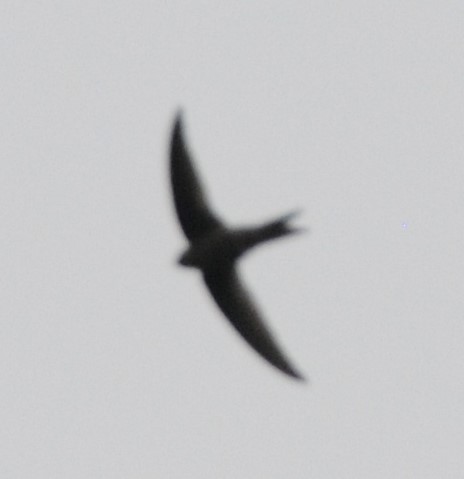
- Asian Palm Swift Cypsiurus balasiensis 10 greg. flying very fast, 20 -30m agl over open areas and lakeside, UC, ALR
- White-breasted Waterhen Amaurornis phoenicurus 2 secretive and shy; walking in grassy drainage and lily ponds, UC, KGC
- Ruddy-breasted Crake Zapornia fusca 1 seen briefly, taking cover in tall, wet vegetation of a drainage depression, R, KGC
- Black-necked (Red-wattled) Lapwing Vanella atronuchalis 60 vocal (when alarmed) greg. 5-7 birds at lakeside ALR; 50 + birds lakeside between roadway and KGC, C (photo).
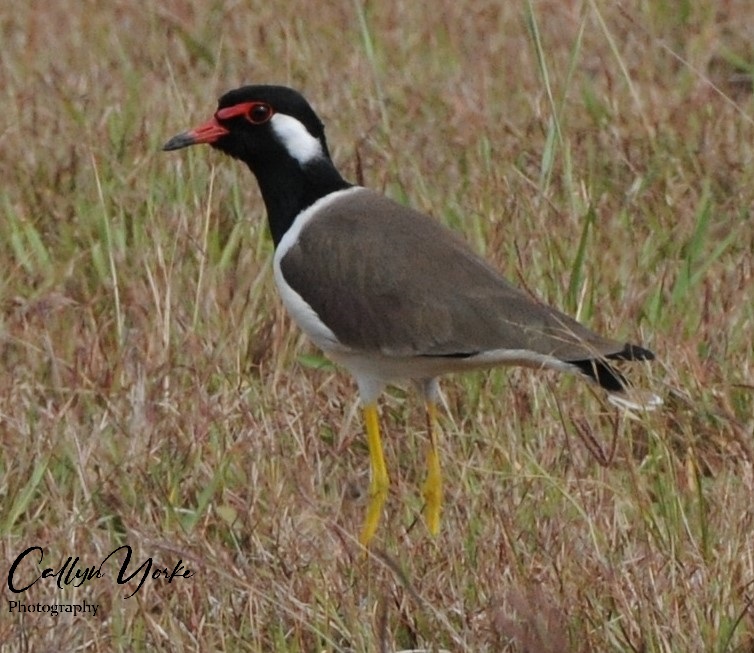
- Indian Cormorant Phalacrocorax fuscicollis 3 flying w at sunrise, 50m agl, UC, ALR
- Little Egret Egretta garzetta 3 individuals foraging in shallows at edge of lakes and ponds, C, KGC
- Eastern Cattle Egret Bubulcus coromandus 3 greg. foraging in fallow field, UC, KGC
- Pond-heron Ardeola sp. ? c.f. bacchus 12 (bsc. plmg., ad., imm.) loosely greg. vocal (when alarmed and in flight), foraging in a wide variety of wetlands and fallow fields, C, ubiq.
- Black-crowned Night Heron Nycticorax nycticorax 3 (1 ad, 2 imm) greg., appeared to occupy the same location for several days – a low-limb perch over large pond next to tee #1, C, KGC
- Black-winged Kite Elanus caeruleus 1 hovering at 30m agl over adjacent pasture at sunrise (8 Jan.), R, ALR
- Rufous-winged Buzzard Butaster liventer 1 (ad) perched at 15 m in leafless tree at the edge of a large, roadside field (4 Jan.), R, KGC
- Crested Goshawk Accipter trivirgatus ? 1 ID: a relatively large, bulky, Accipiter profile when perched; in flight showing variegated dark brown coloration, broad wings, flying low between trees in at woodland -open field edge, UC, KGC
- Eurasian Hoopoe Upupa epops 6 individuals and pairs foraging on lawns, C, KGC (photo – see Introduction).
- Chestnut-headed Bee-eater Merops leschenaulti 5 greg. sallying 1m – 10 m agl from utility lines and outer tree limbs, C, ubiq. (photo).
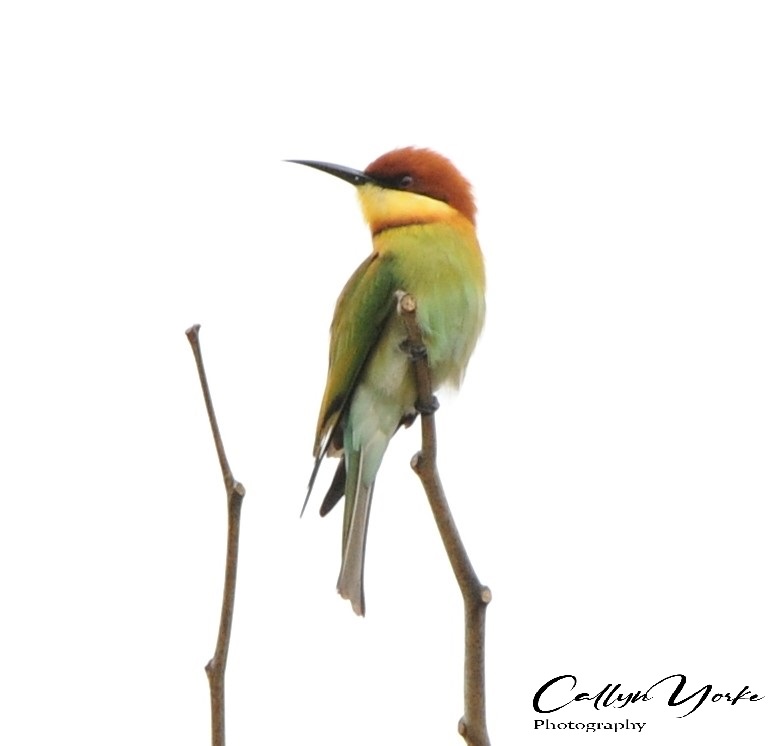
- Indochinese Roller Coracias affinis 4 individuals and pairs perched 3-5m agl in trees, sometimes sallying to lawns and fence perches, C, ubiq.
- Common Kingfisher Alcedo atthis 1 perched on emergent stick at edge of pond, then flying low over pond surface, UC, KGC
- White-throated Kingfisher Halcyon smyrnensis 1 vocal, perched on low limb overhanging a pond, UC, KGC
- Coppersmith Barbet Psilopogon haemacephalus 2 vocal, in tall flowering/fruiting trees at the woodland edge, C, KGC
- Lineated Barbet Psilopogon lineatus 6 vocal, greg. in tall, leafless trees, with and without flower/fruit, C, ubiq.
- Eastern Black-naped Oriole Oriolus diffusus 2 greg. pairs in flowering/fruiting trees, C, KGC
- Rosy Minivet Pericrocotus roseus 2 (m,f) a pair ig msf with BWFS and YBLW in vine-covered woodland edge, R, KGC
- Ashy Woodswallow Artamus fuscus 15 greg. on utility wires and outer limbs of leafless trees adjacent to clearings, C, ALR (photo – see Introduction)
- Bar-winged Flycatcher-shrike Hemipus picatus 2 in msf with ROMI and YBLW, sallying out from a vine-covered tree at the edge of secondary woodland and shrubs, R, KGC
- Common Iora Aegithina tiphia 2 (m,f) greg. a pair ig in mid to upper level of broad-leaved deciduous trees at woodland edge, UC, KGC
- Ashy Drongo Dicrurus leucophaeus 2 greg. mid-to upper level of secondary woodland edge, UC, KGC
- Hair-crested Drongo Dicrurus hottentottus 16 vocal, greg. foraging on large orange blossoms in tall, ornamental tree; sallying for insects at dump, C, ubiq (photo).
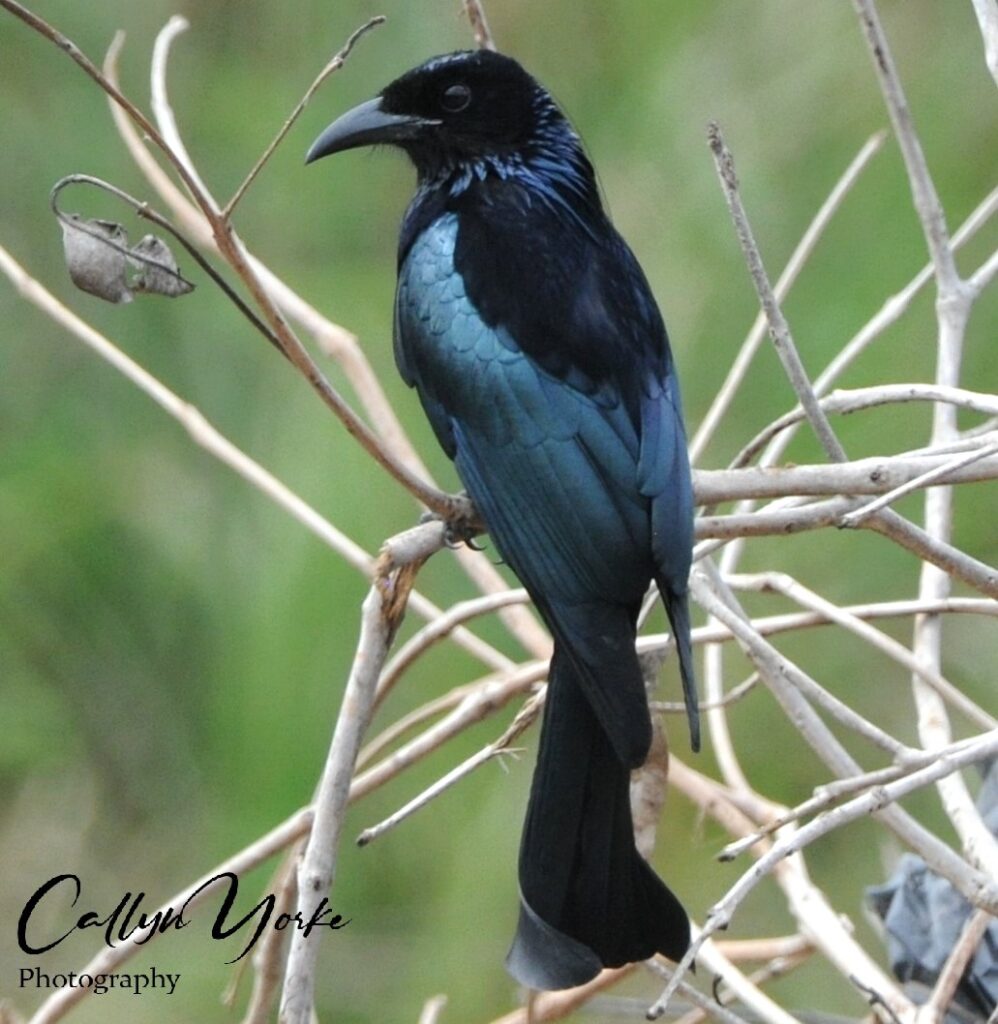
- Greater Racquet-tailed Drongo Dicrurus paradiseus 8 vocal, greg. a small, noisy flock in the woods, taking flight to an adjacent woodland bordering a fairway, R, KGC
- Black-naped Monarch Hypothymis azurea 2 (m) in a msf with COTA and GHCF in the understory of a dense woodland bordering a fairway, R, KGC
- Northern Brown Shrike Lanius cristatus 1 perched on a small, leafless shrub in an adjacent pasture, UC, ALR
- Eastern Large-billed Crow Corvus macrorhynchos levaillantii 2 vocal, greg., individuals and pairs flying 15-20m agl over the area, but not seen lingering on the property, C, ubiq.
- Gray-headed Canary-flycatcher Culicicapa ceylonensis 1 sally-flycatching from a conspicuous, outer limb perch, 3-4m agl in large deciduous trees, 3 -5 m agl in msf with other, small insectivorous birds, e.g., BWFS and BNMO, UC, KGC
- Indochinese Bushlark Mirafra erythrocephala 5 greg. in fallow, weedy fields, keeping low and well concealed; flying 10-20 m when flushed, sometimes to an exposed perch C, KGC (photo).
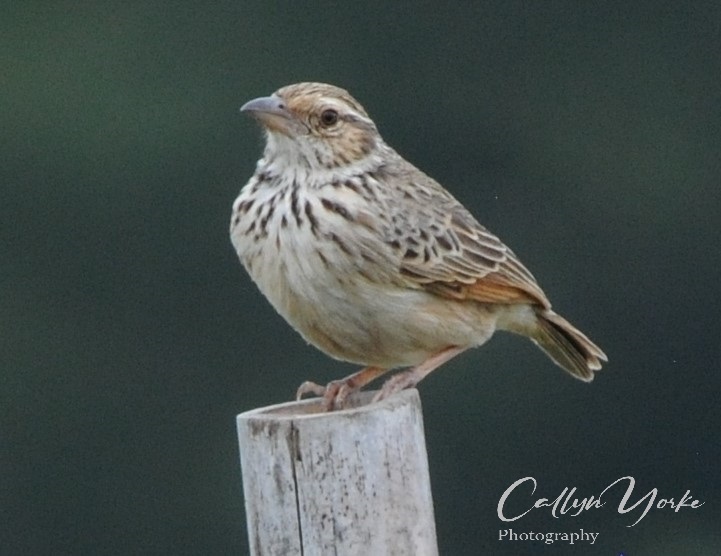
- Common Tailorbird Orthotomus sutorius 5 vocal, active in dense shrubs, gardens and woodland edge, C, ubiq.
- Yellow-bellied Prinia Prinia flaviventris 3 vocal, greg. pairs in tall grass at edge of wetlands, C, KGC
- Zitting Cisticola Cisticola juncidis 3 vocal (calls), active in weedy, fallow fields with islated clumps of tall grass and shrubs, often near water, C, KGC (photo).
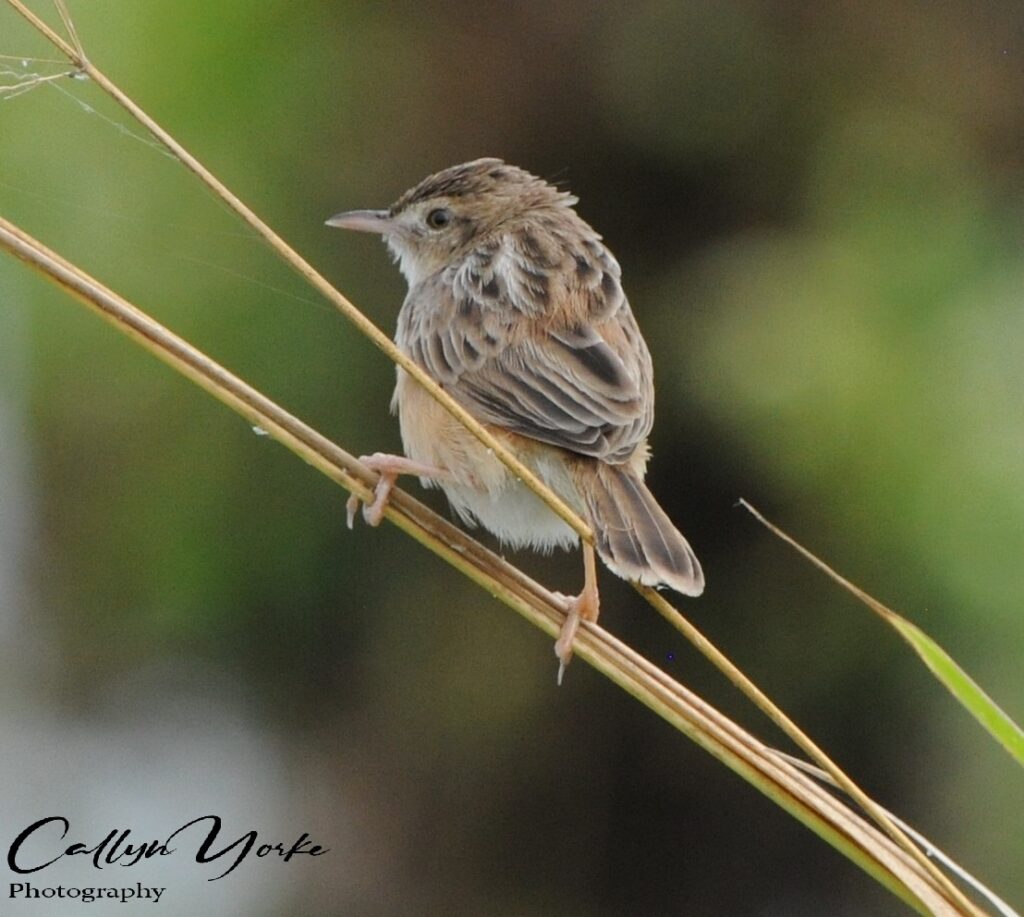
- Eurasian Barn Swallow Hirundo rustica 4 greg. flying 5-50 m agl over wetlands and open areas, C, ubiq.
- House Swallow Hirundo javanica 3 greg. flying 1-5m agl over dump, MM
- Red-rumped Swallow Cercropis daurica 12 greg. on utility wires and flying 8 – 20m agl over open areas, C, ubiq.
- Black-crested Bulbul Pycnonotus flaviventris 2 vocal, greg., 4 m agl in large tree at edge of organic farm, R, KGC
- Northern Sooty-headed Bulbul Pycnonotus chrysorrhoides 3 vocal, greg. in garden trees, UC, KGC
- Stripe-throated Bulbul Pycnonotus finlaysoni 2 greg. a pair at the edge of second-growth woodland, UC, KGC
- Streak-eared Bulbul Pycnonotus conradi 5 vocal, greg. in garden trees and tall shrubs at edge of woodland, C, ubiq.
- Yellow-browed Warbler Phylloscopus inornatus 6 greg. often in pairs, ig on decidous tree foliage, C, ubiq.
- Dusky Warbler Phylloscopus fuscatus 1 on and near the ground in shady, dense streamside woodland, msf with BNMO, GHCF and COTA, R, KGC
- Arctic Warbler Phylloscopus borealis 1 alone and in msf with YBWA, ig on foliage of deciduous trees, UC, KGC
- Zosterops sp. ? cf. simplex 3 vocal, greg. in flowering garden trees, UC, ALR
- Chestnut-tailed Starling Sturnia malabarica 7 greg. feeding on large, orange blossoms in tall ornamental tree with GRMY and HCDR, UC, KGC
- Common Myna Acridotheres tristis 60 vocal, greg. foraging on lawns, bare ground and pavement, C, ubiq.
- Great Myna Acridotheres grandis 70-100 (est.) vocal, greg. on lawns, fallow fields, in gardens; also foraging on large orange blossoms in ornamantal trees, often with HCDR and sometimes, LIBA; multiple small flocks of 5-10 individuals commuting over property at dawn and dusk, C, ubiq.
- Eyebrowed Thrush Turdus obscurus 1 perched atop a large ornamental tree for several minutes, R, KGCs
- Oriental Magpie Robin Copsychus saularis 5 (m,f) vocal pairs active in gardens, on lawns and adjacent trees, C, ubiq.
- Verditer Flycatcher Eumyias thalassinus 2 (m,f) active at edge woodland around vine-covered trees; msf with BWFS, UC, KGC
- Red-throated (Taiga) Flycatcher Ficedula albicilla 3 (imm) individuals sallying to lawns and bare ground from low perch, 1 – 2 m agl, C, ubiq.
- Amur Stonechat Saxicola stejnergeri 1 (bsc. plmg.) flushed to a conspicuous perch in a fallow field with scattered shrubs, MM (photo).
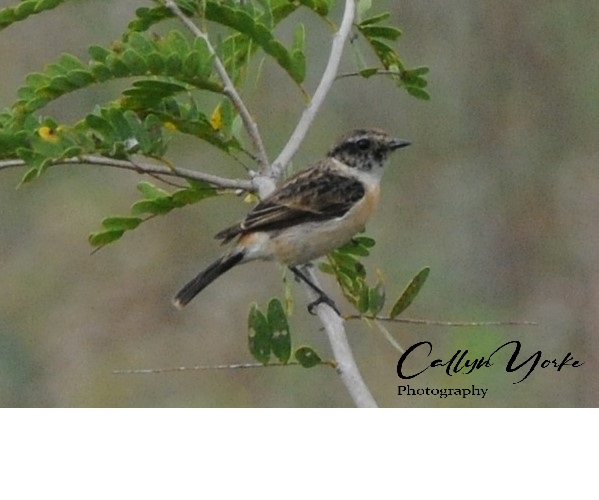
Saxicola sp.? 1 ID: overall, distinctly paler than another individual photographed on 8 January at MMR (see previous entry), and a fairly close match for the extralimital S. insignis; flushed on two separate days to a clump of tall grass in the same fallow field, UC, KGC (photo).
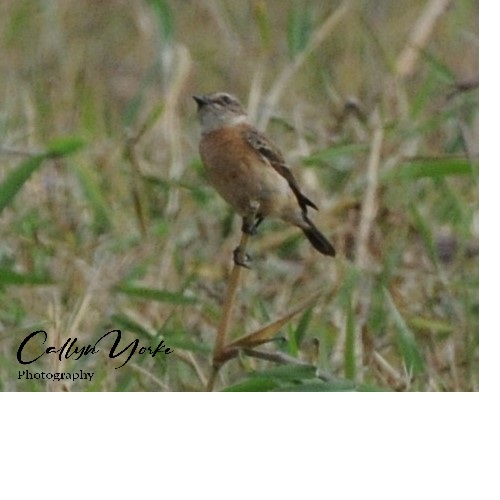
- Pied Bushchat Saxicola caprata 2 (m,f) individuals perched on posts, leafless shrubs, and on a utility wires in an adjacent pasture, UC, ALR
- Scarlet-backed Flowerpecker Dicaeum cruentatum 1 (m,f) vocal in garden trees, C, ALR
- Ornate (Olive-backed) Sunbird Cynnyris ornatus 4 (m,f) vocal, greg. pairs in garden trees, C, ubiq.
- Scaly-breasted Munia Lonchura nisoria 5 (m,f, ad., imm) vocal, greg. feeding on grass seeds in gardens and edges of fallow fields, C, ubiq.
- Plain-backed Sparrow Passer flaveolus 3 (m,f) greg. on utility wires and in garden trees, UC, KGC
- Eurasian Tree Sparrow Passer montanus 20 (m,f) vocal, greg. feeding on lawns, in gardens and edge of ruderal fields, C, ubiq.
- Gray Wagtail Motacilla cinerea 1 on rocks and pavement around artificial ponds, also on low, flat roof tops, C, ALR
- Paddyfield Pipit Anthus rufulus 5 greg. individuals and pairs in short- grass ruderal fields, fairways and large lawn areas, C, ubiq.
___________________________________________________________________
3. Khao Yai National Park Visitor Center and Adjacent Areas, Nakhon Nayok, Thailand (Elevation, 680 m asl)
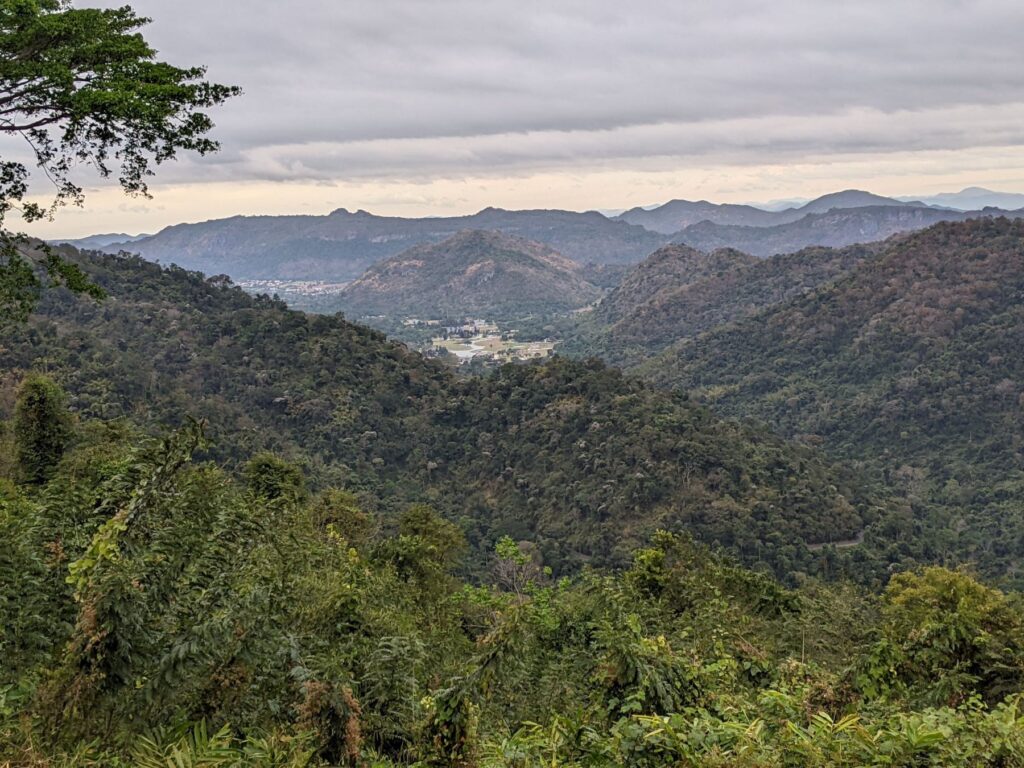
I made a total of four morning surveys in Khao Yai National Park (KYNP): January 5,6,7 & 9, 2023, largely within a 0.50 km radius of the Park Headquarters and Visitor Center (see accompanying map). Brief, drive-by surveys with occasional stops, were made while commuting on the main park road (2090) between the KYNP Headquarters and the north entrance gate.
My surveys around the visitor center were divided between stationary observations from the parking lot, bridge and outside deck behind the gift shop (about 3/4 of the observation time), and short walks around the area, including the Kong Kaeo Waterfall trail loop (1.2 km) and a short distance (0.25 km) on a forest trail behind the food stalls (see the previous Introduction for additional details).
Surveys were completed within the time frame of 0717 hrs. to 1330 hrs., excluding drive time (about 20-minutes between the north entrance gate and KYNP Visitor Center). The survey of January 7 (0715-0912 hrs.) was abbreviated due to a scheduling issue with the rental car agency.
Multiple bird tour groups frequented the Visitor Center area; I sometimes obtained information from them regarding local sightings, and vice-versa. Increasing numbers of visitors began arriving around 0830 hrs. and by 1200 hrs. the parking lots were full. Except on January 6 (0720- 1330 hrs.) I left the park before 12 noon each day.
Weather during the surveys was fair to partly cloudy, 16C to 19 C; NNE winds 5- 20 kph.
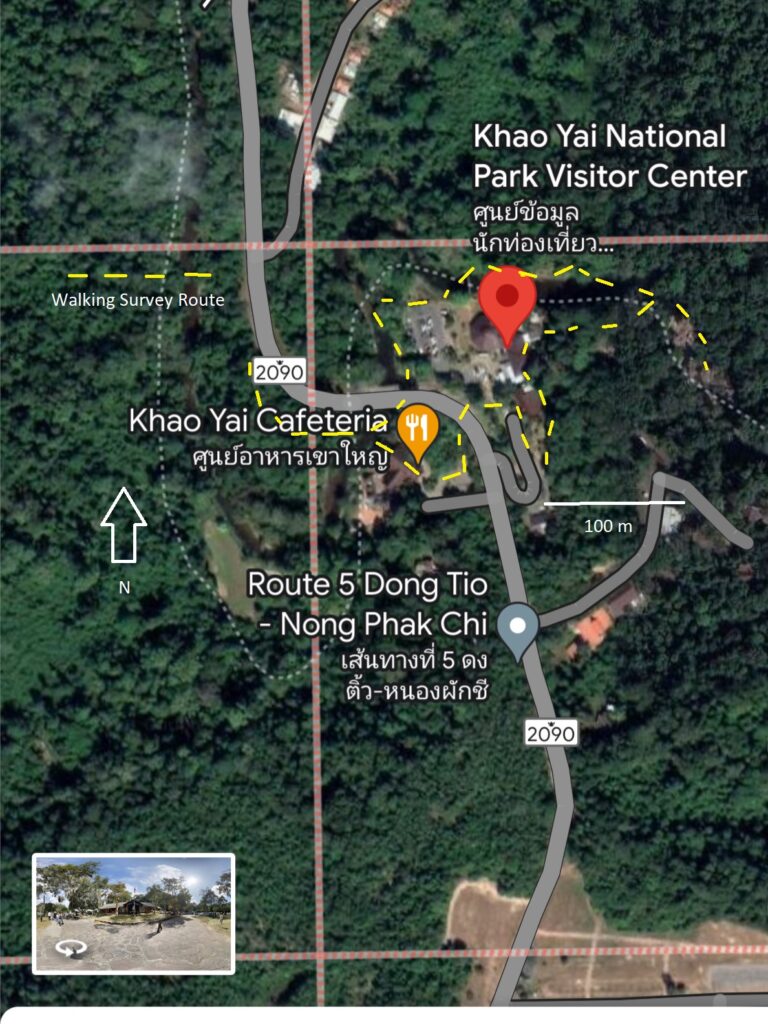
Annotated Bird List: Khao Yai National Park, Visitor Center and Surrounding Area, Nakhon Nayok, Thailand, January 5-9, 2023 Callyn Yorke
Abundance: Numbers following each species entry are the highest count for a single survey; Age, sex and molt (when known): ad = adult; imm = immature; m = male; f = female; bsc plmg = basic (non-breeding plumage; alt plmg = alternate (breeding) plumage.
Frequency and Distribution: C = Common, i.e. found during half (2/4) or more of the surveys ; UC = found only once during the surveys; ubiq. = ubiquitous in appropriate habitat.
Ecology and Behavior: aerial insect hawking (ah); taking fruit, berries or parts of flowers (fr); gleaning insects from foliage (ig); probing into surface (pr); estimated height (m) above ground (agl); gregarious (greg); mixed-species flock (msf).
Systematics and Nomenclature used herein, is an amalgam of Avibase, International Ornithological Congress (IOC) and current (2023) online resources, i.e. Birds of the World, Cornell University, USA.
- Red Junglefowl Gallus gallus 1 (m) foraging on forested side of main road, UC
- Eastern Spotted Dove Spilopelia chinensis 2 greg. a pair on the ground in the parking lot, C
- Large Hawk Cuckoo Hierococcyx sparverioides 1 treetop perch, lower trail, UC
- Asian palm Swift Cypsiurus balasiensis 5 greg. flying 5-25 m agl over forest and clearings, C
- White-breasted Waterhen Amaurornis phoenicurus 1 walking along stream bank, UC
- Little Cormorant Microcarbo niger 2 flying over forest canopy near stream, UC
- Pond-heron Ardeola sp. ? c.f. bacchus 2 (ad. bsc. plmg.) streamside, C
- Crested Serpent Eagle Spilornis cheela 1 (ad) flying 20m agl over streamside forest clearing, UC
- Buffy Fish Owl Ketupa ketupa 2 one adult perched on the same limb in subcanopy of mango-type tree for several consecutive mornings (photo – see Introduction); a nest nearby in another, streamside tree, was largely obscured by fern epiphytes but apparently contained at least one juvenile according to local guides; all I could see in the nest was an adult plumaged wing, suggesting the other adult of the pair was also in the nest, C.
- Oriental Pied Hornbill Anthracoceros albirostris 2 greg. a pair flew to a fruiting fig tree overhanging the Visitor Center observation deck; the birds were hopping among the canopy limbs, taking fruits for a period of about 30 minutes, UC (photo).
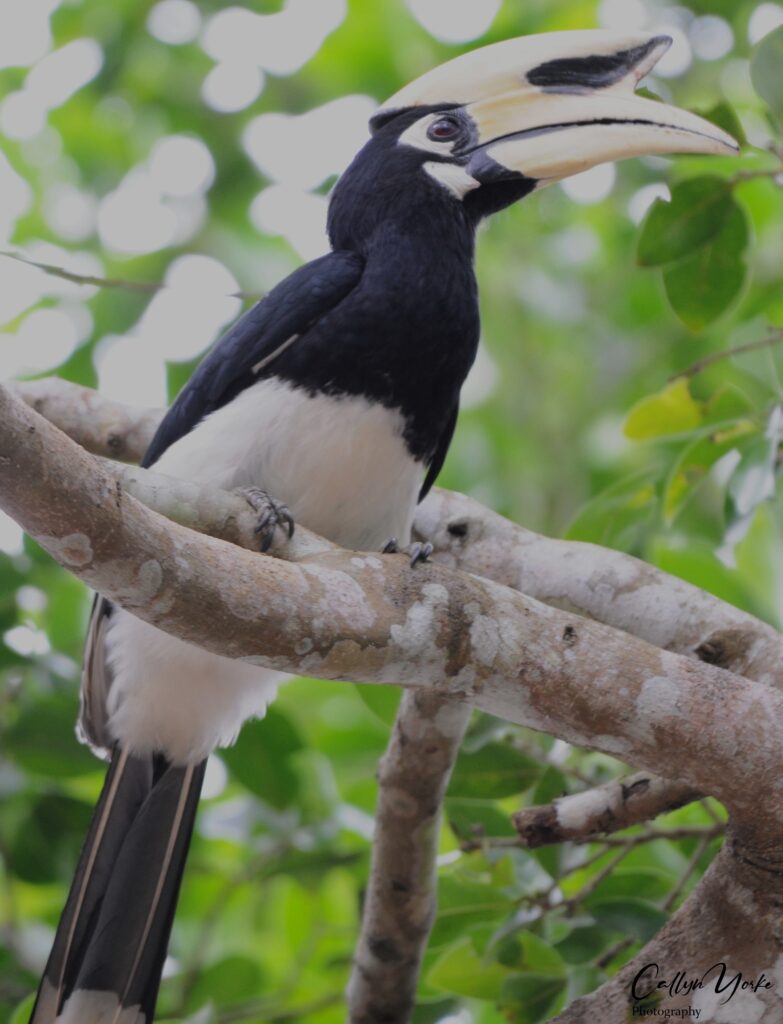
- Blue-bearded Bee-eater Nyctyornis athertoni 2 greg. a pair, alternately entering a streambank nest cavity in a shallow embankment; each bird hesitated and looked around for a few moments before entering head-first, using its feet for a brief excavation, then disappearing inside. During my observations of about 20-minutes while seated on the opposite stream bank, about 10 m away, a second bird entered the nest cavity in the same manner (photo); neither bird was observed to exit the nest cavity and no other sign of the birds was seen or heard, UC.
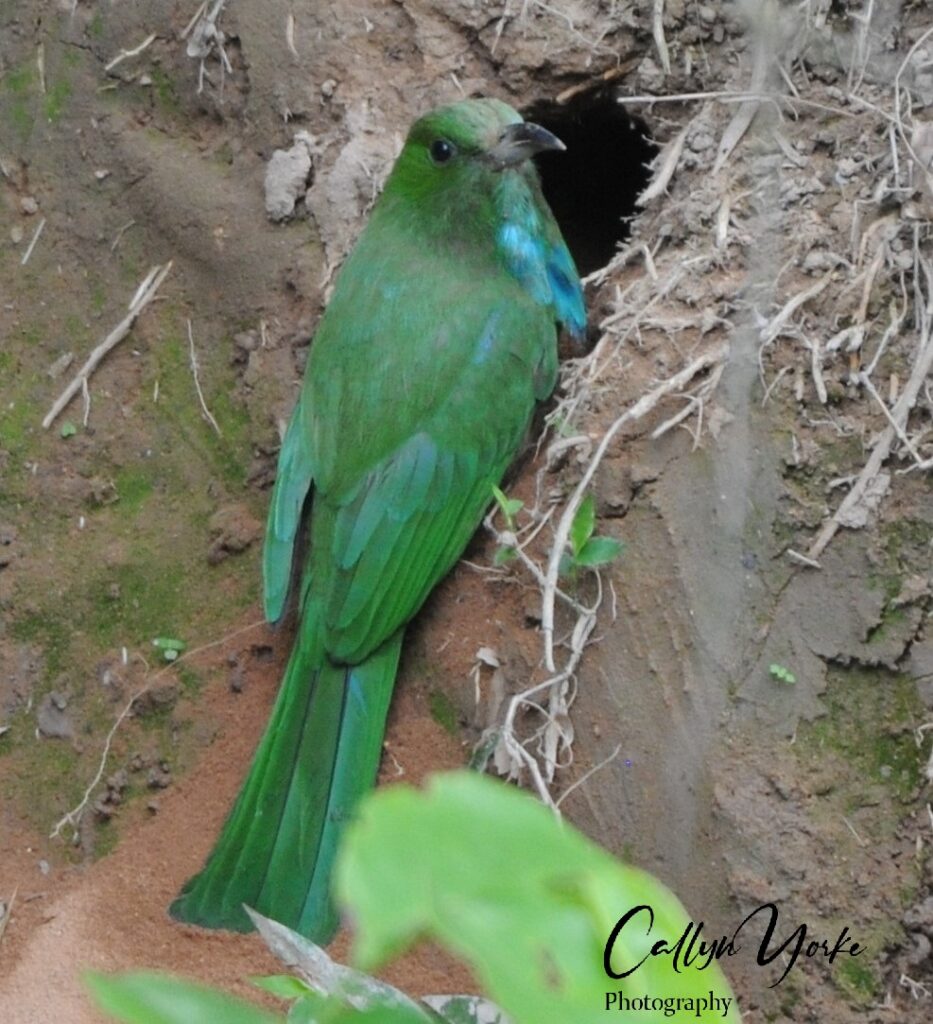
- White-throated Kingfisher Halcyon smyrensis 1 vocal, flying low upstream, UC
- Common Kingfisher Alcedo atthis 1 (m) diving, with about a 20% success freq., for small fish from a streamside perch 0.2 m – 0.5 m above the water surface, C (photo).
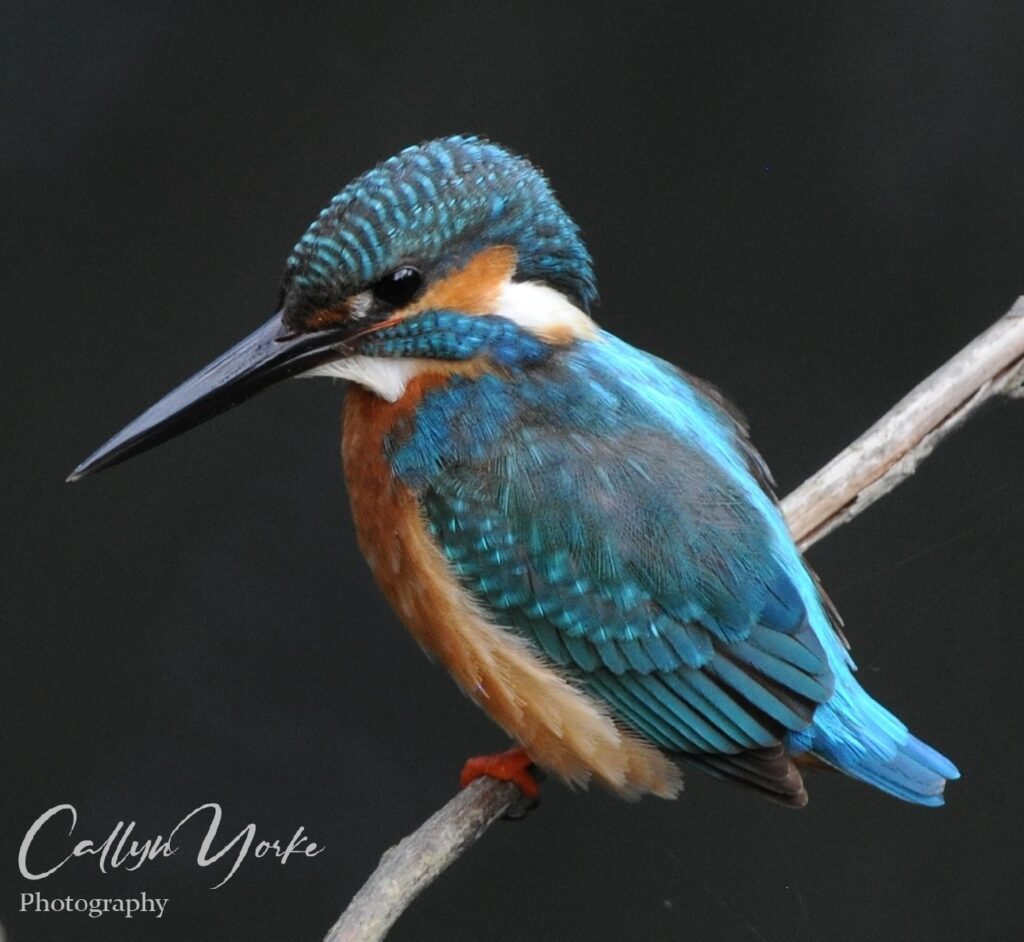
- Blue-eared Barbet Psilopogon cyanotis 2 vocal, greg. foraging in fruiting fig tree above the VC observation deck, C
- Green-eared Barbet Psilopogon faiostrictus 2 vocal at forest-streamside edge, C
- Moustached Barbet Psilopogon incognitus 1 vocal (unseen) streamside forest, C
- Great Slaty Woodpecker Mulleripicus pulverulentus 1 seen briefly perched 3 m agl on large-diameter streamside forest tree; seen flying away at same height; a series of unidentified woodpecker-drumming sounds preceded this sighting – a low-pitched, hollow tapping, not unlike the croaking of a large tree flexing in the wind, UC
- Long-tailed Broadbill Psarisomus dalhousiae 2 greg. a pair perched cozily together on a horizontal limb at 5m agl in the shady forest edge next to the VC parking lot, UC (photo – see Introduction frontispiece).
- Scarlet Minivet Pericrocotus speciosus 2 (m,f) in msf with BWCS and ASMI, BRMI at forest edge in vine-tangled trees, 4-5 m agl, UC
- Ashy Minivet Pericrocotus divaricatus 4 in a msf with BRMI, ROMI, BWCS, BWCS and others, in and out of a vine-tangled forest edge above the stream, C
- Brown-rumped Minivet Pericrocotus cantonensis 5-6 with the msf described previously, C (photo).
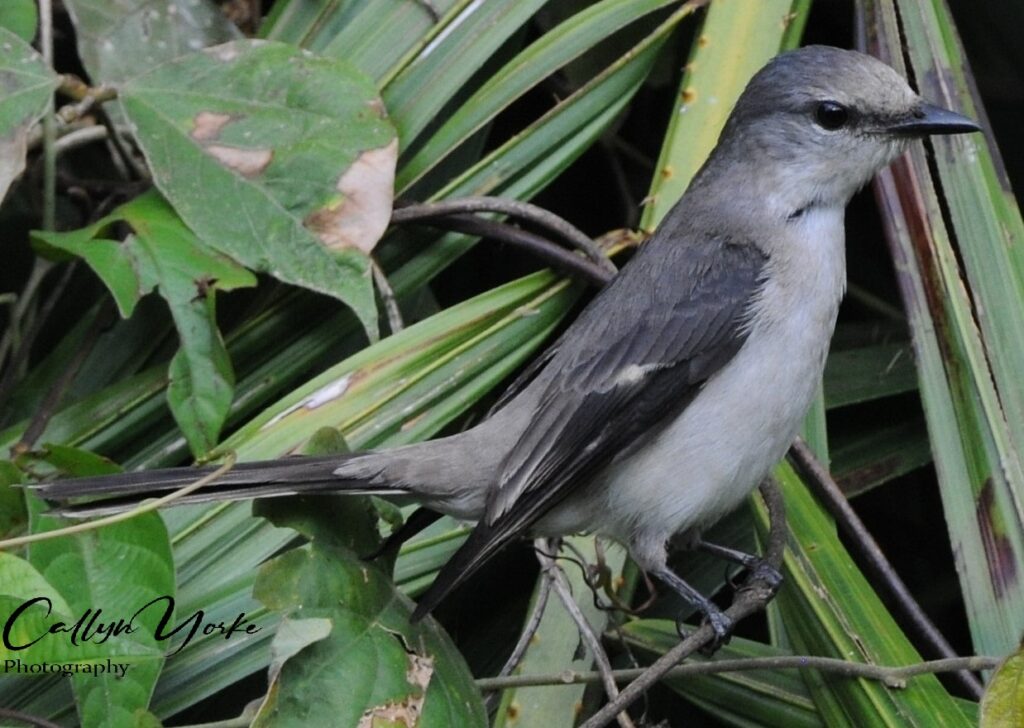
- Rosy Minivet Pericrocotus roseus 2 (m,f) in a msf with BWFS and BWCS, vine entangled second growth over the stream, C
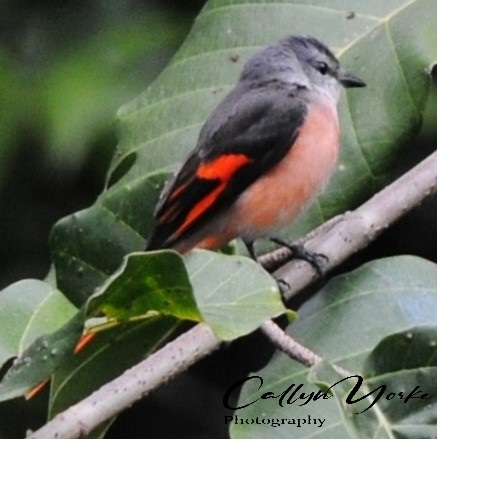
- Large Cuckooshrike Coracina nipalensis 1 msf with minivets and BWFS at forest edge over the stream, UC
- Black-winged Cuckooshrike Coracina melaschistos 2 msf with BWFS and minivets at forest edge over the stream, C
- Eastern Black-naped Oriole Oriolus diffusus 2 flew to subcanopy perch 7-10 m agl over stream, C
- Bar-winged Flycatcher-shrike Hemipus picatus 2 in msf with minivets and cuckooshrikes around vine-covered trees at edge of streamside forest, C
- Ashy Drongo Dicrurus leucophaeus 2 perched 5 and 7 m agl at streamside forest edge, C
- Chinese White-faced Drongo Dicrurus innexus 1 perched 5 m agl at streamside forest edge, UC
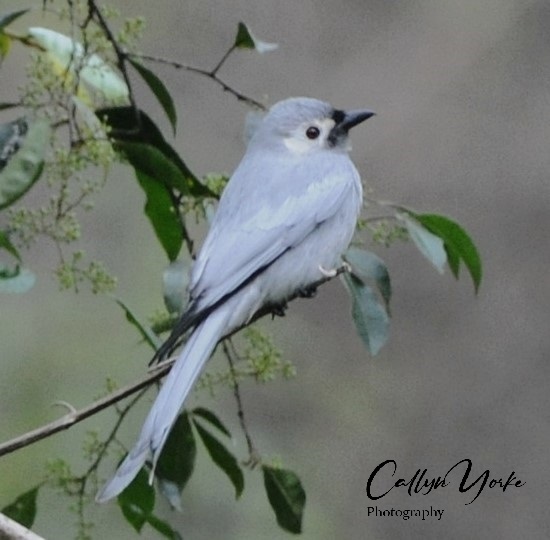
- Hair-crested Drongo Dicrurus hottentottus 5 greg. in the canopies of emergent fruiting trees, C
- Common Green Magpie Cissa chinensis 1 ascending a large, vine-covered tree next to a stream, UC
- Eastern Large-billed Crow Corvus macrorhynchos levaillantii 2 flying over forest clearings, 15 m agl, C
- Gray-headed Canary-flycatcher Culicicapa ceylonensis 2 vocal in msf with minivets and bulbuls in the lower to middle levels of the streamside forest, C
- Dark-necked Tailorbird Orthotomus atrogularis 2 vocal in forest edge understory near trails and stream
- Black-crested Bulbul Pycnonotus flaviventris 2 vocal, in msf with GEBU, STBU, BWFS and other insectivorus birds at forest edge above the stream, C
- Stripe-throated Bulbul Pycnonotus finlaysoni 2 greg. pairs in msf with BCBU and others; keeping mostly to dense cover (see previous entry), C
- Puff-throated Bulbul Alophoixus pallidus 2 greg. a pair active at the lower to mid-level at the forest edge, C (photo).
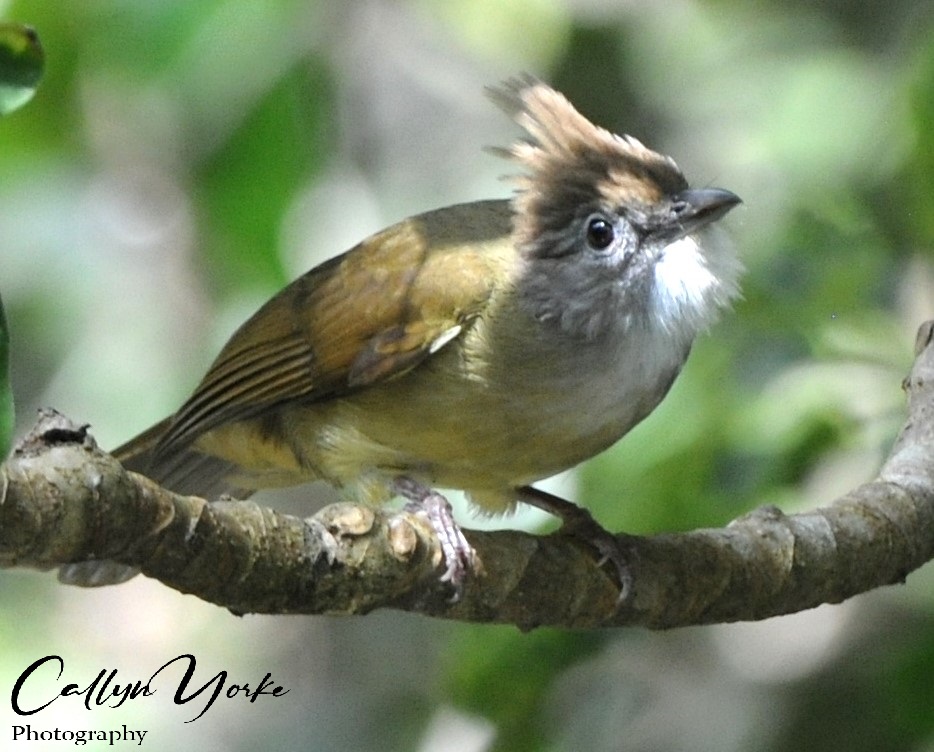
- Gray-eyed Bulbul Iole propinqua 2 greg. in msf with STBU, GHCF, YBLW and minivets at mid-level forest edge above a stream, C (photo).
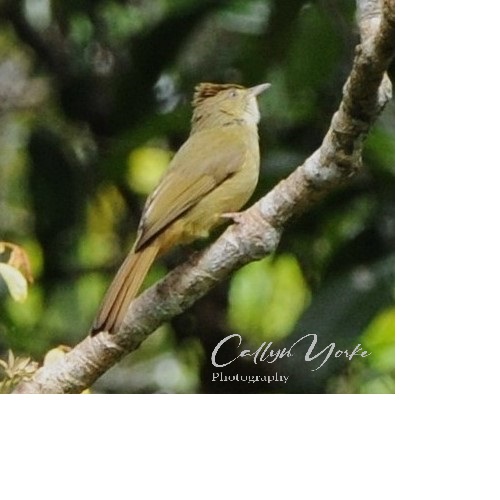
- Ashy Bulbul Hemixos flavala 2 greg. a pair active at mid-upper mid-level of streamside forest edge, UC
- Yellow-browed Warbler Phylloscopus inornatus 3 msf with BWFS, GHCF and other insectivorous birds,lower to mid-level in outer canopies of streamside trees, C
- Orange-headed Thrush Geokichla citrina 2 individuals on Kong Kaeo Waterfall trail, shy and retiring to forest understory when approached, C (photo).
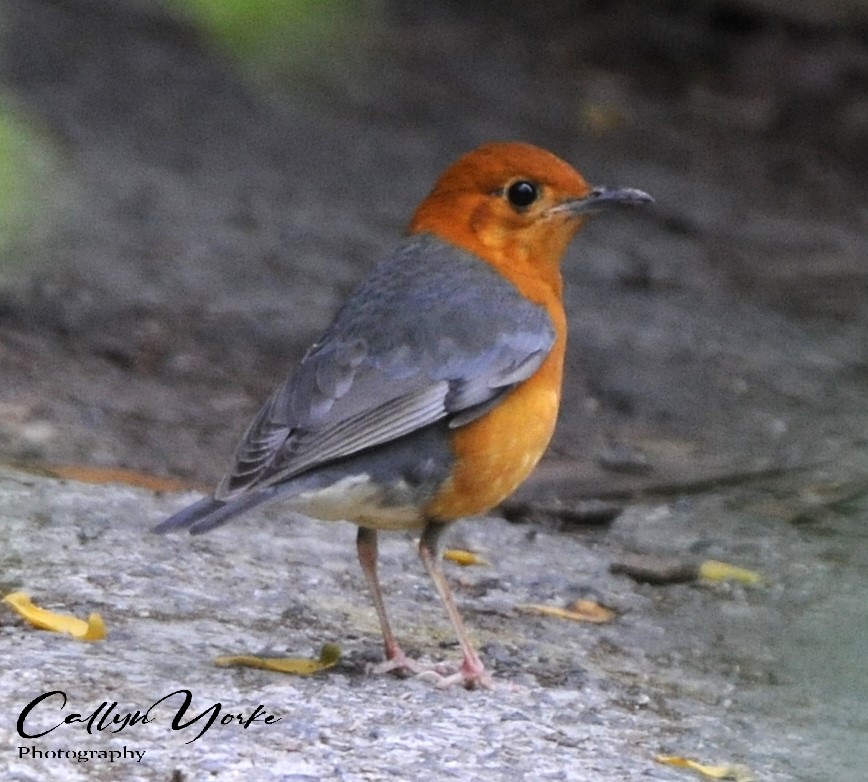
- Verditer Flycatcher Eumyias thalassinus 2 (m,f) in msf with YBWA, DNTA, minivets and other small insectivorous birds, mid-level, streamside forest edge, C
- White-rumped Shama Copsychus malabaricus 1-2 (m,f) a female was well concealed for several minutes beneath a forest edge, streamside shrub, then emerged partially into the open on the stream embankment, adjacent to a Blue-throated Bee-eater nest cavity (see above checklist entry for that species). Had I not been sitting quietly on the opposite embankment for several minutes observing the bee-eaters, the shama could have easily been overlooked; a few minutes later, another bird showing a white tail flash, probably a male White-rumped Shama, flew in and immediately concealed itself in the forest understory, suggesting there was a resident pair of White-rumped Shama in this area (photo – see Introduction).
- Mugimaki Flycatcher Ficedula mugimaki 1 (f) ig in small, streamside fruiting tree frequented by YBWA, C
- Red-throated (Taiga) Flycatcher Ficedula albicilla 2 (f, imm) ah and ig on low, streamside vegetation, C (photo).

- Blue-winged Leafbird Chloropsis moluccensis 2 (m,f) greg. a pair moving together quickly in middle to upper levels of fruiting trees in streamside forest edge, C
- Gray Wagtail Motacilla cinerea 1 taking spiders and small invertebrates from the soil and vegetation along the stream banks, C (photo).
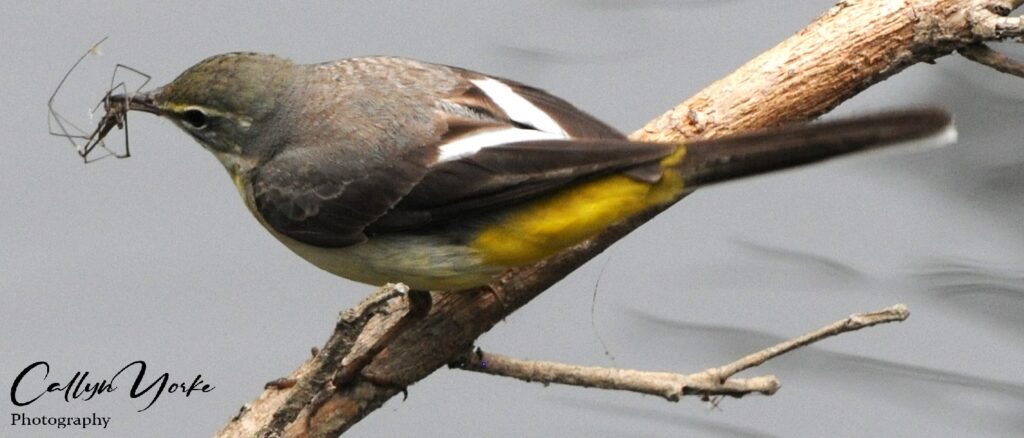
_________________________________________________________________________
4. Na Siri Lakeview Hotel, Bangkok 10-11 January, 2023 (Elevation, 1.5 m asl)
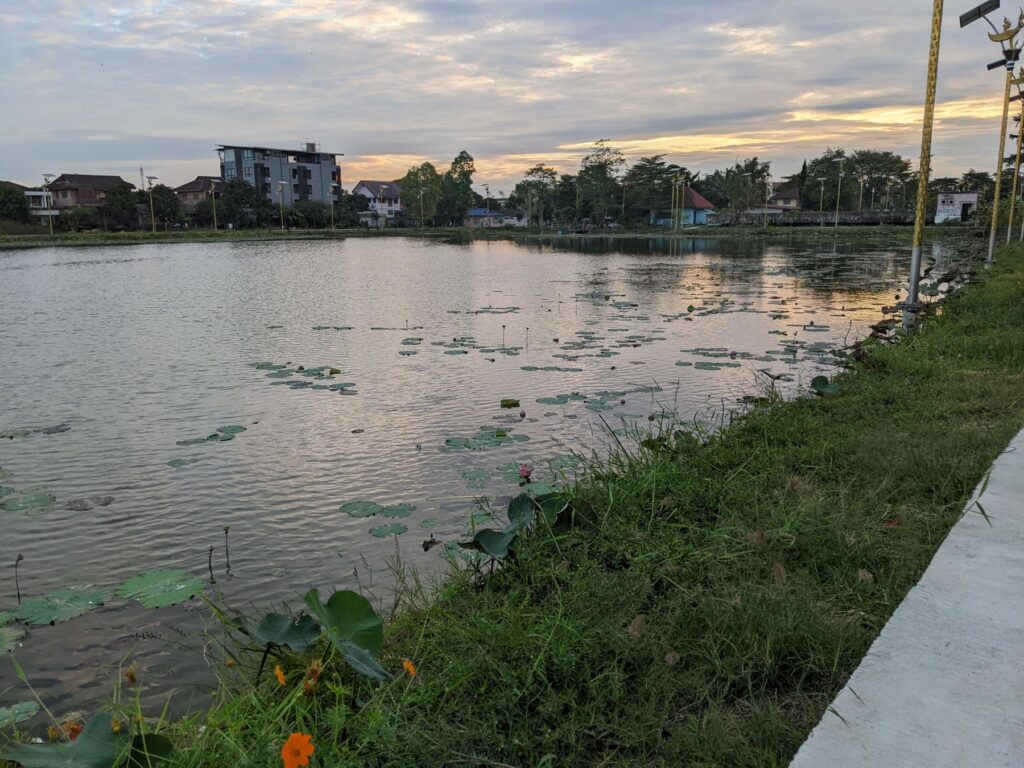
I made two walking surveys in the Na Siri Lakeview Hotel neighborhood; a cursory, late afternoon survey in the southeastern section (10 January, 1640-1700 hrs.), and a more thorough survey on a paved path around the reservoir (11 January, 0615-0715 hrs.). Several joggers and pedestrians were on the paved path around the reservoir during the surveys. Feral dogs were also present in the area (see Introduction for further details).
The neighborhood and reservoir edge habitats included homestead gardens with exotic fruit trees, patches of native shrubs (partially cleared) and a narrow margin of lotus lily and other marsh vegetation, mainly in the southern half of the reservoir (photo).
Annotated Checklist of Birds: Na Siri Lakeview Hotel Neighborhood and Reservoir, Bangkok (January 10-11, 2023) Callyn Yorke
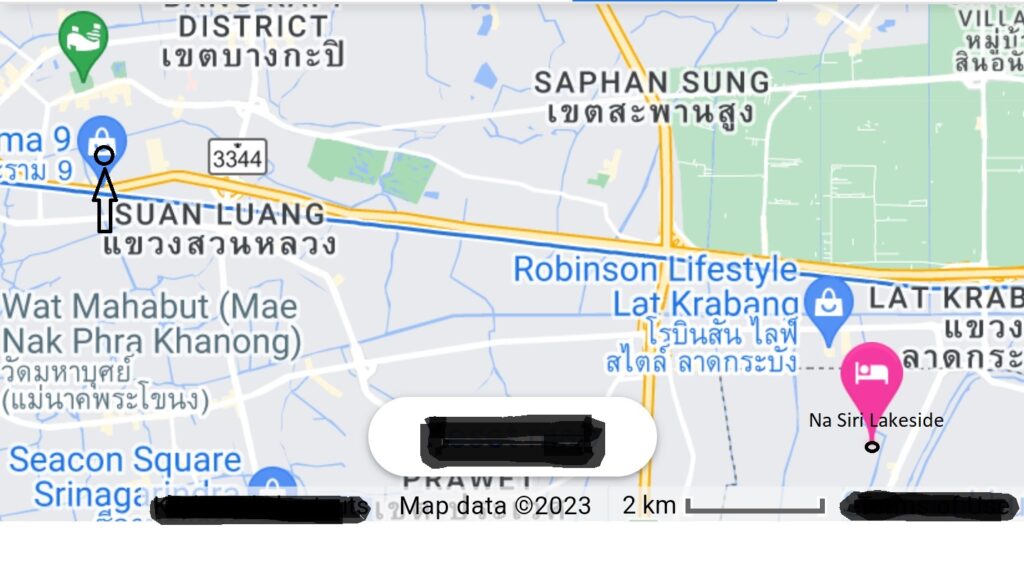
Abundance: Numbers following each species entry are the highest count for a single survey; Age, sex and molt (when known): ad = adult; imm = immature; m = male; f = female; bsc plmg = basic (non-breeding plumage; alt plmg = alternate (breeding) plumage.
Ecology and Behavior: aerial insect hawking (ah); taking fruit, berries or parts of flowers (fr); gleaning insects from foliage (ig); probing into surface (pr); estimated height (m) above ground (agl); gregarious (greg); mixed-species flock (msf).
Systematics and Nomenclature used herein, is an amalgam of Avibase, International Ornithological Congress (IOC) and current (2023) online resources, i.e. Birds of the World, Cornell University, USA.
- Feral Rock Pigeon Columba livia 20 vocal, greg., pairs and small flocks on rooftops; a few on ground and pavement.
- Eastern Spotted Dove Spilopelia chinensis 2 vocal on utility wire.
- Red-collared Dove Streptopelia tranquebarica 8 vocal, greg. in trees and on utility wires.
- Zebra Dove Geopelia striata 20 vocal, greg. on ground, buildings and utility wires.
- Greater Coucal Centropus sinensis 1 vocal (unseen) in weedy, vacant lot, w.
- Western Koel Eudynamys scolopaceus 2-3 vocal (unseen) at sunrise and thereafter, apparently in mango and other mature fruit trees.
- Plaintive Cuckoo Cacomantis merulinus 1 vocal after sunrise (unseen).
- Germain’s Swift Aerodramus germani 2 flying 10-15m agl over rooftops at dusk.
- Asian Openbill Anastomus oscitans 2 greg. a pair flying nw over reservoir at dawn, 40 m agl.
- Heron Ixobrychus sp. ? probably sinensis 1 small size, seen very briefly as it flew to a clump of marsh vegetation in reservoir at dusk.
- Pond-heron Ardeola sp. c.f. bacchus 2 (bsc. plmg.) seen at dusk in adjacent wetland to the s; one flying over reservoir at dawn, at 20m agl.
- Gray Heron Ardea cinerea 2 at dawn, flying w at 50m agl.
- Eastern Great Egret Ardea modesta 1 at dawn, flying w at 30m agl.
- Intermediate Egret Ardea intermedia 2 at dawn, flying w at 30m agl.
- Little Egret Egretta garzetta 1 at dawn, flying w at 30m agl.
- Little Cormorant Microcarbo niger 2 at dawn, flying w at 20m agl.
- Whiskered Tern Chlidonias hybrida 5 flying low, 2-10m agl around the reservoir about an hour before sunset.
- Coppersmith Barbet Psilopogon haemacephalus 1 vocal (unseen) at sunrise in garden trees.
- Yellow-bellied Prinia Prinia flaviventris 1 vocal (unseen) in a shrub-ruderal field adjacent to the reservoir.
- Eurasian Barn Swallow Hirundo rustica 25 greg. a large flock flying back and forth, 1-10m agl over reservoir at sunrise; fewer (2-3 individuals) seen at dusk.
- Collared Sand Martin Riparia riparia ? 1 with barn swallows at dawn; noted comparatively small size, brown upperparts with white undersides dusky breast (diagnostic breast bar not clearly visible).
- Yellow-vented Bulbul Pycnonotus goiavier 4 vocal, greg. in garden trees.
- Streak-eared Bulbul Pycnonotus conradi 2-3 vocal, greg. in garden trees.
- Yellow-browed Warbler Phylloscopus inornatus 1 in canopy of a garden tree.
- Common Myna Acridotheres tristis 20 vocal, greg. on roof-tops, utility wires and ground.
- Oriental Magpie Robin Copsychus saularis 4 (m,f) greg. pairs vocal in gardens.
- Olive-backed (Ornate) Sunbird Cynnyris jugularis 2 (m,f) vocal, visiting covered orchid garden and flower pots containing water outside the hotel.
- Indian (House) Sparrow Passer indicus 10 (m,f) vocal, greg. feeding on kitchen food castings in the street but apart from the numerically dominant flocks of EUTS.
- Eurasian Tree Sparrow Passer montanus 30 (m,f) vocal, greg. on the ground, in trees, on buidings and utility wires
__________________________________________________________________
_______________________________________________________________________________________
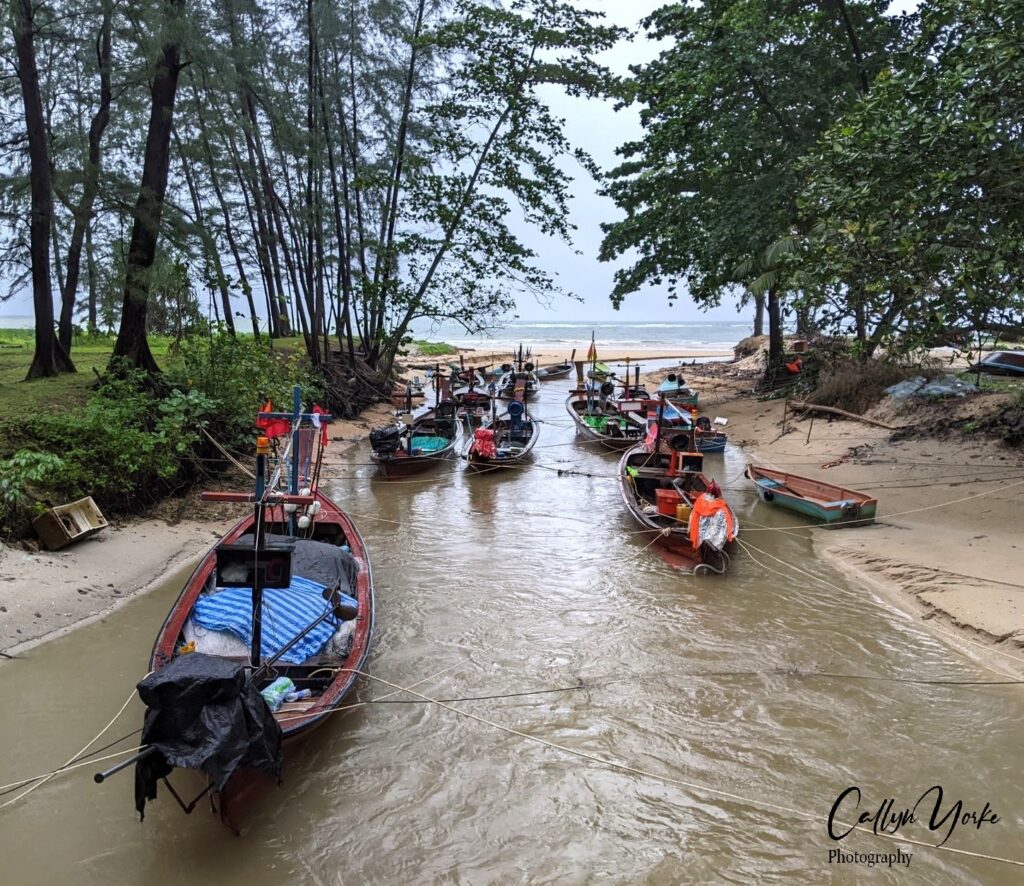
Nai Yang Beach, Sirnath National Park, Phuket, Sakhu Province, Thailand: Bird Report: October 17 – 23, 2022 Callyn Yorke
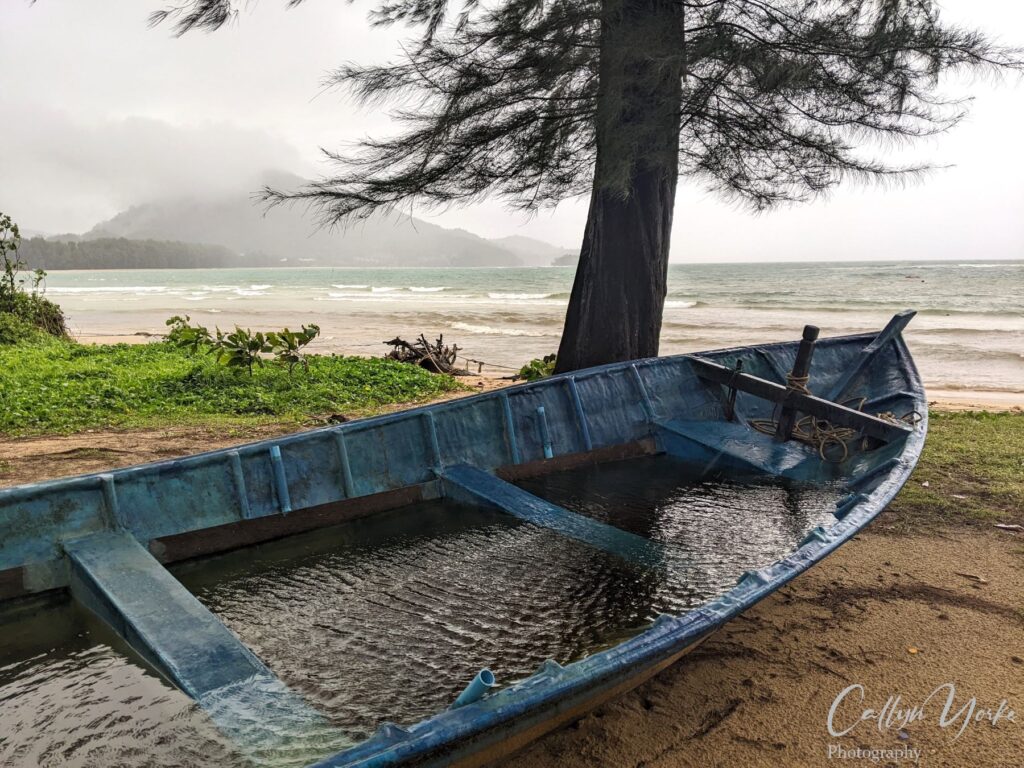
Scroll down for Annotated Bird List
INTRODUCTION
A recent series of tropical cyclones, originating in the Western Pacific, had ripped through Central Vietnam and Laos. Although certainly devastating, this was not too surprising, given our current understanding of global climate change and seasonal monsoons, i.e. increased ocean temperatures accelerating and extending tropical weather systems. Any plans for outdoor activities were likely to change. For instance, if you lived in Da Nang or Hue, Vietnam, you were going to need a boat to get to work.
Hoping for a break in the weather, I booked a flight to Phuket, Thailand from DaLat, Vietnam, via Saigon. Phuket, a prime tourist destination for Australians, Europeans and Russians, advertises nearly perfect weather conditions year-round, e.g. 320 days of sunshine. The rainy season (southwest monsoon) is usually over by the second half of October. No worries. Everyone is going to have a great time there, etc.. Or nearly so. Western Thailand was still in the grip of a powerful southwest monsoon. How bad could that be?
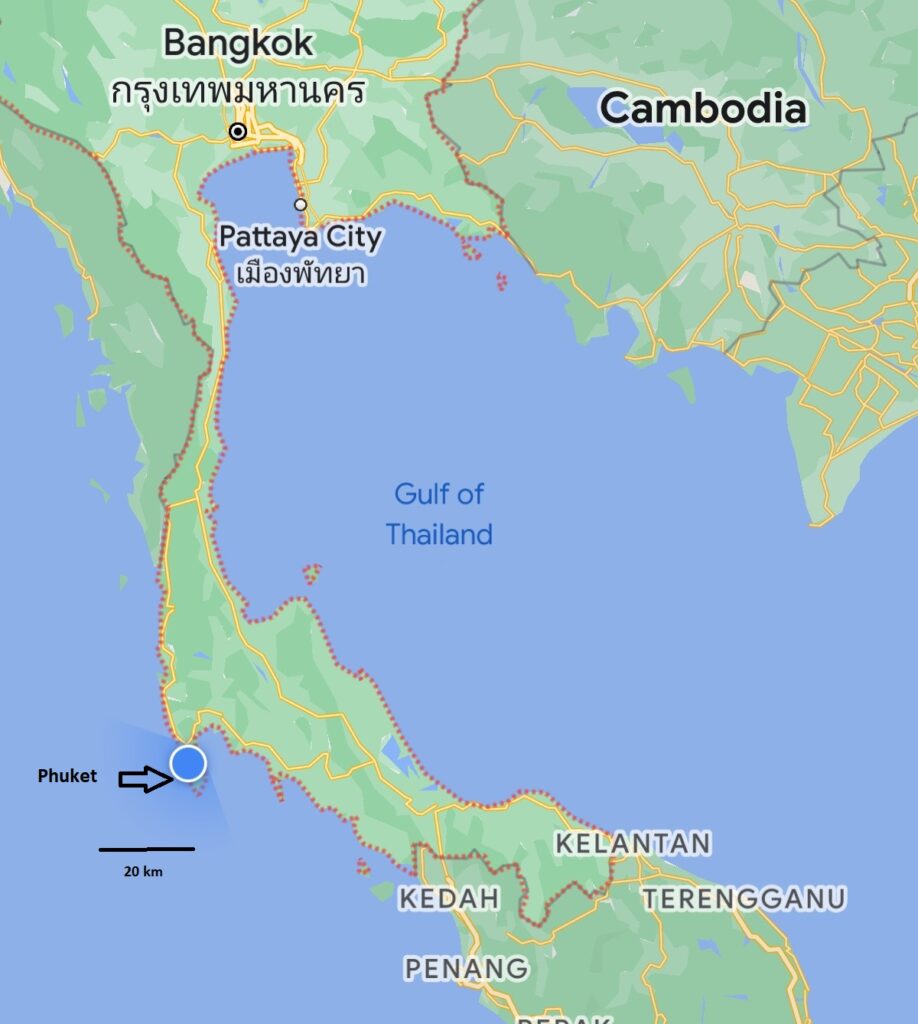
The 1.5 hour VietJet flight from Saigon (VJ 809), fully booked, carried a heavy load (about 170 passengers), including many Asians and more than a few Westerners; there were lots of families going on vacation. The journey went fairly smoothly until we approached Phuket International Airport. The captain announced that the local air temperature was 26C and there was light rain. He added that an umbrella might be useful. This aviator would probably never be accused of overstating weather conditions, or any other topic his passengers might consider relevant.
The final approach and descent into Phuket, through an opaque lens of low clouds, tossed the aircraft around violently. Women gasped, babies began crying. We couldn’t see the airport until the last few seconds. Suddenly, we landed – well, almost – the plane, traveling at about 250 kph (normal landing speed for an A 320), bounced and swerved as the brakes were applied; the pilot, I imagined, was struggling to avoid sliding off a short, slick runway.
Except for the heavy weather, this was not an especially unusual landing for a fully-loaded passenger jet on a comparatively small airfield. Those of us who often fly domestic routes around Southeast Asia are probably less likely to be rattled by hard landings than folks who fly infrequently. Personally, I would much rather endure a bumpy landing than a mid-air malfunction. Thankfully, these huge planes (83,000 kg fully loaded) are designed for most of the impact to be absorbed by the landing gear. The residual impact, expressed by frightened passengers, was the worst of it, really. The Airbus 320, the junior version of the A 321, and with one of the best safety records, held together perfectly for the rough landing. But most of the passengers, myself included, were flying with the faith that nothing would malfunction, despite literally tens of thousands of integrated components needed to get all of us to our destination safely; not to mention the skill and experience of our easy-going captain.
Perhaps the less we know about aircraft operations, the better. I know people, one a former pilot, who refuse to fly on commercial aircraft. Others, hopefully excluding the pilot, fly only if heavily medicated. That’s almost funny. Woody Allen summed up the issue when he said, “I don’t mind dying. I just don’t want to be there when it happens.“
Seatbelt lights on, wing flaps up — it all happened pretty fast. There was no time for a last minute prayer or phone call to relatives. Even the flight attendants, trained to keep their composure during an incident, e.g. bird-aircraft collision, looked a bit ruffled, or perhaps only exhausted from sprinting up and down the aisle for ninety-minutes. This landing was loud and a little rough, and I wondered if the crew thought so as well. On a facial distress scale of 1-10, perhaps they rated an average of 5 at the end of the flight. I reckon that, at any time during a flight, when the crew’s facial distress-scale reaches 8, its time to check for the nearest emergency exit. By the way, wouldn’t a parachute be more useful than a lifejacket on an airplane?
The ‘light rain’ announced by the captain was actually a baby shower for families with small children. Most of us got soaked in the seconds spent scurrying like refugees to crowd into a shuttle bus, that could have been mistaken for an emergency deportation vehicle. Almost no one, aside from the captain and crew, had an umbrella. Mine was in the check-through baggage; apparently, it was the same for other passengers.

Rain and more rain. And so went the next few days in Phuket. Sometimes, there was a break in the weather and a little sunlight between the high clouds. Partly cloudy skies seldom lasted more than twenty-minutes. Squalls were especially fierce following a brief clearing. The result was that very few vacationers, or even local packs of apocalyptic dogs, were on the beach or anywhere near Sirinath National Park. I had the place to myself most of the time.
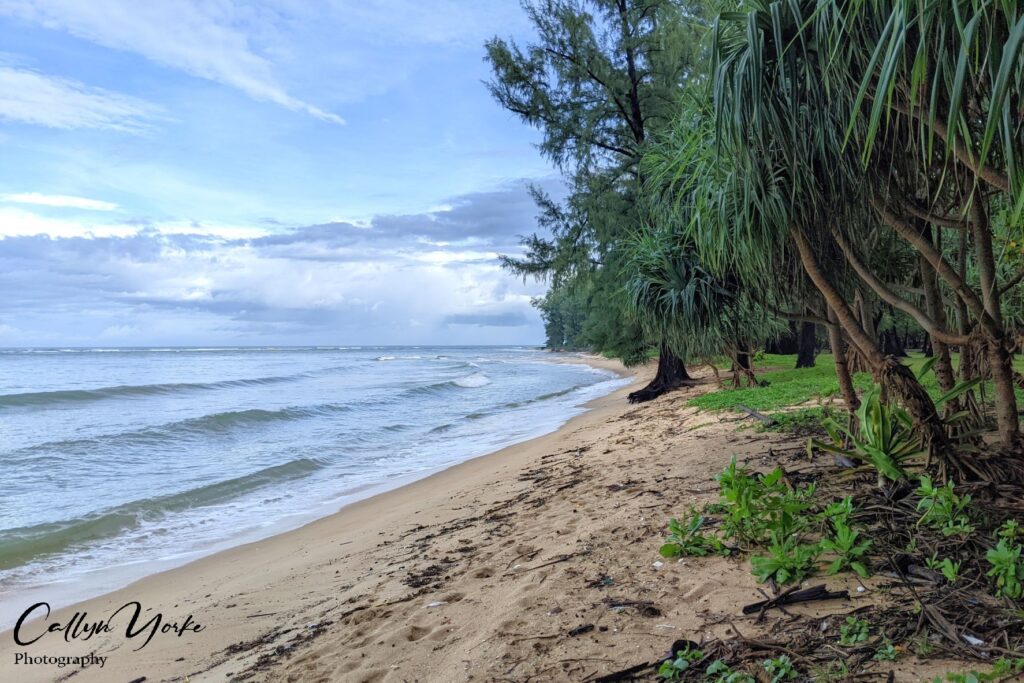
Since my Nikon D850 camera equipment had recently been ruined by heavy rains in Laos, I had planned for wet weather this time and used a waterproof North Face back pack and umbrella when birding. This gear was awkward, especially when I needed to remove the camera from the pack quickly to capture an image of a bird doing something interesting. The umbrella served to cover the backpack and camera during the removal process, which included removing the lens cover and refastening the lens hood. But gusty winds shifted the umbrella around, leaving my camera equipment fully exposed to the rain. The subject frequently disappeared before I had it all together. Welcome to wildlife photography 101!
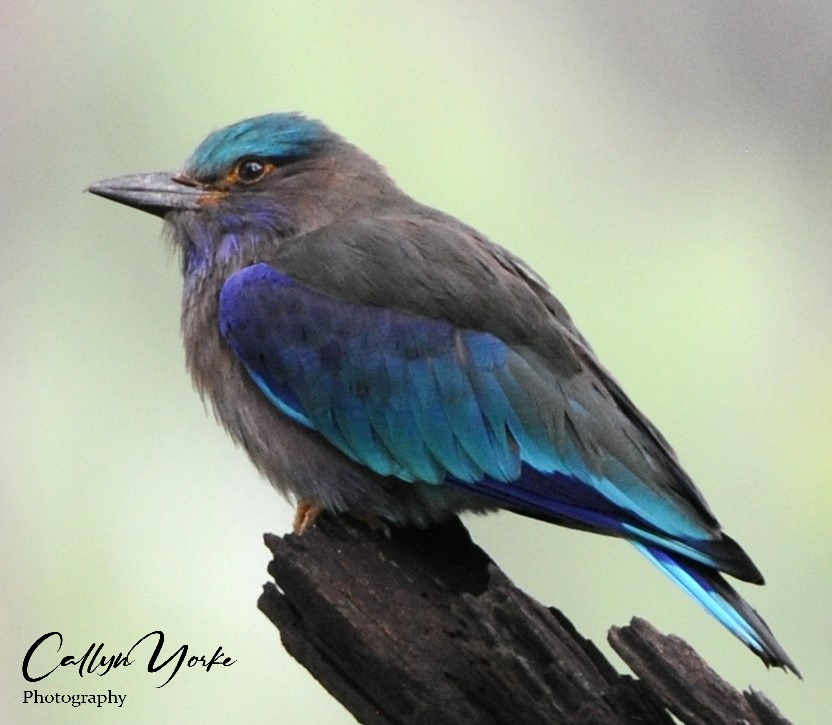
When birds stayed in one place long enough, I celebrated with a series of rapid-fire, hand-held shots using a Nikon D3X camera coupled with a Nikon 200-500 mm lens. A pair of adult Pacific Reef Heron in alternate (breeding) plumage, provided a unique opportunity for photos, as they took turns darting at tiny invertebrates floating by in a brackish tidal stream.

eBird (Cornell University, USA) included a seasonal summary (Bar Chart) for Sirinath National Park, showing all bird species reported by those using that online service. The grand tally (representing several years and multiple observers) was 140 bird species. Some birds on the list were of special interest to me because they were either rare (e.g. Ruddy Kingfisher ), missing from my life list (Rufous-tailed Tailorbird), or not found in Vietnam (Mangrove Pitta, Olive-winged Bulbul). Hence, my choice to spend a few days at this location in Thailand. As it turned out, none of the birds I found in Sirinath National Park was entirely new to me; most of them, in fact, were common and widespread in Southeast Asia. But considering the prevailing weather conditions, I felt fortunate to have found and photographed a few species that remained active.

One of the best birding locations was my hotel room (#401) on an upper floor of the Kokotel, with a balcony overlooking the National Park. During periods of heavy rain, I simply sat and stared out the window, noting the bird species flying by or perched in nearby trees. A few distant photos were taken from my room, which, with curtains partly drawn, could be easily converted into a rather luxurious photography hide.
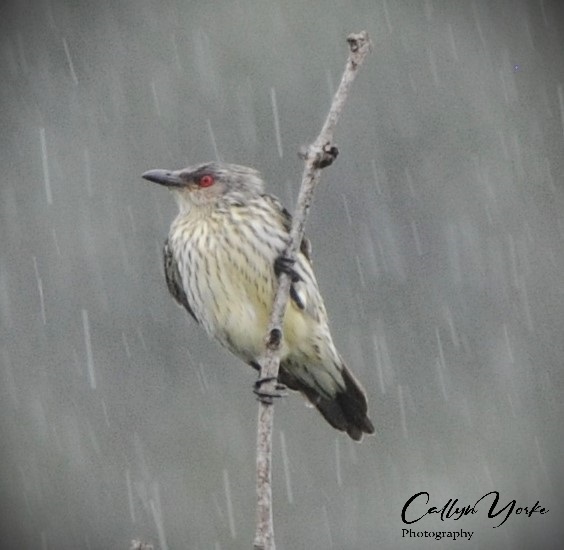
Initially, I had booked a week-long stay at the Nai Yang Beach Resort, located within the National Park. As it turned out, the airport pick-up service offered by the resort was a no-show. My lodging plans needed a quick revision. After waiting around awhile in the rain with my luggage, I took a taxi directly to the Kokotel, which had good overall reviews from travelers. The hotel was located about 100m from the National Park. It was definitely a fortuitous move.
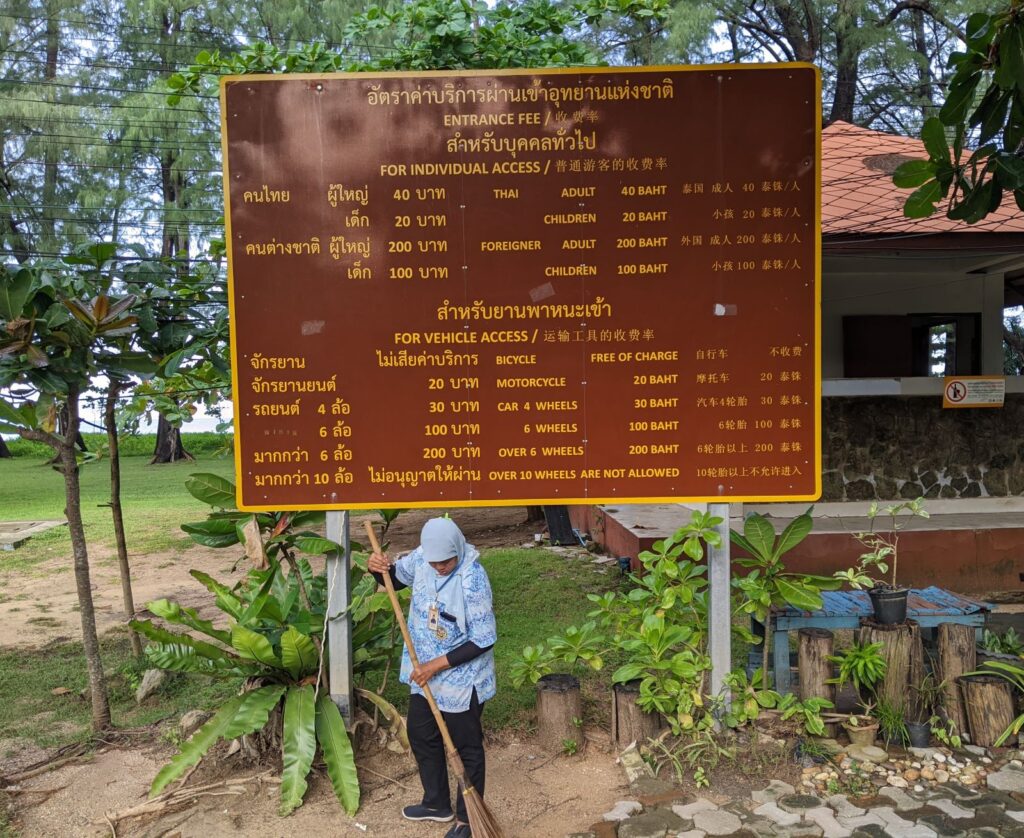
The Nai Yang Resort, receiving mixed traveler’s reviews, was undergoing major renovation. I passed by it a few times while walking through the park. Nevertheless, in some kind of Kharma payback scheme, they managed to punish me for choosing one of their competitor’s lodges. Here’s how that went down.
Maintaining my anonymity, I stopped by the Nai Yang Resort once for lunch. Their highway billboard advertised “Only Fresh Seafood.” I ordered fish curry. But after a couple of bites, I was finished. The chunks of boiled fish in the soup had a putrid smell, as though the fish had been dead on shore for a few days before it went into the pot. The following morning I spent on the bathroom throne. Multiple royal rulings carried the distinctive fragrance of fish curry. Then something painfully obvious occurred to me. The stormy seas had grounded all the local fishermen; there was probably no fresh seafood anywhere on the island.
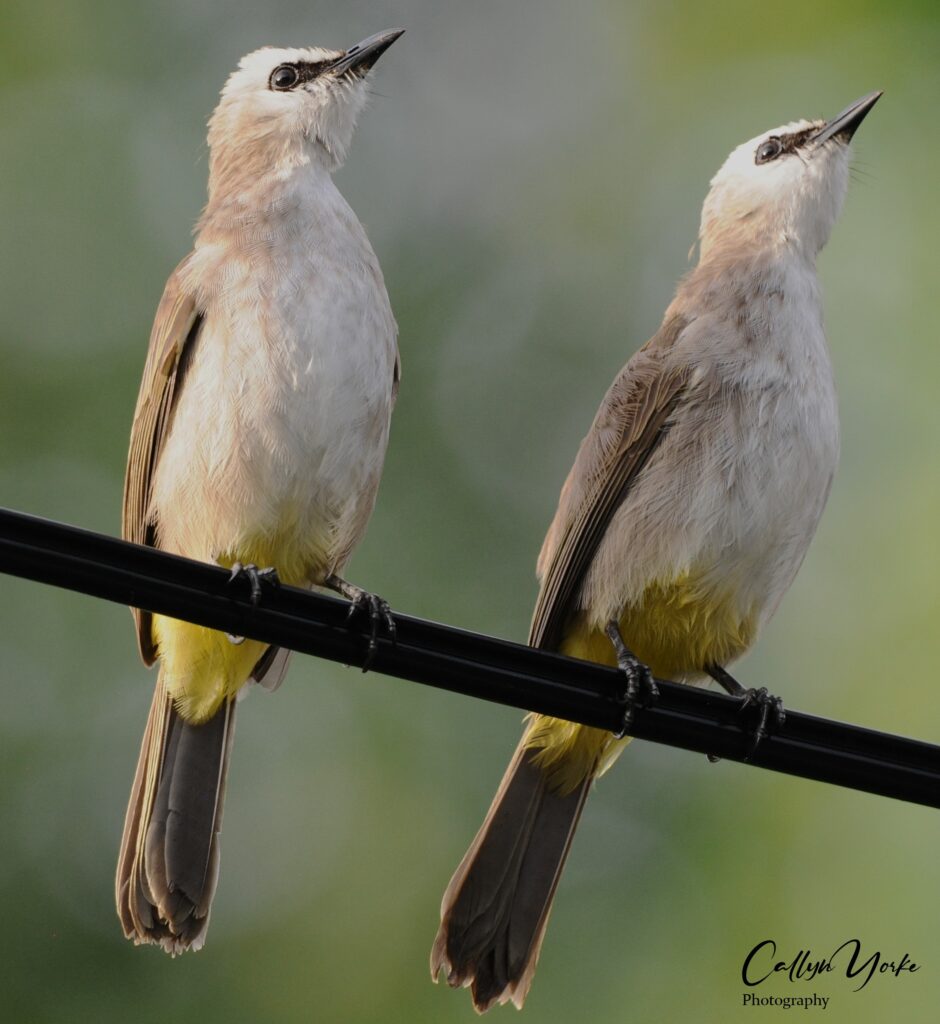
The Kokotel, a five-level, Thai-owned and operated hotel, was nearly perfect for me (4-stars quite well deserved). In addition to having an elevated view of the National Park from my room, the modern facilities were spotless and well maintained. There were only minor inconveniences, e.g. cold fried eggs for breakfast and a limited lunch and dinner menu. Also, due to my last-minute booking, the hotel had no room on the final evening of my stay in Thailand. I would have to be on a waiting list until there was a cancellation. No problem. Several other lodging options were nearby. All together, Kokotel was very affordable ($US 31/night with breakfast), pleasant and convenient lodging.
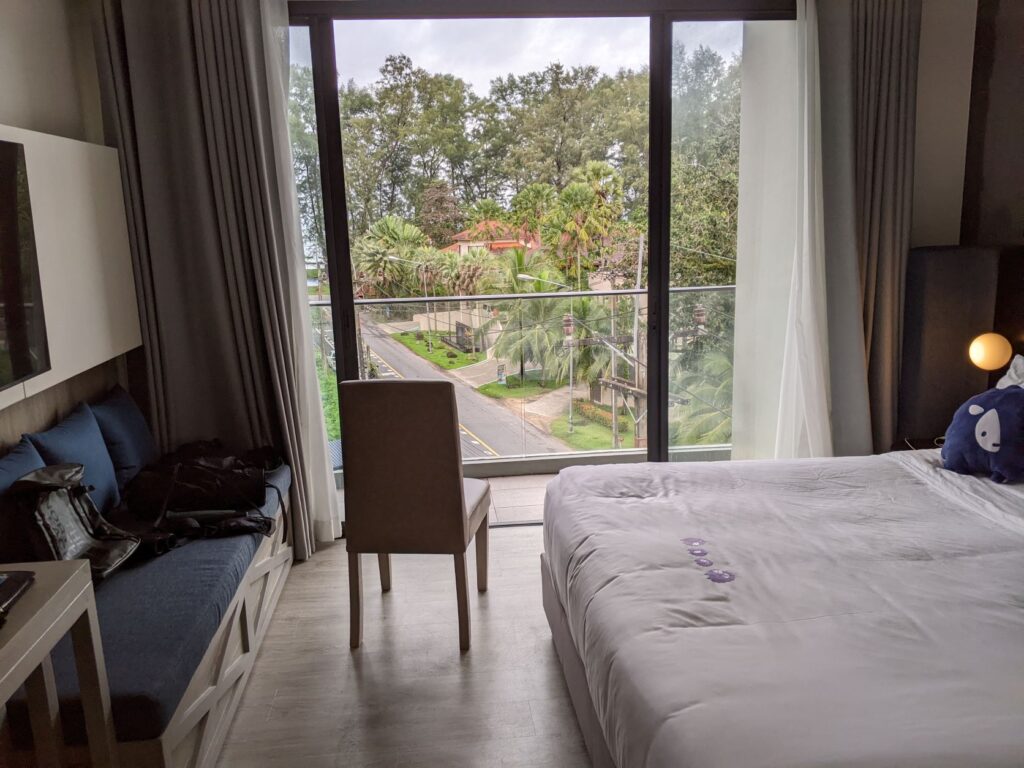
Materials, Methods and Survey Areas (October 17-23, 2022)
Surveys were of two types: Stationary from my hotel room balcony (daily for several hours at variable times) and walking surveys (daily for 1-2 hrs., early morning (0600-0800 hrs.), mid-day (1200-1500 hrs.) and evenings (1600-1700 hrs.), except for 10/20/22 – stationary observations only. For all, I used a Zeiss 10 x 42 binocular, hand-held Nikon D3X camera, fitted with a Nikon 200-500 mm VR-IF-AF lens. A Google Pixel 3X cell phone camera was used to document signage and locations. I used a pocket field notebook, recopying the field notes into a loose-leaf, binder format later the same day. When bird identities were in question, I referred to my digital images when available and images from reliable online sources, e.g. Birds of the World, Cornell University, USA. Species of uncertain identity are listed with a ? in the Annotated Bird List.
Areas covered, included suburban gardens with ornamental palms, exotic flowering shrubs & trees; vacant lots with vine-covered second-growth; parkland (most of Sirinath National Park) with flooded lawns bordered by groves of mature (25 m in height) native Casuarina (Casuarina equisetifolia) and Sea Almond (Terminalia catappa). Native coconut palms (Cocos nucifera) were present in the southwest corner of the park. A steep shoreline bordering the parkland was strewn with trash; heavy surf during storms seemed to discourage any shorebird activity, except at one location with a freshwater stream flowed into the ocean. There, moored fishing boats were often used by herons as perches when flushed from the stream bank. Further upstream, a small number of waterbirds (White-breasted Kingfisher, Common Sandpiper, Striated Heron) found forage and shelter along the steep, sandy embankments; that microhabitat appeared largely sterile and devoid of birdlife, except near the outlet to the sea.
Nearshore ocean waters, turbulent with surf reaching 1m during storms, were scanned periodically but without finding any birdlife. A peninsula-like reef occurred about 150 m offshore of the park. Except during a brief calm, rainless period at low tide, with a pair of Pacific Reef Heron, no other birdlife was seen there.
I walked about 1 km on the main roadway (Highway 4031) through the park and onto driveways leading to vacant park buildings. Those, relatively quiet areas had some interesting birds feeding on the ground, e.g. Hoopoe and Forest Wagtail. Magpie Robin was also found in the area, together with Common Myna and Great Myna, all foraging at the edges of flooded lawns and gardens.
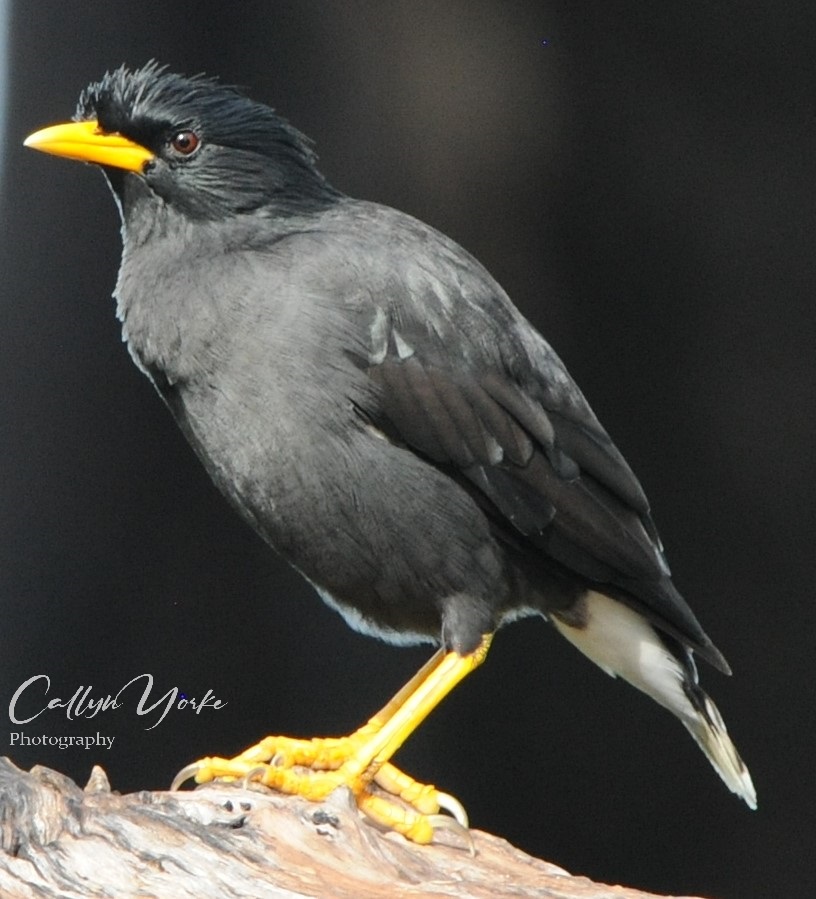
Continuing eastward and northward from the Provincial Police Station, I followed a paved road transecting a sizeable broad-leaved evergreen forest, completely inundated from heavy rainfall. Except for a side-track leading to a swampy dump, there was little bird-life found along this route. At the northern terminus of the road, I circled back into the park and returned to the hotel near the intersection of the main road and city street at the south end, completing a counter-clockwise survey route.
I estimate that my surveys covered a total of about twenty-hectares, including the mosaic of habitats described above. Persistent rains made observations difficult and photography sometimes impossible without incurring water damage to the camera and lens.
Annotated Bird List for Nai Yang Bay & Sirinath National Park, Phuket, Thailand: October 17-23, 2022 (40 Species) Callyn Yorke
Abundance: Numbers following each species entry are the maximum count for a single survey, or when multiple surveys of an area were made
Age, sex and molt (when known): ad = adult; imm = immature; m = male; f = female; bsc plmg = basic (non-breeding plumage; alt plmg = alternate (breeding) plumage.
Frequency: C = Common, i.e. found during all or more than half of the surveys in appropriate habitats; UC = found on fewer than half of the surveys; R = found only once.
Localities & Distribution: Nai Yang Beach (NYB), including villages and other commerical developments, vacant lots with second-growth and weedy patches; much of this area could be seen from room #401 of the Kokotel hotel balcony window. Sirinath National Park (SNP), including gardens, lawns and second-growth bordering maintenance facilities and worker’s homes; sea coast and freshwater stream channel emptying into the sea. See Introduction and Survey Areas for further location details; ubiquitous in the appropriate habitat (ubiq).
Ecology and Behavior: aerial insect hawking (ah); taking fruit, berries or parts of flowers (fr); probing the substrate (pr); gleaning insects from foliage (ig); estimated height (m) above ground (agl); gregarious (greg); mixed species flock (msf).
Systematics and Nomenclature used herein, an amalgam of recently published and current (2022) online resources, e.g., Birdlife International, Avibase and Birds of the World, Cornell University, USA.
- Eurasian Spotted Dove Spilopelia chinensis 12 vocal, greg. pr on ground and lawns, C, NYB, SNP
- Red Turtle Dove Streptopelia tranquebarica 2 on ground with EUTS, UC, NYB
- Zebra Dove Geopelia striata 8 vocal, greg. pairs on utility wires, ground and lawns, often with ESDO, C, NYB, SNP
- Germain’s Swiftlet Aerodramus germani 30 greg. flying 5 – 20 m agl, C, ubiq.
- Asian Palm Swift Cypsiurus balasiensis 6 greg. flying 10 -20m agl over second-growth and around palms, C, NYB
- Vernal hanging Parrot Loriculus vernalis 2 (m, ?) in tall second-growth of vacant lot, foraging on small fruits, greg., R, NYB
- Plaintive Cuckoo Cacomantis merulinus 1 (f) on lower branch in a large sea almond tree, interacting with a LTSH, R, SNP
- Asian Koel Eudynamys scolopaceus 1 with rather tattered feathers, sunning itself in outer canopy of a garden tree, R, SNP (photo).

- Greater Coucal Centropus sinensis 1 walking on lawn and flying into second-growth at edge of garden at park headquarters, UC, SNP
- Collared Kingfisher Todiramphus chloris 1 flushed from dump-swamp area, UC, SNP
- White-breasted Kingfisher Halcyon smyrnensis 4 vocal (often incessantly), sallying to ground for insects from low (1-1.5 m agl) perches in wetlands, C, ubiq.
- Indian Roller Coracias benghalensis 7 vocal, greg., pairs and sometimes trios, sallying to ground for insects from low limbs; exposed canopy perches when not foraging, C, NYB, SNP (photo – see Introduction)
- Blue-tailed Bee-eater Merops philippinus 1 sallying out for insects from tree canopies, UC, NYB (photo).
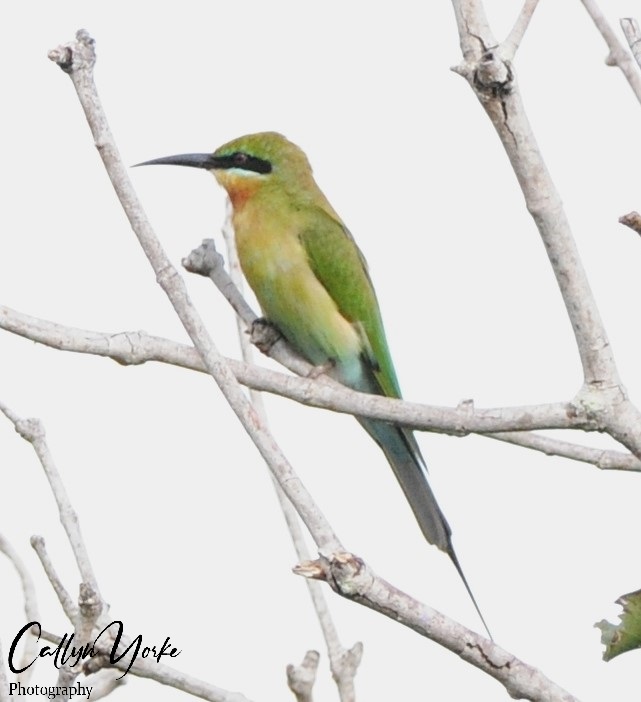
- Pacific Reef Heron Egretta sacra 2 alt. plmg. a pair foraging on shore and streamside, C, SNP (photo).
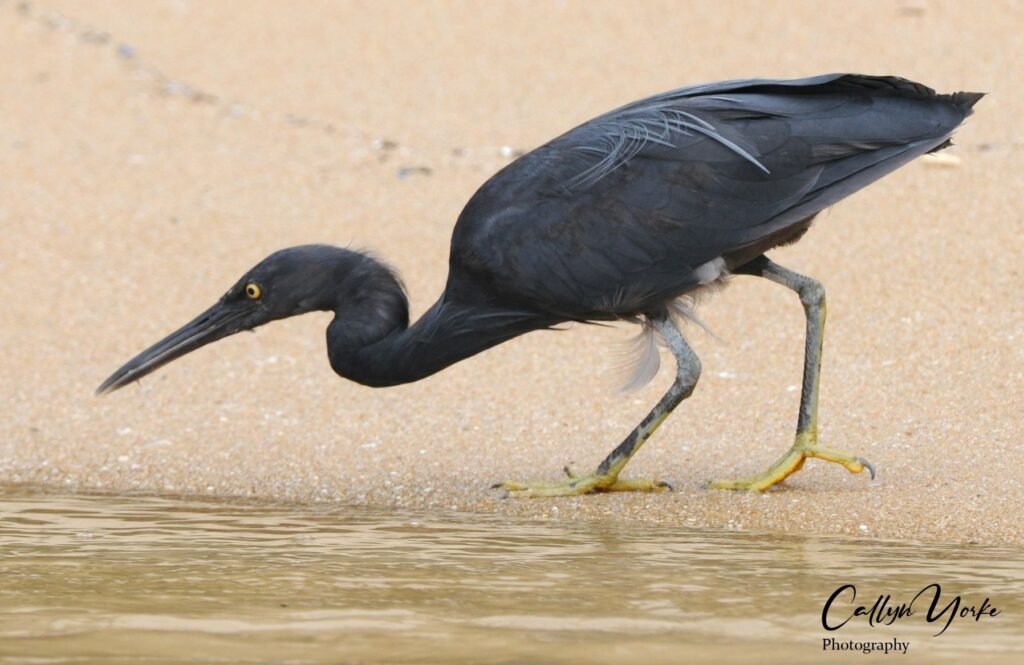
- Little Egret Egretta garzetta 2 foraging streamside and in dump, C, SNP
- Javan Pond Heron Ardeola speciosa 2 foraging streamside, weedy lots and in dump, C, SNP
- Striated Heron Butorides striatus 4 (ad, imm) foraging streamside, C, SNP (photo).
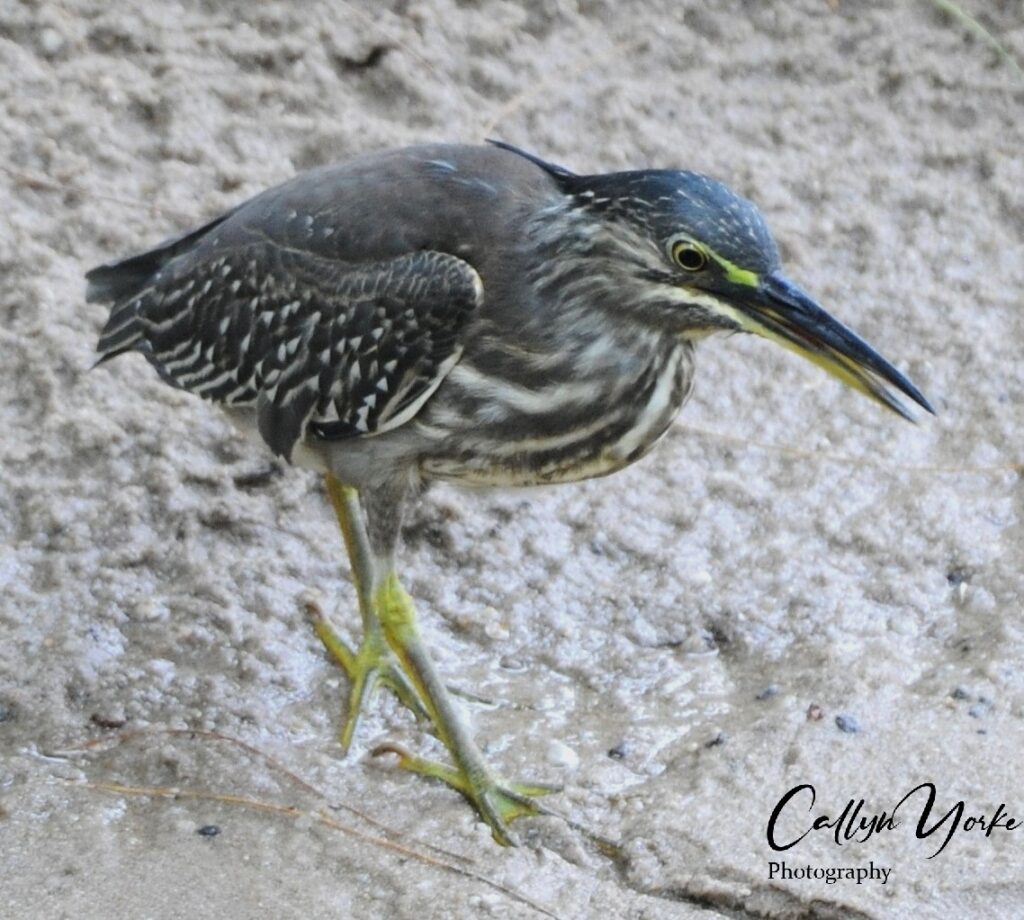
- Common Sandpiper Actitis hypoleucos 2 greg. pairs foraging streamside, C, SNP
- Brahminy Kite Heliastur indus 4 (ad) individuals and occasionally small flocks flying slowly over casuarinas, alighting in canopy; one bird was harassed by three LBCR, C, NYB, SNP (photo).
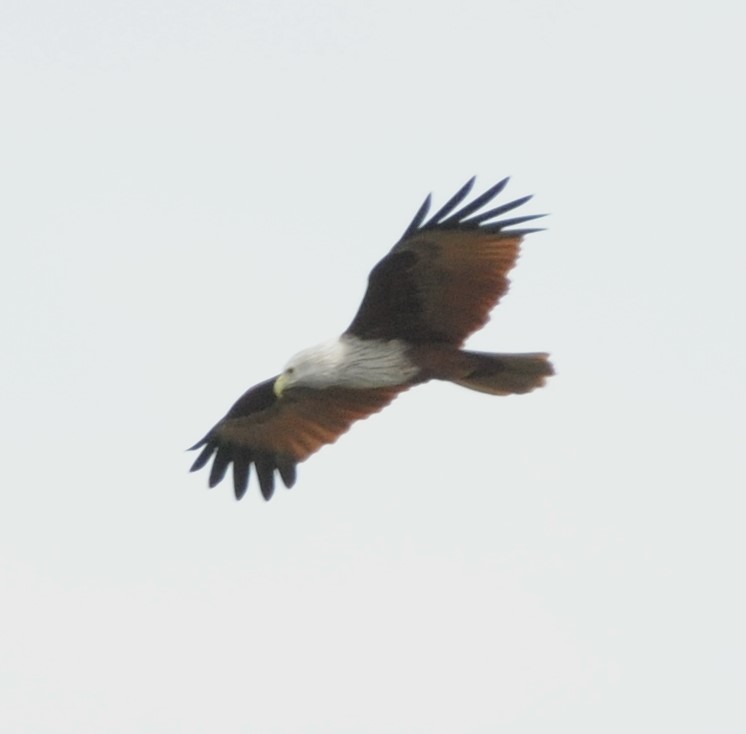
- Changeable Hawk-eagle Nisaetus limnaeetus 1 seen at just above eye-level flying by hotel @ 20 m agl, R, NYB
- Greater Racquet-tailed Drongo Dicrurus paradiseus 1 sallying from 1.5 m perch on brush pile in dump, R, SNP
- Large-billed Crow Corvus macrorhynchos 10 vocal (loud, relatively deep, nasal calls of at least two types, long and short duration), greg. pairs flying over woodland and open areas, occasionally alighting in canopy; not seen foraging on ground, C, NYB, SNP (photo).
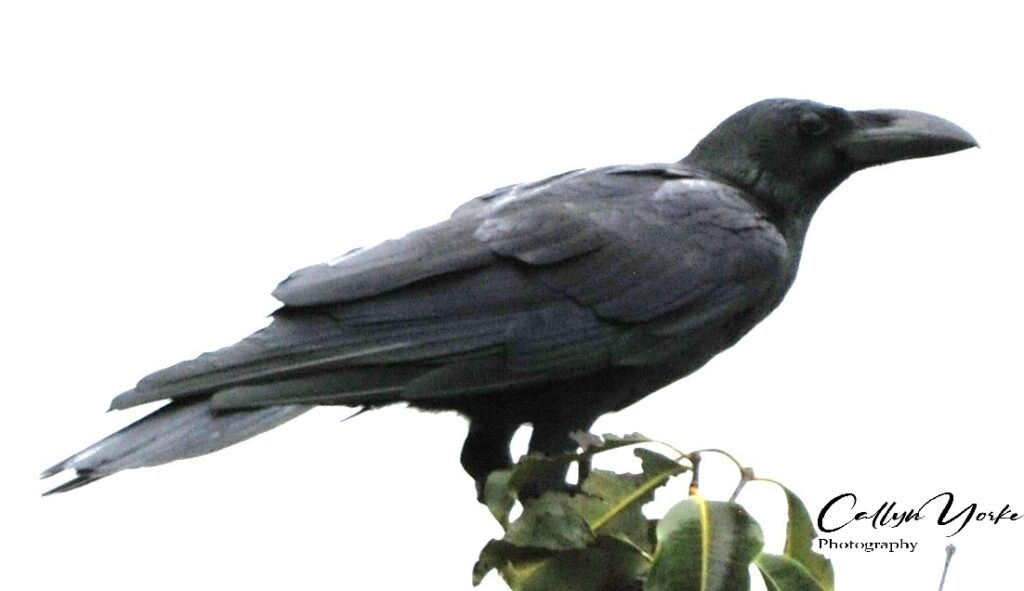
- Common Iora Aegithina tiphia 2 (m,f) vocal, ig in leguminous trees in vacant lot next to the hotel, UC, NYB
- Brown Shrike Lanius cristatus 1 sallying to ground from low limbs, often associated with INRO, sometimes vocalizing and interacting territorially with them, C, SNP
- Long-tailed Shrike Lanius schach 1 (ad) in lower branches of Sea Almond, flying to adjacent vacant lot next to park headquarters, R, SNP
- Olive-backed (Ornate) Sunbird Cinnyris jugularis 2 (m,f) pairs foraging apart but in visual contact, in leguminous trees in vacant lot next to the hotel; also seen in coconut trees, C, NYB
- Flowerpecker Dicaeum sp. 1 seen flying over second-growth in vacant lot next to the hotel, UC, NYB
- Common Myna Acridotheres tristis 30 vocal, greg., inquisitive and opportunistic in villages and towns, sometimes entering restaurants, C, NYB, SNP
- Great Myna Acridotheres grandis 4 (ad) greg. always found in pairs on ground or perched 2-3m agl, C, NYB, SNP(photo).
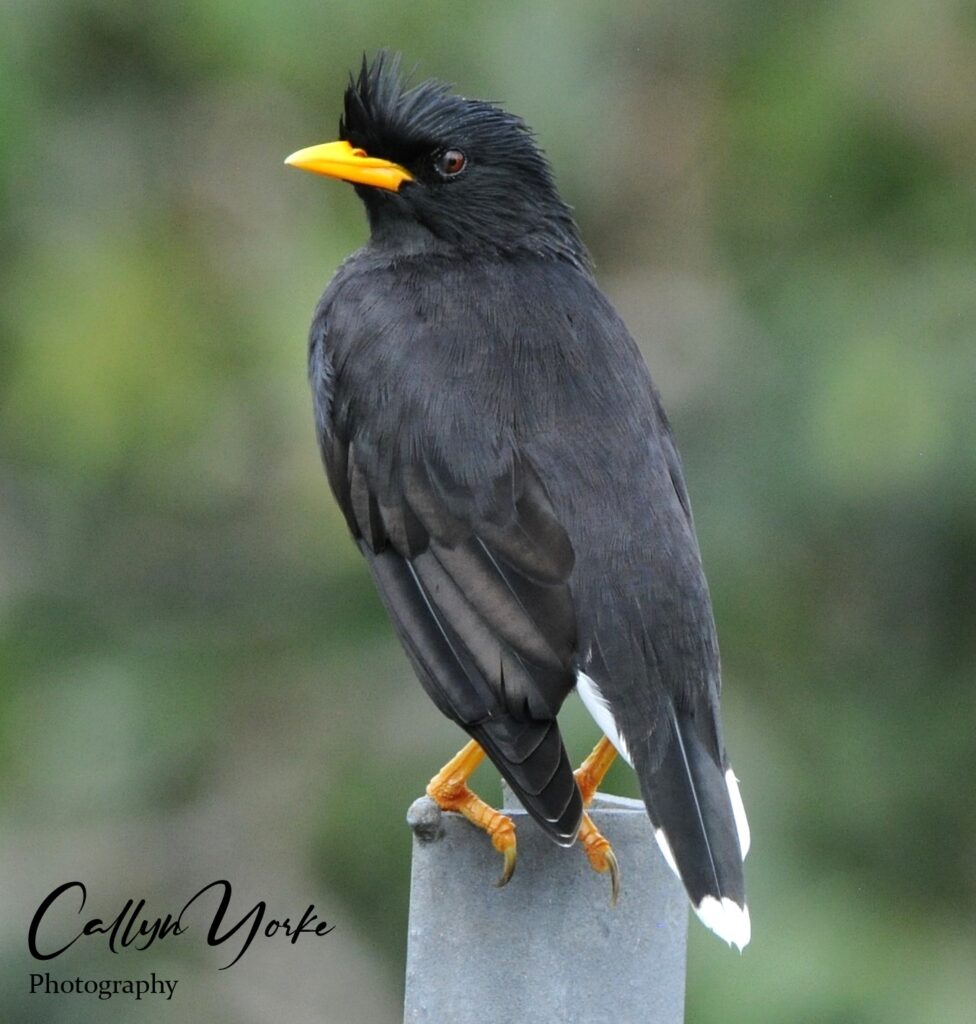
- White-shouldered Starling Sturnus sinensis 1 imm. perched in the same tree with flock of AGST, occasionally on an adjacent utility wire, for two consecutive days, UC, NYB
- Asian Glossy Starling Aplonis panayensis 25 (20% imm. ) vocal, greg. feeding with EUTS on shrine fruit offerings in the hotel lobby, C, NYB (photo – see Introduction)
- Oriental Magpie-robin Copsychus saularis 5 (m,f) vocal; a pair duetting — one answering with a single, repeated note; the other (presumably the male) giving a musical phrase, both birds concealed in dense shrubs about 5 m apart; foraging on ground, lawns and in low shrubs, C, NYB, SNP
- Yellow-vented Bulbul Pycnonotus goiavier 120 vocal, greg. in gardens and second-growth; large movements of birds in the mornings and evenings, 5-20m agl, presumably commuting to and from roost sites C, NYB, SNP (photo – see Introduction).
- Barn Swallow Hirundo rustica 30 (bsc. plmg. i.e. without elongated tail streamers) loosely gregarious, flying 3- 20 m agl around gardens and second-growth, C, ubiq.
- Pacific Swallow Hirundo tahitica 2 (possibly more; difficult to separate from BASW unless seen at close range, UC, NYB, SNP
- Arctic Warbler Phylloscopus borealis 1 (ID: conspicuous, long white supercilium ends before bill; ear-coverts with dark mottling, single, faint wing-bar, fine gray streaking on breast, relatively long tail); the bird was foraging quickly, ig, in leguminous trees adjacent to the hotel; (photo ID confirmed by Dave Sargeant) R, NYB (photo).
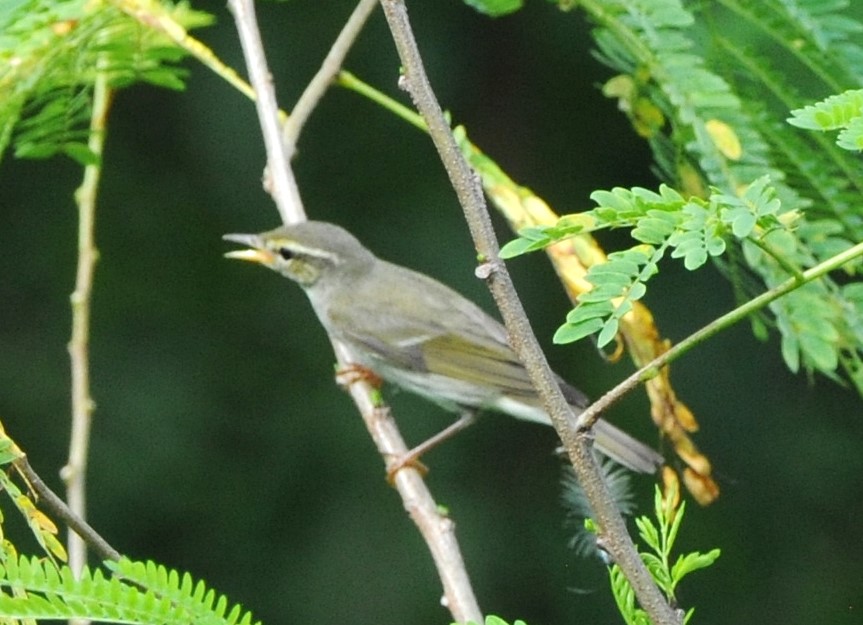
- Common Tailorbird Orthotomus sutorius 2 vocal (unseen) in dense undergrowth, gardens, C, NYB
- Eurasian Tree Sparrow Passer montanus 20 (m,f) vocal, greg., locally abundant, foraging on fruit offerings in shrine at the hotel, C, NYB
- Indian (House) Sparrow Passer indicus 1 (m) on ground in front of family convenience store, Highway 4031, Nai Yang Beach village, R, NYB
- Forest Wagtail Dendronanthus indicus 1 flushed from the edge of an uncut, partially flooded lawn, flew to shaded woods next to a small pond, R, SNP